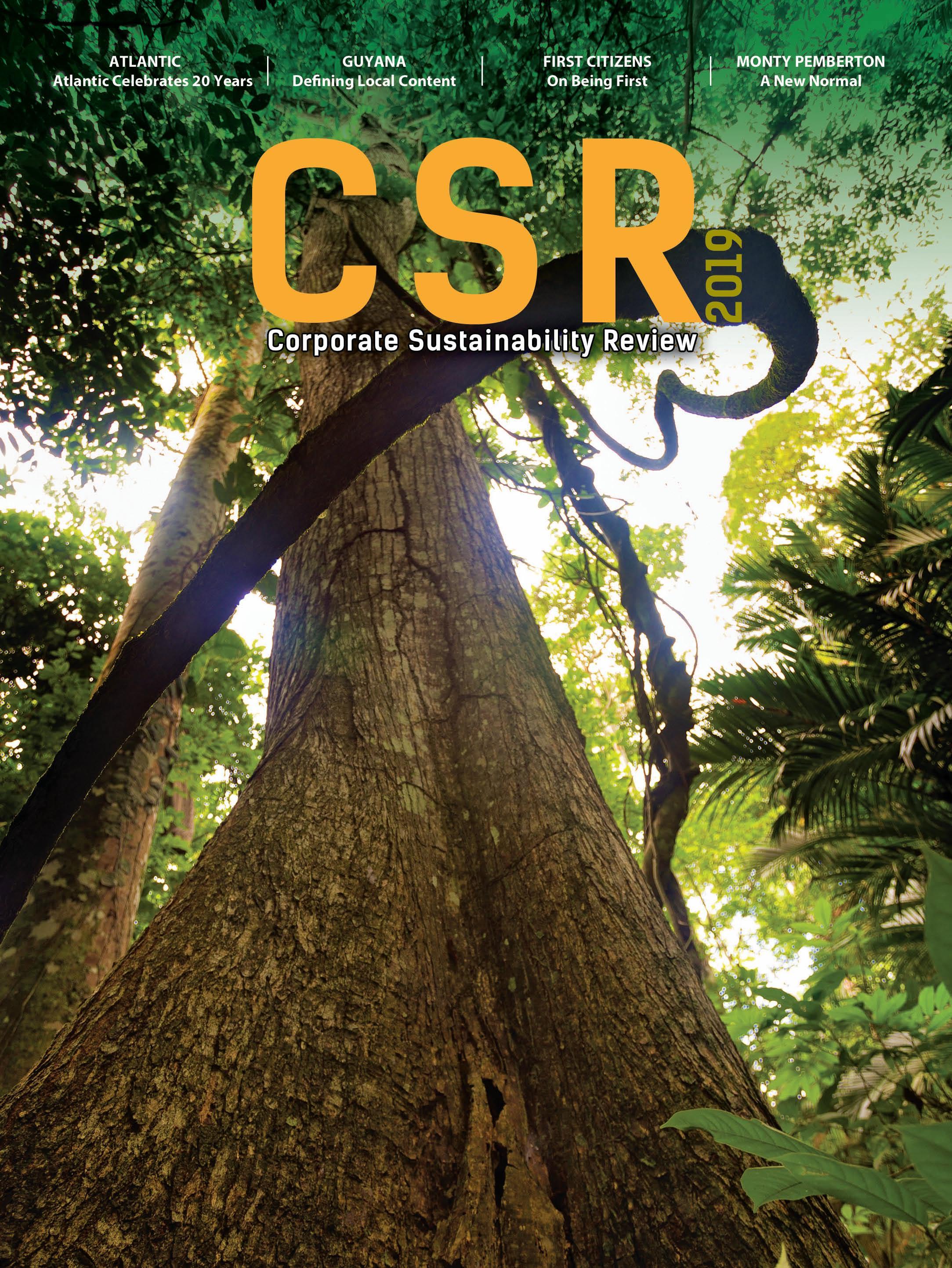

35 A FF o R dABL e And C L e A n e ne RGy In tH e CARIBB e A n
Public-Private Partnerships & The Ege Haina Experience
Wendy J. Singh
38 tHe PoWeR to CHAnGe LIVes Republic Bank Empowers Youth in Guyana
Donna P. Ramsammy
41 GRACeKennedy Gets on tRACK WItH tHe Un sUstAInABLe deVeLoPMent GoALs
The Grace & Staff Community Development Foundation
Wendy J. Singh
44 ReGIonAL RoUnd UP Caribbean Round Up - CSR Across the Region ConsCIoUs Ceo
48 Joel Montgomery “Monty” Pemberton Building a Mentorship Culture
Pat Ganase sPeCIAL
Corporate Sustainability Review 1 Contents editorial 3 Broadening the Scope of Local Content
Ramsammy CsR stories 5 AtLAntIC Moving a generation ahead Atlantic is 20 years and counting… 11 BPtt Realising The Value in Local Content How investing in education shapes local participation in the energy industry 14 FIRst CItIZens On Being First 18 MARItIMe Getting Strategic About Social Investment 21 nestLÉ With the Planet in Mind Nestlé aims for zero environmental impact by 2030 24 nGC Reconfiguring for Sustainability 26 sHeLL Shell Trinidad And Tobago Bringing Local Content to Communities CARIBB e A n Perspectives 29 exxonMobil - PARtneRInG on PRoGRess ExxonMobil’s Commitment to Guyana’s Sustainable Development
J. Arjoon
Donna P.
Lawrence
Local content
Local
Maximizing Participation Excerpts from the
and Tobago Participation Policy and Framework
by Guyanese Guyana’s Local Content Policy
seGMent
and CsR 53 Jemma Langley
Content Champion Pat Ganase 58
Trinidad
60 In Guyana
Interview with Dominic Gaskin – Director of Business
by Donna P. Ramsammy
by Bobby Gossai
Editor-in-Chief
Donna P. Ramsammy
Deputy Editor
Wendy Singh
Contributing Editor
Joann Carrington
Art Director
Lynn Designs Limited (868-789-0351)
Advertising
Virtually Yours T&T (VYTT)
Production Coordinator
Valery Marin
Photography
PIPS Photography
Photos for CSR stories supplied by the featured companys Shutterstock.com
The Corporate Sustainability Review features the unique social programmes and experiences of companies from a wide range of sectors including Energy, Finance, Manufacturing, Telecommunication Services, Retail and others as they strengthen communities and transform lives across the Caribbean region.

www.virtual-tt.com
Contributing Writers
Lawrence J. Arjoon
Joann M. Carrington
Robert Clarke
Jaysen Francis
Anjani Ganase
Pat Ganase
Michelle Palmer-Keizer
Donna P. Ramsammy
Kyle Santos
Wendy J. Singh
Publisher
Virtually Yours T&T Ltd
Francis Lau Street, Woodbrook, POS
Phone/Fax: 1-868-622-2663
Email: team@virtual-tt.com
Printers
Office Authority Ltd., Trinidad and Tobago
Contents
On the cover: Photo courtesy NGC
Understanding Local Content in Guyana and why it makes good business sense
2019 edition 65
A Local Content Policy for Guyana Maximizing Economic Benefits
68
oPI n I ons
Kyle santos Understanding Your Company’s Social Impact
saarah Khan The Circular Economy- Global Lessons for the Region 78 Michelle Palmer-Keizer Getting it Right-Developing Writing Tips for NGOs 81 Jaysen Francis Why Local Content and CSR Matters F e At UR e 83 tommy’s Brewing Company Change is Brewing
73
76
by Kyle Santos
Our theme for this edition is Local Content. On the threshold of First Oil, there is a lot coming out of Guyana in this special segment on the issue of Local Content. The country is feeling the pressure to deliver in two years what others have had decades to do; but Guyanese are quickly learning from the successes and failures of others. Interestingly, they are also setting a new model for Local Content, as the ultimate objective is to go beyond energy, to have a policy that transcends the sector. The Energy Department is also working to establish a Local Content Compliance Unit with oversight for the responsible management of the new oil industry.
While most businesses treat Local Content and Corporate Social Responsibility separately, the Review explores how often these two areas intersect. For many companies in the energy sector for example, Local Content Policies (LCPs) fit quite comfortably with Corporate Social Responsibility (CSR) policies as they are both purposed to promote and enhance local participation – either through direct inclusion in the management of resources; or by equipping communities through social investment initiatives to benefit indirectly from those resources.
As we will see in this edition, many companies focus social investment dollars on education. It certainly makes sense
for energy operators to invest in education when capacity building is so critical to meeting Local Content requirements. Training and development within companies to strengthen in-house capacity and training and education within the community to build capability is where we most often see those overlaps.
In our Regional Perspectives, we have stories from the Dominican Republic, Jamaica and Guyana. We’ve also introduced for the first time in this segment, ‘Regional Roundup’ to provide our expanding readership a broader glimpse of what companies and organisations are doing in various Caribbean territories.

GraceKennedy shares details of the Grace and Staff Community Development Foundation and Ege Haina in The Dominican Republic continues to do great work in renewable energy. We also checked in with ExxonMobil Guyana to look at its CSR. The imminence of First Oil also gave us an opportunity to examine the latest draft of Guyana’s Local Content Policy with Dominic Gaskin, Director in the Ministry of Business, and to understand how that will be influencing how operators build capacity for the country’s fledgling oil and gas industry. In keeping with our 2019 theme we invited Jemma Langley, Head of Secretariat at the Trinidad and Tobago Local Content Secretariat to provide her views on Local Content.
In this 2019 issue, our contributors in the Opinion columns explore some rather interesting topics. Saarah Khan writes on ‘The Circular Economy’, Kyle Santos on ‘Understanding your company’s social impact’, Michelle Palmer-Keizer gives readers tips on writing and evaluating a good CSR proposal and Jaysen Francis weighs in on Local Content. In this segment you will also see our local enterprise feature–Tommy’s Brewery.
This edition acknowledges the CEO of DeNovo Energy Limited, Monty Pemberton, as our conscious leader 2019; and from our Trinidad and Tobago companies come stories in sustainability, environmental care, local capability and strategic social investment. Atlantic marks 20 years of responsible governance and a sustainability agenda which aims to transform.
Donna P. Ramsammy EDITOR-IN-CHIEF
Corporate Sustainability Review 3 e d I to RIAL
Welcome to this bumper edition of the 2019 Corporate Sustainability Review as we continue to expand our coverage beyond Trinidad into other Caribbean countries.

CsR stories 5 AtLAntIC Moving a generation ahead Atlantic is 20 years and counting… 11 BPtt Realising The Value in Local Content How investing in education shapes local participation in the energy industry 14 FIRst CItIZens On Being First 18 MARItIMe Getting Strategic About Social Investment 21 nestLÉ With the Planet in Mind Nestlé aims for zero environmental impact by 2030 24 nGC Reconfiguring for Sustainability 26 sHeLL Shell Trinidad and Tobago Bringing Local Content to Communities
MoVI n G A G ene RAt I on AH e A d AtlAntiC iS 20 yeARS And Counting…
For 20 years, the Atlantic LNG Company of Trinidad and Tobago (Atlantic) has been one of the world’s largest producers of Liquefied Natural Gas (LNG). Atlantic produces LNG from natural gas at its four-train liquefaction facility in Point Fortin, on the south-west coast of Trinidad. It currently employs 567 persons on a permanent basis, of which 99% are nationals of Trinidad and Tobago. Additionally, approximately 1,000 contractors on average work for the company during peak periods to assist in the maintenance of the facility.
Strategic Relevance of Corporate Responsibility
Corporate responsibility, which Atlantic defines as ‘conducting its business responsibly and in accordance with its Core Values, and supporting local and national communities in a sustainable manner’, remains one of the business’ six strategic elements. This means Atlantic has incorporated corporate responsibility into daily activities and decision-making processes, sets itself targets and regularly assesses and reports on its performance in the area.
For the last 15 years, Atlantic has published annual Sustainability Reports to demonstrate how it has developed in an economically, environmentally and socially responsible way, while creating value for stakeholders and society. In so doing, Atlantic sets itself apart from many other companies operating in Trinidad and Tobago. Thus far, this history of public disclosure on corporate responsibility remains unmatched locally.
Atlantic’s Sustainability Commitment
Atlantic strives to achieve sustainable development within its sphere of control and aims to be a leader within
its sphere of influence by: Practising responsible
• environmental stewardship and minimising adverse impacts to the environment. Promoting the advancement
• of the local community through capacity-building, education, social progress and the creation of business opportunities.
Enabling employees by • investing in their potential and using their capacities as agents of change.
its targets and keeping its promises. For example, Atlantic has placed significant focus on its relationship with suppliers. It has given itself a mandate to contribute to the longerterm development of these suppliers through capacity building and by requiring them to meet exacting social, environmental and quality standards. In so doing, it is increasing these suppliers’ value to the oil and gas industry and economy as a whole.
20 Years of Community Development
Strengthening suppliers
• by setting high social, environmental and quality standards along the supply chain and developing their capacities.
• on regional, national and global levels to achieve common objectives for a better future.
Building strong partnerships
This commitment obliges the company to engage with its stakeholders, be accountable to its shareholders and to disclose publicly if it is achieving
Atlantic accepts its role in society goes beyond being a significant contributor to the economy. Nowhere is this more important than its home community of Point Fortin, where Atlantic uses its financial resources and employees’ time and talent to support sustainable growth and economic development. Beyond its home community, the business actively engages with its stakeholders in the areas of sport, education, local economic development and the environment.
Sport
The transformational power of sport allows for programmes which aim to inspire young people to be more active
Corporate Sustainability Review 5
CsR stories
and take ownership of their own physical well-being, while at the same time developing the positive attitudes, behaviours and life skills critical to the development of young people.
Atlantic’s Commitment to Sport
Atlantic has provided financial support and partnered with various organisations to deliver programmes for young people including primary school swimming, tennis, cricket, football and track and field. For example:

Atlantic has partnered with six of Trinidad and • Tobago’s brightest sporting talents in an effort to motivate children and encourage them in their own pursuit of sporting and personal excellence.
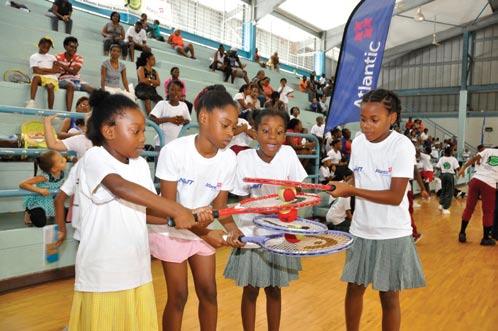
Since 2011, Atlantic has partnered with the Real • Madrid Foundation, to offer football and life skills development to boys and girls from the ages of 7-14, via the Atlantic Real Madrid Foundation Social Sports School.
For over a decade Atlantic has sponsored primary
• schools’ cricket and football leagues, which are organised by the National Primary Schools’ Cricket and Football Boards respectively, under the auspices of the Ministry of Education.
Atlantic’s partnership with the National Primary Schools’
• Track and Field Association enables them to facilitate the development of track and field amongst primary school students through a series of zonal and district meets, a nationwide three-kilometre race and a oneday championship event.
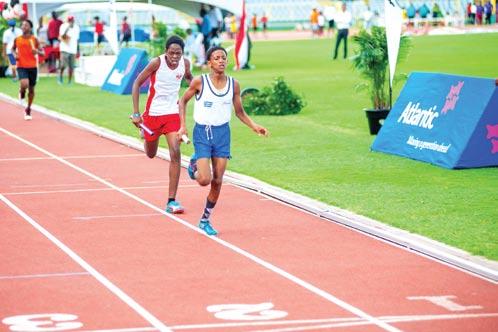
Tennis and swimming programmes have also been
• developed to support students from primary schools in Point Fortin and beyond.
The Atlantic Coaching Excellence (ACE) Programme was
• created in response to the need to build the capacity of primary school coaches. It provides an avenue for these coaches to be professionally certified to coach young children, thus ensuring a high level of technical ability, as well as an understanding of the non-technical requirements of junior coaching.
In 2018 alone, over 15,000 children across the country participated in sporting initiatives supported by Atlantic.
Cricket • – 5,600 children

Football • – 4,800 children from 331 schools

Community Sports
• – 4,100 children
Track and Field • – 1,030 children from over 400 schools

6 Corporate Sustainability Review MoVInG A GeneRAtIon AHeAd – AtlAntiC iS 20 yeARS And Counting… (continued)
Training for competitive swimming. Practice makes perfect for these tennis starlets. Boys 7-14 master football and life skills.
Budding Batswomen. Two boys complete a relay during track and field training session.
Track and Field athletes gear up for competition.
CsR stories
Education
Access to education and skills training is critical to development. As a result, Atlantic’s partnerships in this area, such as the National Energy Skills Centre (NESC) Skills Training Programme, are designed to address local needs and interests. These include both traditional and non-traditional paths, recognising that technical and vocational skills training create opportunities for young people to access employment. Atlantic’s focus on education and skills development is also evident within the business. Almost 500 people have benefitted from its apprenticeship, internship, operator trainee and marine trainee programmes since their introduction.
Point Fortin’s Finest Leadership Development Programme
Since 2000, Atlantic has awarded annual grants to the top ten Secondary Entrance Assessment (SEA) students from the primary schools within the Point Fortin school zone. These grants help to cover the cost of students’ secondary school and university education.

An important component of this programme is the Point Fortin’s Finest ‘World of Work’ initiative, which involves an annual school vacation internship at Atlantic, and developmental camps aimed at strengthening students’ life, leadership and teamwork skills. A recently added mentoring element matches junior participants with advanced students so they can benefit from the experiences of those who have already made their way through the programme.

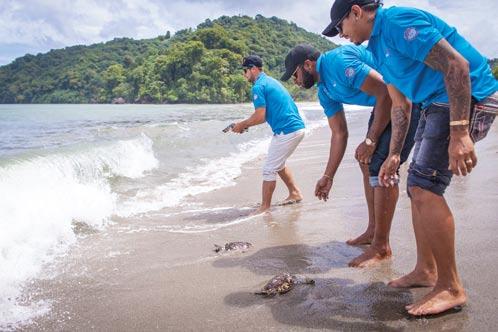
Progress to date:
Local Economic Development

199
• – Participants since 2000
80
• – Students who have graduated with university degrees
Atlantic has a long history of supporting programmes aimed at improving livelihoods and fostering socio-economic growth in its home community. This is achieved by equipping residents with the resources necessary to take greater ownership of their community’s development.

Corporate Sustainability Review 7 MoVInG A GeneRAtIon AHeAd – AtlAntiC iS 20 yeARS And Counting… (continued)
Atlantic Sports Ambassadors ensure baby turtles get to sea following the annual nesting season.
Point Fortin’s Finest participants share a light moment with Atlantic’s CEO.
Point Fortin youth receive complementary skills training.
LEND – Promoting MSMEs in the South-West Peninsula.
MSMEs in Agriculture.
CsR stories
CsR stories
Building Entrepreneurship through LEND (Loan for Enterprise and Network Development)
Based on a study conducted in Point Fortin, it was recognized that the majority of business owners considered access to funding as the major challenge to expanding their business and fostering entrepreneurship. In 2014 the Loan for Enterprise and Network Development (LEND) micro-financing agency was established, focusing on micro, small and medium enterprises (MSMEs) and entrepreneurs in the south-west peninsula of Trinidad.

Among LEND’s objectives are:
Promote and assist the establishment and development of MSMEs in an effort to increase local economic
activity.
Raise, mobilise, borrow and procure capital and finance to provide loans and guarantees for MSMEs and
entrepreneurs.
Identify and disseminate information on business opportunities to generate employment, make use of local
materials and skills or otherwise contribute to local expertise.

Facilitate the provision of, and enable access to appropriate skills training to support the economic
development of the communities.
Progress to date:
454 • - Total loans issued
Environment
• – Value of loans issued
TT$11.7 million
Atlantic’s focus on the environment is based on an understanding that natural resources are finite, and that as a large energy intensive business, it has a responsibility to manage these resources prudently. To this end it has invested heavily in reducing the impacts of its operations and supporting environmental conservation, awareness raising and youth empowerment efforts. Apart from its conservation efforts with the local turtle population, the company has been focusing on educating our young ones about environmental protection. The Atlantic Environment Education Series engages children within primary schools to ensure that respect for the environment is fostered at a young age.
Over the last 20 years Atlantic has been amongst the leaders demonstrating how the private sector should engage and support its suppliers, ensure the health and safety of staff, measure and report on progress, contribute to local communities and support the preservation of our natural environment. The company has made substantial progress towards its goal of moving a generation ahead.
8 Corporate Sustainability Review
•
•
•
•
These children are planting trees to promote respect for the environment.
Close to nature, these primary school students are the next generation of environmental stewards.
MoVInG A GeneRAtIon AHeAd – AtlAntiC iS 20 yeARS And Counting… (continued)
The Atlantic Environment Education Series
In 2014, Atlantic partnered with the Fondes Amandes Community Reforestation Programme to develop the Atlantic Environment Education Series. Since its inception, 1,880 students from nine primary schools each school term have been taken on field trips where they received hands-on knowledge of the critical need to conserve and protect biodiversity from the threats of climate change, deforestation and forest fires.
These schools were selected based on their location in communities which are affected by fires and floods, and their ability to impact (or be impacted by) their local watershed.

Much of what the students learn on these field trips correlates with the Primary Schools’ Social Studies Curriculum, thus complementing and reinforcing what is taught in the classroom. In addition to these handson experiences, participants are given guidance on how they can help to create environmental awareness in their schools, communities and homes.
3 yr. performance data:

Corporate Sustainability Review 9
Youngsters at play on an Atlantic Field Trip.
CsR stories MoVInG A GeneRAtIon AHeAd – AtlAntiC iS 20 yeARS And Counting… (continued) Measure of Performance Unit of Measure 2018 2017 2016 Tax Contributions Corporation Tax mn US$ $ 234.2 $ 218.6 $ 215.4 Green Fund Levy $ 8.9 $ 6.3 $ 5.0 Witholding Tax $ 8.3 $ 6.2 $ 7.3 Total $ 251.4 $ 231.1 $ 227.7 Employee and Supplier Development Total employess # 567 621 706 Staff salaries and benefits* mn US$ $ 55.7 $ 60.7 $ 66.6 Training and development spend $ 0.5 $ 0.8 $ 0.5 Local suppliers supported # 537 542 538 Spend on local suppliers mn US$ $ 115.4 $ 100.3 $ 144.0 Community Investment Sports US$ $ 660,230 $ 699,999 $ 651,784 Education $ 193,410 $ 216,585 $ 215,951 Local Economic Development $ 257,756 $ 407,069 $ 172,674 Environment $ 172,683 $ 122,855 $ 171,683 Other community contributions $ 498,812 $ 582,544 $ 457,703 Total $1,782,891 $2,029,052 $1,669,795 * Staff salaries and benefits includes PAYE.
Getting in touch with nature.

Re ALI s I n G tH e VALU e I n Lo CAL Content
Sustainability is at the core of BP’s strategy in Trinidad and Tobago. The long-term sustainability and prosperity of the business in Trinidad and Tobago is dependent on our ability to create value for both the company, the country and the communities where we operate. For us, this means much more than simply providing broad economic benefits through the extraction of oil and gas and the payment of taxes. According to BP Group’s chief executive officer, Bob Dudley, it means “aligning our interests with those of local economies by using local suppliers, building local capacity and supporting local communities that is, by developing and promoting local content.”
BP Trinidad and Tobago (BPTT) understands that by developing local content, we are actually creating and maximizing shared value for both the company and country. Utilising local suppliers can help to reduce operational costs; building local capacity can help to create better employment opportunities for nationals; and supporting local communities can help to improve the quality of life of residents while also securing our licence to operate. Developing local content therefore, is a strategic imperative.

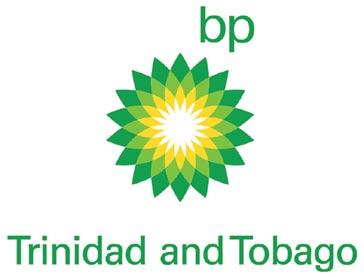
BPTT’s local content strategy governs the company’s approach to local content development. The strategy has five key focus areas:
1.
Capacity building and technology transfer;
2. entities in the sector;
Participation of Trinidadians and locally owned
3. and services;
Procurement and usage of locally produced goods
4. socio-economic responsibilities (CSR).
Fabrication and manufacturing in-country and
We have made several strides in developing local content in Trinidad and Tobago.
Underpinning the success of the strategy has been our social investments in education that have helped to build capacity (human capital development), and transfer technology to nationals. This increases local participation in the energy sector and other areas of the economy. Education provision proved to be a critical driver in local content development due to the gap between the skills and capability already existing in country and what was needed in the energy
sector. However, while there was an immediate and urgent need to satisfy the demands for technical skills both in the onshore and offshore energy industry, given the long-term nature of our business, BPTT has made strategic interventions at every level of the education sector aimed at creating a globally competitive talent pipeline for the energy industry and beyond it.
BPTT has helped to transform the education landscape in its host community of Mayaro - home to the company’s two onshore operating sites. We introduced the Brighter Prospects Scholarship and A’level award programme to aid Mayaro students in their pursuit of higher education at accredited institutions in Trinidad and regionally. The scholarship assists students with travel, rent, books and food expenses for the duration of their education programme.
Corporate Sustainability Review 11
How inveSting in eduCAtion SHApeS loCAl pARtiCipAtion in tHe eneRgy induStRy
CsR stories
Claire Fitzpatrick, Regional President of BPTT, (right) hands over a cheque valued at 1MTTD to Professor Andrew Jupiter (left) in support of the UWI Geoscience Programme.
Sixteen years later, more than 550 students have received scholarships. Students performance shows a 96% success rate.
Recognizing that the energy sector only employs around 4% of the labour force, BPTT’s Brighter Prospects scholars are free to pursue any field of study at the tertiary level. Our Brighter Prospects graduates can be found working in all sectors of the economy. For example, whereas BPTT has directly benefitted from employing engineering graduates, hospitals have gained doctors and nurses, schools have gained teachers, the judicial system, lawyers. The Brighter Prospects programme is contributing to the sustainability of the broader socio-economic fabric of the country and this is critical to the long-term sustainability of BP in Trinidad and Tobago.
Vocational skills are also in high demand in energy sector, especially offshore and in other arenas. Cognizant of this, BPTT has established relationships with local organisations in Mayaro to provide residents with certification training in various vocations including but not limited to rigging and lifting, banksman/slinger, painter/blaster, scaffolding and fire watcher. Specialised offshore safety training is also offered. Hundreds of Mayaro residents benefit from these types of training annually. A special partnership with the Kenson School of Production in 2013, has produced graduates with the advanced diploma in Oil and Gas Process Technician and Instrumentation certification. This has led to the progressive nationalization of the offshore workforce as hundreds of persons have been able to gain certification and employment at BPTT’s and other offshore facilities and in other industries in Trinidad and abroad.
At the national level we are exceedingly proud of our longstanding partnership with the University of the West Indies (UWI). In response to the dearth of geoscientist globally and nationally, in the early 2000s BPTT and a consortium of its energy partners alongside the UWI created the Petroleum Geoscience Programme. The company has invested millions of dollars in the programme over the last 17 years in support of developing human and technical resources, research and development (R&D) and scholarships. Critical to the success of the programme is the facilitation of the transfer of knowledge from the company to the university. BPTT employees provide curriculum input and course instruction, ensuring that the programme keeps abreast of the latest developments and standards in geoscience globally. Students are also able to pursue internships at BPTT where they gain work experience and exposure to the latest technology while completing their final year projects. The programme has produced hundreds of graduates some of whom work locally at the Ministry of Energy and Energy Industries, BPTT and other energy companies in Trinidad, and internationally.

While local content is defined by the employment of local citizens, local resources and materials, BPTT’s approach has been to invest in the training and education that ensures a competitive domestic supply of local labour for the local and international energy sector. More importantly, the company is equipping nationals to be able to provide the resources, materials and services that would otherwise be externally sourced. BPTT’s approach takes an optimal view of Local Content policy and delivery.

12 Corporate Sustainability Review
ReALIsInG tHe VALUe In LoCAL Content (continued)
CsR stories
Valedictorian, Amanda Mahadeo, shares a funny anecdote during the graduation ceremony for BP Trinidad and Tobago’s Brighter Prospects scholarship programme.


o n B e I n G F IR st
It’s the financial services group that likes to be first, even when picking its opportunities for CSR spending.
First Citizens has recently been at the front of the line in providing a wider audience for Spoken Word poets; first in offering real-world work experience to UWI Computing and IT students; and first in supplying teenage girls with some of the skills they’ll need as independent women.
Poetry Slam
As the packed NAPA auditorium hummed with expectation in May 2019, 16 First Citizens National Poetry Slam finalists squirmed on stage, awaiting the coronation of a new Slam Champion.
Poet, Isaiah Wayne John, had earlier performed a piece about the dignity of his mother, who “even though she’s struggling, still makes it look like she’s strong in your eyes.” Former winner, Idrees Saleem, acknowledged that he’d be surprised if he placed, but was more concerned about giving his all, having a say, and leaving the audience with a message anyway.
Spoken Word performance has come a long way from its early days at the University of the West Indies, St Augustine campus, where every third Wednesday, a few poets gathered outside a fast food restaurant to grouse, extol and express at UWI Speak’s open mic night. In a way, they were a new wave of calypsonians, responding to society through commentary.
In 2013, First Citizens partnered with the 2 Cents Movement, an NGO founded on the principle of critical thinking, which was expanding the reach of Spoken Word by taking it to schools
and eventually to the big NAPA stage. “Having that first corporate investment allowed us to feel a certain sense of value,” says Derron Sandy, 2 Cents Movement’s Artistic Director, “that people were now looking on and we had the attention of a wider circle other than our peers.”
The circle has widened. The National Poetry Slam finals is one of three annual NAPA events that is expected to pack the house, which shrieked in 2019 when Alexandra Stewart was announced as Slam Champion.

Stewart had come through the ranks, from a 2014 Two Cents Movement school workshop, through the secondary schools’ competition and finally to the national stage. “She is a prime example of somebody interacting with Spoken Word and growing through it,” says Sandy. “Similar to like if you were to grow through a cadets programme or something.”
Interviewed after the show, cradling her $50,000 cheque replica under one arm, Alexandra grabbed the mic. Wideeyed and beaming, she looked into the camera and expressed herself once more. “This is the first time our women took first, second and third place!” she trumpeted. “And that is incredible!”
14 Corporate Sustainability Review
CsR stories
Shenique Saunders copped second at the First Citizens National Poetry Slam final.
“I was in a forum answering a question on what is the biggest fear of the performing artiste, and the answer to that was having nobody to perform to. Obviously I think the wider you reach, the more satisfying your craft becomes because you want people to hear and engage with your work.”


The UWI-First Citizens Interns
In 2017, an intake of 15 interns from UWI’s Department of Computing and Information Technology (DCIT) gathered with First Citizens managers and a few university lecturers for a brainstorming session. The university had launched its first internship program, and First Citizens had jumped on board.

It was immediately apparent that there would be no shortage of real-world tasks for the interns. One manager wanted a system for tracking opportunities for outdoor marketing. Another hoped for a simple app to track the progress of industrial relations concerns. And a third wanted a portal to access current budget data for his department.
UWI lecturers were pleased that their students, most of them Year Two undergraduates, were being exposed to the expectations of a professional workplace. “The discipline it engenders was good for them,” says Dr. Permanand Mohan,
Head of UWI’s DCIT. “First Citizens was the first to give us a chance to implement that internship. That was a big start.”
Some of the software developed in the 2017 DCIT internship is still in use at First Citizens; and several interns have been hired for permanent and contract work. Dr. Mohan says his department is yet to undertake a study to examine the benefits of internship, but based on student feedback, interns appreciate the experience, which counts as a twocourse credit. Several have reapplied after their first go.
“The greatest benefit is to explore and even forge your career path,” said intern Darcelle Modeste. After returning to school, Rhequimo Leslie credited the program with improving his work ethic – one of the obvious benefits of any internship – and allowing him to perfect the skills he had learned at school.
Corporate Sustainability Review 15
Derron Sandy, Artistic Director of 2 Cents Movement, organisers of First Citizens National Poetry Slam Competition
Alexandra Stewart hailed women as the victors after being adjudged Slam Champion.
on BeInG FIRst (continued) CsR stories
Girls First
After analyzing the outcomes of their annual Women’s Conference, First Citizens decided that they wanted to focus on girls and female adolescents. “We wanted to prepare them for their lives as strong, independent and successful women and mothers,” says Larry Olton, Head of Brand and Marketing.
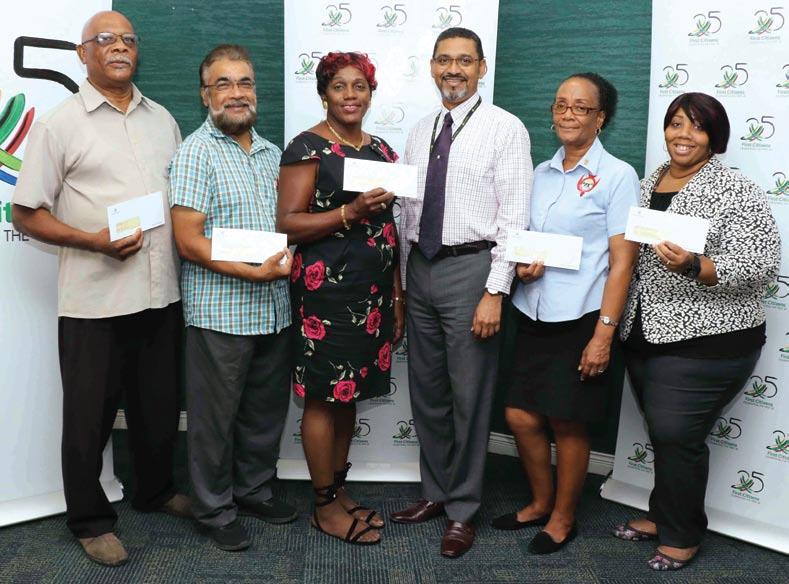
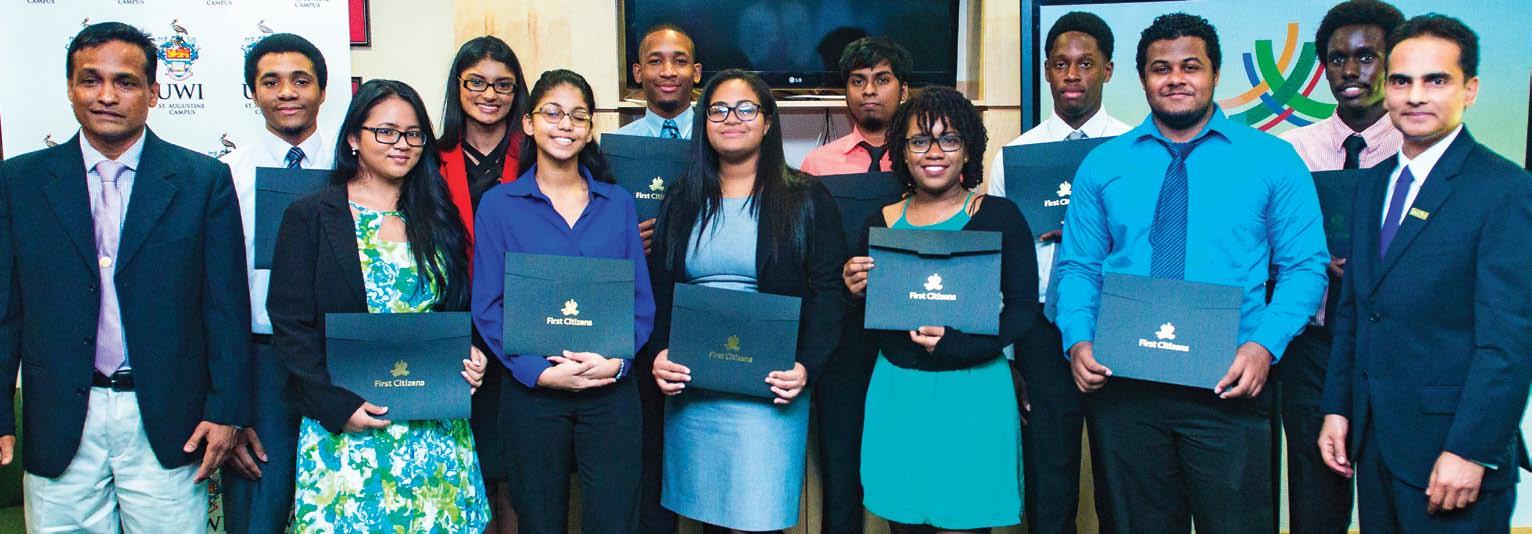

Girls First was the forum they came up with, gathering 13 to 18-year-olds in a space where professionals could engender a spirit of sisterhood, resilience and selfesteem. The girls are encouraged to stretch themselves – mentally with budgeting and finance training, and physically with self-defense techniques. They are also exposed to Health and Wellness education.
And the Girls First forum keeps on giving even after it’s over. Registration proceeds are donated to NGOs, most of which cater to the needs of girls in their communities.

16 Corporate Sustainability Review
The 2017 Department of Computing and Information Technology interns were asked to generate software solutions for First Citizens managers.
Larry Olton, Head of Brand and Marketing (4th from left), presents Girls First donations to (l-r): Don Robertson, Joshua home for Boys; Shaheed Mohammed, Islamic Home for Children; Susan Phillips-Jack, Sylphil Home in Love; Lenore Henry, Vision of Hope, and Dale Bartholomew, Credo Foundation.
The First Citizens/UWI internship partnership has continued since 2017 and been expanded to include Management Studies students as well.
“It’s showing we can produce students who can go out there and do something useful for the companies and the country.”
on BeInG FIRst (continued)
Dr. Permanand Mohan, Head of Department, Computing and Information Technology, UWI
CsR stories

Gett I n G st RAteGIC AB o U t so CIAL I n V est M ent
For over half a century, The Maritime Financial Group (Maritime) has been a prominent player in Trinidad and Tobago’s financial services sector. Its head office, located just a few miles outside of Port of Spain, is a well-established landmark for those travelling to and from the capital city. Now, following the overhaul of its approach to CSR, Maritime hopes to be known for more than insurance and its head office.

In late 2018, Maritime stopped using the term CSR to refer to its environmental, social and governance initiatives, instead aggregating these under the banner of Responsible Business. Central to this is a deliberate effort to go beyond the philanthropic model most commonly associated with CSR in Trinidad and Tobago. This seems appropriate; the World Business Council for Sustainable Development (WBCSD) defines CSR as ‘the continuing commitment by business to behave ethically and contribute to economic development while improving the quality of life of the workforce and their families as well as of the local community and society at large’.
In the words of CEO Andrew Ferguson, “In the local market, the term CSR holds a certain connotation. We primarily think of CSR as philanthropy or charitable giving. Certainly, these are important aspects of companies’ CSR, but corporate responsibility is much bigger than this. By using the term “Responsible Business”, Maritime wants to make it clear that we understand that in order to be a good corporate citizen, we have to be accountable to a broad range of stakeholders on a range of economic, social and environmental issues. These stakeholders include shareholders, staff, clients, suppliers, local communities and NGOs to name a few. In the future we will be focusing much of our efforts on building capacity in organisations and people, to help them grow, as we see this as critical to creating lasting and sustainable change for future generations.”
In line with this definition, Maritime has premised its Responsible Business activities on:
• Providing top class service to clients;
• Conducting business ethically;
• Aiming to be the employer of choice;
• Satisfying shareholder expectations;
• Compliance with environmental standards; and
• Making investments which enable young people to thrive.

Despite these changes, Maritime has not completely abandoned the philanthropic model of CSR. After all, what would happen to all the previous beneficiaries of its charitable donations? Instead, Maritime has gotten more focused and strategic, as evidenced by its new Social Investment Strategy – Our Children, Our Future. Maritime has committed to improving the lives of children in Trinidad and Tobago, by building capacity in organisations and people, helping them secure brighter futures for themselves and the next generation. Its activities are targeted in four areas:
1. Education and youth development: ensuring young people have the tools they need to succeed
2. Crime and violence: creating safe spaces for young people to live, learn and play
3. Disaster preparedness and response: building resilient homes and schools
4. Pollution and recycling: preserving a healthy planet for the generations to come
18 Corporate Sustainability Review
stories
Maritime Team Members at the 2018 Run For Fun Charity Fair and 5K, an annual event that raises money for Maritime’s “Our Children, Our Future” initiative.
CsR
An example of Maritime’s work in this final area is its support of SpeSeas, a group of local scientists, conservationists, and communicators who wish to make positive changes to the way we use and manage the marine environment for future generations.
Coral reefs and their importance are “out of sight out of mind;” we know very little about our marine environment.
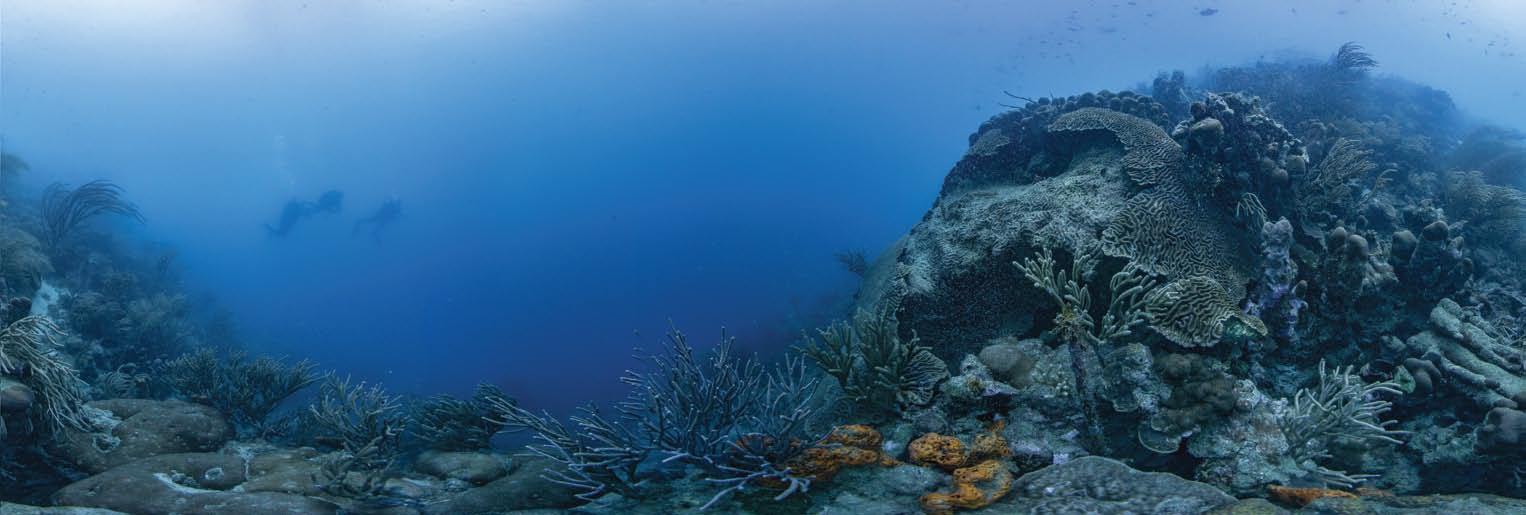
Coral reefs provide employment for coastal communities and contribute as much as 45% of Tobago’s GDP through tourism. That is without considering the value of other vital services, such as protecting coastlines against storm surge, maintaining fish stocks, and cultural resonance to name a few (Burke et al. 2008). The impacts of climate change are already being felt by small island nations globally and there is a risk that coral reefs and their services will continue to degrade to a point where they are no longer able to support the livelihoods of those that depend on them.
The Maritime Ocean Collection Project - a partnership between Maritime, SpeSeas and the international agency Underwater Earth - aims to reveal Tobago’s coral reefs to the world using engaging imagery and innovative technology.

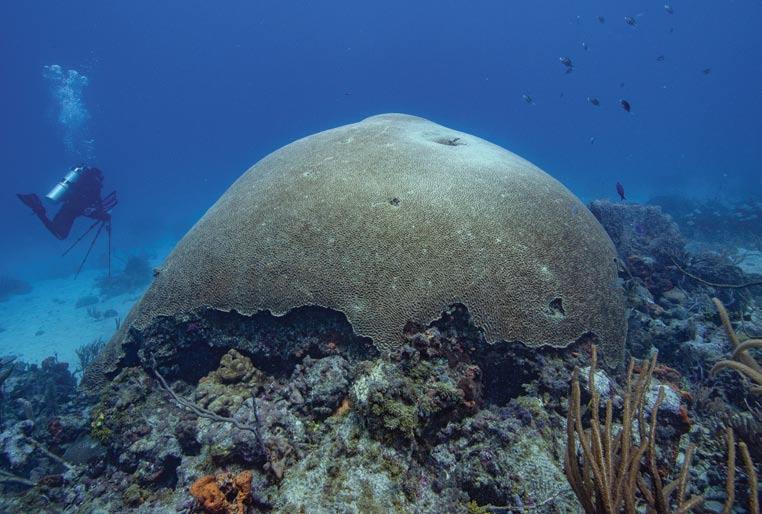
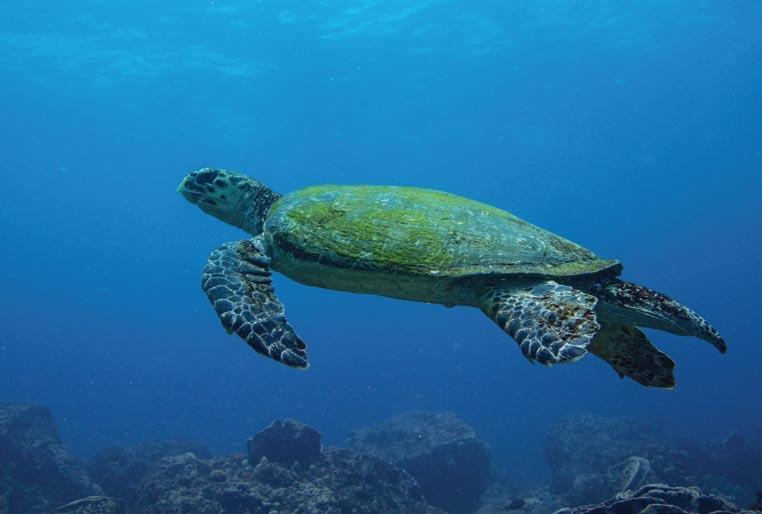
The Collection will be the first online library of photos and videos, showcasing never before seen coral reef scapes
and underwater life. These will be captured in 360-degree imagery and educational videos, all for the purpose of engaging and inspiring citizens of Trinidad and Tobago. The Collection will give a glimpse into the diversity and beauty of our coral reefs and marine life; highlight the damage caused by human activities; and sensitise the next generation for a better relationship with the ocean. This imaginative new world will inspire the children of Trinidad and Tobago, enlarging their capacity for innovation, resilience and adaptation above the water as well as below the waves.
The Collection will serve as a visual record for Tobago’s coral reefs in 2019. SpeSeas, the operators of the project, has collaborated with the Institute of Marine Affairs (IMA), and worked with local NGOs and dive tour operators to carry out the surveys. With Maritime’s participation, SpeSeas expects that this project will stimulate a sense of responsibility towards the marine environment, and generate more sustainable approaches to ocean conservation and use of coral reefs.
Corporate Sustainability Review 19
ANGEL REEF is located in Speyside on the sheltered side of Goat Island. This reef teems with fish and coral life and is a popular dive destination in northeast Tobago. Photo by Anjani Ganase | The Maritime Ocean Collection.
Adult male hawksbill at Divers Dream, a shallow coral reef bank located of the south end of Tobago.
Photo by Jonathan Gomez | The Institute of Marine Affairs
One of the largest brain corals in the world found at Kelleston Drain, Speyside.
Photo by Jonathan Gomez | The Institute of Marine Affairs
GettInG stRAteGIC ABoUt soCIAL InVestMent (continued)
CsR stories
Maritime has a call to action for businesses throughout the country.

“The children of Trinidad and Tobago are its future. It is imperative they be given the skills, experiences and opportunities to succeed if our country is to overcome its challenges and ensure a thriving society and healthy environment for generations to come. Maritime is committed to using its resources and relationships
to build the connections that make it possible for the children of today to grow together, and become the responsible leaders of tomorrow. We thank our team members for helping us achieve this, and ask our clients, local communities and suppliers to join with us to create a brighter future.”
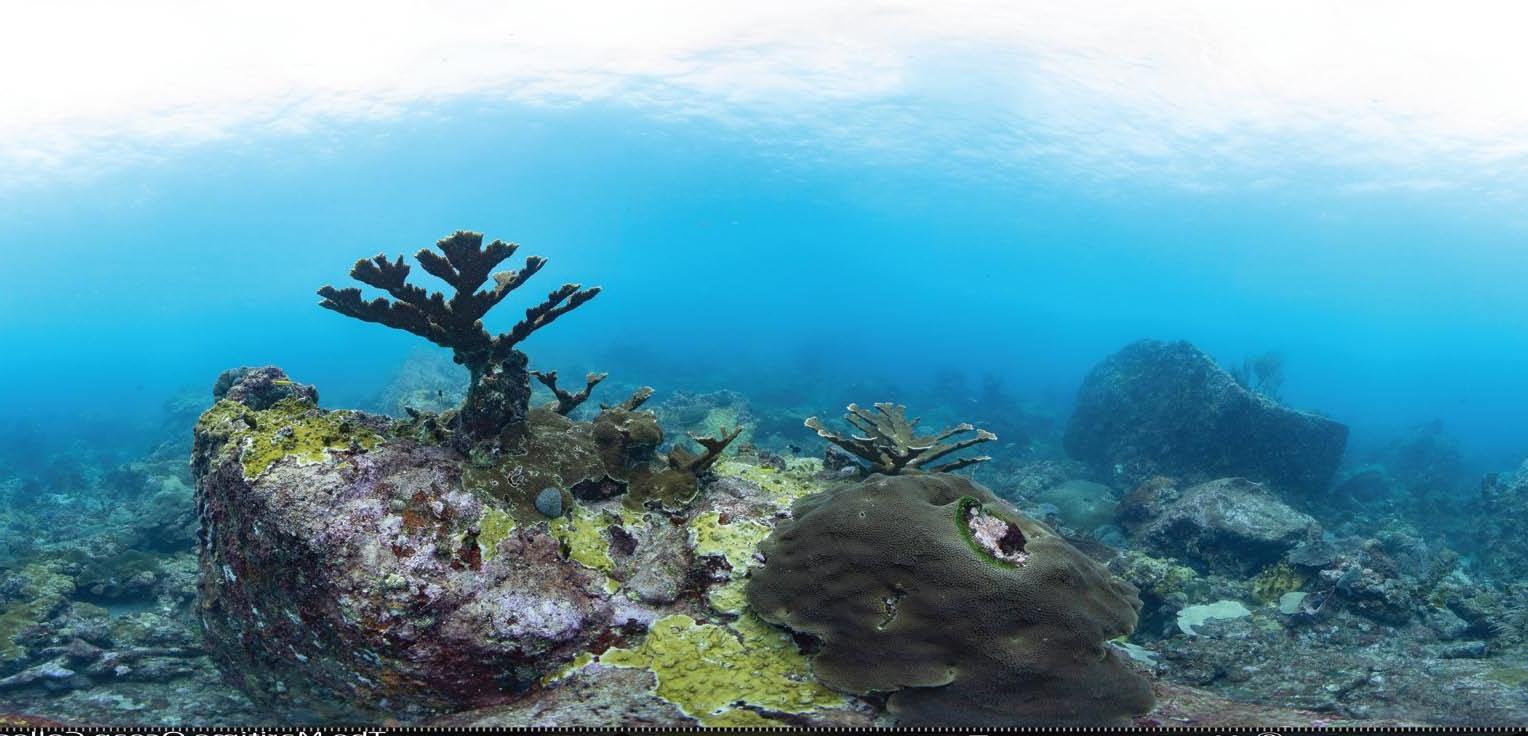
20 Corporate Sustainability Review
BREAKFAST BAY REEF in Charlotteville consists of sunken rocks and boulders that provide an ideal surface for corals to grow.
Photo by Anjani Ganase | The Maritime Ocean Collection.
GettInG
Metric Data Organisations Supported (this figure includes individuals who were supported directly by Maritime) 70 Financial Contributions $ 175,000 In-Kind Donations $ 132,000 Volunteering Hours 695 Our Contributions in 2018 The following illustrations indicate Maritime’s social investments in 2018 Types of Organisations Supported 3% 6% 7% 30% 51% 3% Public Sector Bodies Faith Based Organisations Private Sector Bodies Individuals Schools and Educational Institutions NGO, CSOs and Community Groups CsR stories
stRAteGIC ABoUt soCIAL InVestMent (continued)
In October of 2018, the Trinidad and Tobago Manufacturing Association awarded Nestlé winner of the prestigious Green Manufacturer of the Year Award, recognising the company for its leadership role in the employment of green technologies in manufacturing and its success in positively contributing to the sustainability of both the environment and Trinidad and Tobago. The win is hardly surprising as Nestlé was the first company in the Caribbean to install an Effluent Waste Water Treatment Plant at its factory in Valsayn back in the 1980s, reflecting its long term commitment to environmental sustainability.
Since then Nestlé has made significant strides in how the company interacts with and protects the natural environment. Nestlé’s attention to environmental preservation and responsible management of scare resources is integral to its operations. Nestlé employees are committed to continuous improvement in operational efficiencies and they collaborate with and encourage customers in initiatives that foster environmental awareness.
The company’s environmental management system identifies all areas of Nestlé’s impact on the environment — and responsive programmes and activities are developed and implemented to manage and mitigate all such impacts.
Nestlé’s environmental stewardship spans the Anglo-Dutch Caribbean region, and falls under a stated commitment — “For the Planet” — with activities in five key areas:
- Managing Waste
- Managing Energy Usage
- Minimizing Greenhouse Gas Emissions
- Achieving Water Efficiency and Sustainability
- Changing Behaviours
Managing Waste: Nestlé is on target to achieve ZERO Waste to Landfill by 2021: In 2018, its Jamaica distribution centre achieved zero waste to landfill and 90% of the packaging used on the Trinidad compound was sent for recycling.
Among the company’s waste management programmes is a recycling programme that reduces waste-to-landfill by compacting Tetra Pak, PET and cardboard waste using specialised equipment at the factory site; the waste is then
collected by a specialist recycler for reprocessing. Recycled Tetra Pak material is used for a variety of applications from household items to roofing materials.
The implementation of a new Sludge Belt Press Filter in Trinidad in 2016 has also led to a drastic 46% reduction in waste to landfill. Everything is put to good use: Sludge waste is transformed into fertiliser and used by the local dairy farms that provide Nestlé with fresh milk daily, while other liquid waste is provided to local pig farmers as feed for their animals in Nestlé’s Animal Feeding programme.
These large-scale environmental initiatives are complemented by a number of smaller programmes which combine to make a significant difference, ranging from internal recycling programmes for employee waste management and composting programmes for on-site canteens, to the elimination of single-use plastics from all areas of operations, including marketing events and staff services operations.
Managing Energy Usage: Nestlé measures and monitors its energy usage on a continuous basis, with the goal of achieving year-on-year reductions via specific programmes. The company’s Jamaica Solar Project, now 100% complete, will ultimately offset up to 40% of Nestlé’s load from the utility grid, and it’s estimated that the indirect benefits from the use of solar energy will amount to the elimination of 1,290,000 kg of carbon emissions. Additionally, a project started in 2016 to reduce energy consumption by changing fluorescent lighting fixtures to LED lighting fixtures has now achieved 100% compliance in Jamaica and has achieved a 40% changeover in Trinidad.
Corporate Sustainability Review 21
W I t H t H e P LA net I n M I nd neStlé AimS foR zeRo enviRonmentAl impACt by 2030
CsR stories
Improving equipment efficiencies is also an important area of focus for Nestlé in its drive to conserve energy. The company has achieved a reduction in Compressed Air Outlet Pressure from 110Psi to 95Psi at its factory, generating an energy saving of 4860 kW/hr, and 0.6% savings of total electrical energy consumption per month. It has also improved Boiler Efficiency, resulting in a 3% savings of total fuel energy consumption per month, and has optimised its Ammonia plant’s compressors with an estimated energy saving of 33,034 KW/hr, a 12% reduction in energy usage for this area. Minimizing Greenhouse Gas Emissions: Nestlé has implemented a programme to continuously reduce emissions generated by plant activity and the consequent impact on the environment. Every two years, an independent external specialist reviews key parameters, including emissions, to identify areas for improvement. This approach has paid off — between 2016 to 2018 the company achieved a 14% decrease in GHG emissions. One reason for this is Nestlé’s commitment to using natural refrigerants which do not harm the ozone layer and have a negligible impact on climate change. In 2016, all of the company’s ice cream chests, upright and island freezers were reconfigured or replaced to use natural refrigerants. All of the company’s new refrigerated trucks use natural refrigerants.
Achieving Water Efficiency & Sustainability:
The direct use of good-quality water is vital for Nestlé’s operations. The company uses water at its Caribbean manufacturing hub in Trinidad to perform functions ranging from reconstituting ingredients to extraction, cooling and cleaning. As part of its commitment to the environment, Nestlé has continuously improved water efficiency and
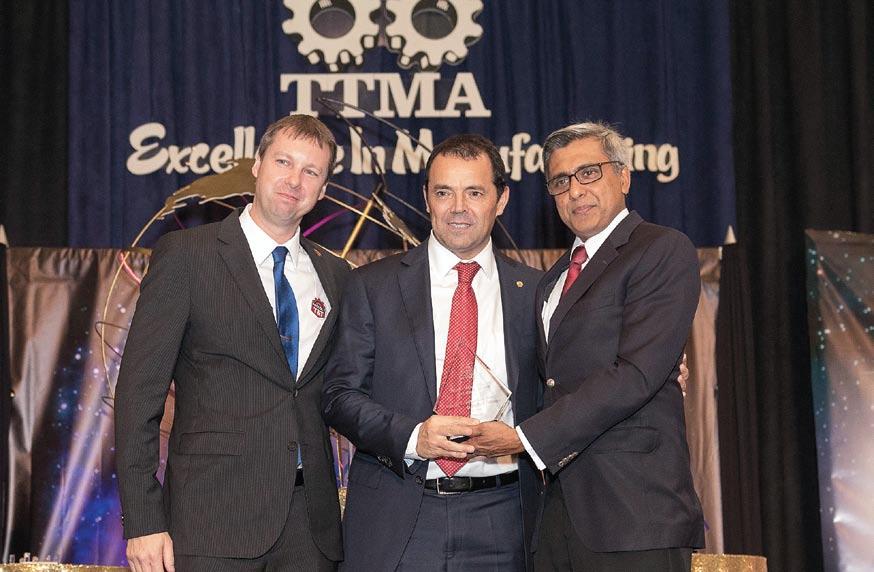
sustainability performance across operations in recent years, and this remains a significant focus area for the company.
Among the initiatives to improve water efficiency at its factory are:
• The Homogenizer Soft Water Recovery initiative - a Tetra Pak system designed to reuse lubrication water, with an estimated savings of 212m3 of soft water per month and a reduction in soft water usage of 20%;
• An Aseptic Tank Water Recovery system, which recovers water used during pre-sterilization and reduces potable water usage by 17%;
• The introduction of a system to use effluent water from a Waste Water Treatment Plant (WWTP) for operation of the factory’s belt press filter, resulting in a 10% reduction in potable water usage.
Meanwhile at the Jamaica distribution centre, a Waste Water Treatment Plant effluent is used to irrigate the lawns and beds.
Changing Behaviours: Nestlé has forged collaborative partnerships with both employees and consumers, particularly in the area of volunteerism, to drive behavioural change, getting buy-in through campaigns that highlight environmental issues. Some of these efforts are simple but tremendously effective — like the 2018 BYOB (Bring your own Bowl/Bottle) program at the company’s canteens, which led to the removal of all single use plastic containers and cutlery, making Nestlé’s canteens plastic free.
22 Corporate Sustainability Review
WItH tHe PLAnet In MInd (continued)
TTMA Award
Chief Executive Officer at Vemco Ltd and former TTMA President Christopher Alcazar (left) stands with Patricio Torres, Head of Market Nestlé Anglo Dutch Caribbean (middle) shortly after accepting the TTMA Green Manufacturer of the Year on behalf of Nestlé Trinidad and Tobago.
The award was presented by Mr. Curtis Mohammed, President of the NGC CNG Company Limited (right).
CsR stories
More complex, but equally important, is the ongoing implementation of an internal recycling programme across the site, with new bins to separate waste in offices. These internal activities are complemented by volunteer events where Nestlé teams up with schools to plant grow boxes, upgrade a park and a river with new recycling bins, and undertake beach clean-ups.
Nestlé is the world’s — and the Caribbean’s — leading Nutrition, Health and Wellness company. It strives to

enhance the quality of life for consumers everywhere with tasty, nutritious and healthy food and beverages. But the job doesn’t end there: Nestlé recognises that the consumer’s sense of well-being requires that its products are made in a caring and responsible way that preserves the environment for future generations. This is why Nestlé’s global ambition is “to achieve zero environmental impact in its operations by 2030.” Concrete milestones and the ongoing commitment of all employees make this goal achievable!

Corporate Sustainability Review 23 WItH tHe PLAnet In MInd (continued)
JM Rae Town Group - Team Nestlé Jamaica volunteering at their Rae Town Fishing Village Clean-up, in partnership with Kingston and St. Andrew Municipal Corporation and Mattino Logistics. Together, 12000 pounds of waste were collected and removed during the Jamaica and Trinidad beach-ups on July 3rd.
TT Matura Group
CsR stories
Team Nestlé Trinidad and Tobago volunteering at their Matura Beach Clean-up event in partnership with Nature Seekers. Along with collecting and removing waste, the volunteers also cleared large quantities of sargassum seaweed to make way for the easy nesting of the leatherback turtles.
ReCon FIGURI n G F o R sU stAI n ABILI ty
The National Gas Company of Trinidad and Tobago Limited (NGC) plays a pivotal role in Trinidad and Tobago’s gasbased energy sector and is strategically positioned in the midstream of Trinidad and Tobago’s natural gas value chain. Today, NGC leads a diversified group which is evolving into a global business entity, working to develop a structure that supports its international mission to create exceptional value from natural gas and related energy businesses through valued partnerships and arrangements. Part of this evolution or reconfiguration, is recognising that the current business portfolio, must reflect an environmental ethos that is running through the veins of the global oil and gas sector. For NGC, this revolves around energy efficiency (EE) and selected environmental projects while still achieving its strategic business objectives.

What is NGC’s and the group’s contribution towards Energy Efficiency?
In support of the Government of Trinidad and Tobago’s commitment under the Paris Climate Change Agreement, NGC and the group, as agents of the government, are proactively pursuing agendas related to EE. On the business end, natural gas has three main end users - LNG; downstream industries for feedstock or fuel and power generation. With power generation, NGC believes that if energy usage was manged efficiently, this could result in reduced power consumption which could lead to natural gas being redirected for sale to the downstream petrochemical sector in Point Lisas or sold as LNG for profit that would benefit the nation.
NGC’s President Mark Loquan has, on numerous platforms such as the Trinidad and Tobago Energy Conference, Clean Energy Conference and Gas Exporting Countries Forum, advocated the need for energy efficiency and policy to support this. Within NGC, this has led to a shift in focus, moving from just aggregating and selling natural gas to becoming more customer-focused and collaborative with stakeholders throughout the natural gas value chain.
This is not solely an NGC problem, or a gas sector problem, but is of national interest, considering everyone uses electricity. Another change in paradigm is NGC Group’s focus on diversifying from its traditional business to transitioning into sustainable and clean energy ventures. Shifting from conversation to action internally within the Commercial Group, a new division, Manufacturing Industries and Energy Efficiency (MI&EE), was created to drive continuous
improvement in energy efficiency within our existing customer base. The Division’s mandate includes:
• Strengthening national contribution by working collaboratively with stakeholders to shape the development of national policies and laws related to EE, while supporting the implementation of projects that will minimise or reduce energy usage, and raise public awareness benefits of EE and energy conservation (EC)
• Securing current business by influencing behavioural changes within NGC customers through promoting and monitoring the effectiveness of EE and EC programmes targeting energy saving opportunities.
• Shaping the organisational culture as it relates to sustainable energy competencies, which will support renewable energy and energy efficiency activities.
NGC subsidiary, National Energy, has started the Super Energy Service Company (ESCO) project. A pilot study is underway and will assess the feasibility of implementing a full-scale ESCO Project. It is being conducted among NGC’s Light Industrial and Commercial customers (LICs), as well as other organisations. The study entails stakeholder meetings and audits across the public, commercial, small industrial, large industrial and power generation sectors. The aggregated data collected will be used to identify:
• Typical energy savings
• Energy efficiency opportunities across different sectors
• The local capacity for implementation of a Super ESCO model
24 Corporate Sustainability Review
CsR stories
Under this model, National Energy will provide financing to ESCOs for the implementation of energy efficiency audits and installation of equipment and machinery at companies throughout the country. Companies who benefit from the initiative would then be able to pay for the energy efficiency installations through the savings generated.
NGC has embarked on initiatives to promote and educate citizens on EE and EC. At the partnership level, NGC has collaborated with the IAMovement to produce the REThinking Energy Videos series. The goal of this campaign was to take a closer look at climate change as it pertains to local natural gas scarcity, and road-map opportunities which can help to lift Trinidad and Tobago socially, economically and environmentally. The first video focussed on ‘The Opportunity Cost’ and explained the potential revenue lost by NGC and the country when gas supply is prioritised for power generation over the more lucrative petrochemical sector. The second video, ‘The Electricity Subsidy’, demonstrated how the subsidy works and spoke to practical methods for energy conservation that can be used not only by the average citizen but also corporations. The final video, - ‘Solutions for T&T’ - looks at the renewable energy and energy efficiency solutions available to Trinidad and Tobago as guided by the Sustainable Energy Roadmap 2021-2030.
A greening initiative
NGC’s signature Reforestation Programme is another pursuit which seeks to balance business and sustainability. Borne out of NGC’s no net loss policy for its pipeline and infrastructural projects, 348 hectares have been replanted thus far with 100,000 trees of mixed species. While no net loss was the main objective, another key aim of the project was also to create a carbon sink, especially in the southern forest reserve where many of the projects took place.
In 2018, the company took the programme further by contracting The University of the West Indies to ascertain the true carbon sequestration potential of its programme. The study’s aim was trifold:

1. Determine tons of carbon sequestered at NGC reforestation sites between 2005-2018
2. Project the tons of carbon that could be sequestered from 2019 – 2030

3. Quantify the market value of carbon sequestered

At 2018, results showed that approximately 2,243 tons of carbon were removed from the atmosphere with a market value of TT1,542, 191.00. By 2030, it is estimated that 5,228 tons will be sequestered. It is extrapolated, based on the approximate value of the European Union Allowance spot price, that the value would be about TT$ 3,594,502.00.
NGC is excited about the results of this project as it has the potential to alleviate damages associated with carbon emissions.
Conclusion
As NGC seeks to secure its business both locally and internationally, its is cognisant of the importance of fulfilling its national contribution not just to the coffers of the country, but to the wellbeing of its citizens by making bold advances across its business, both operationally and through its CSR projects. Manager Corporate Communications, Lisa Burkett notes: “The buzz in our industry is that this could be almost a third industrial revolution – the green revolution which incorporates energy efficiency, renewable energy, energy conservation and the like. NGC is up to the challenge -managing this duality in the energy industry and the environment.”

For more information on NGC, please visit: www.ngc.co.tt https://www.facebook.com/ngctrinidadandtobago/ https://twitter.com/NGCGascoNewsTT https://www.instagram.com/ngc_tt/



Corporate Sustainability Review 25
ReConFIGURInG FoR sUstAInABILIty (continued)
Photo Credit: Shaun Ramabaran
Head, Corporate Social Responsibility, Myles Lewis with the REthinking energy Essay winners.
CsR stories
Local Content and the Supply Chain
How do I get into Shell Trinidad and Tobago’s supply chain?
It’s the most common question local businesses have for the energy multinational, which has been working hard to expand and encourage Local Content.
Shell’s efforts to effectively communicate contract-award criteria to interested local contractors took another step forward in August 2018 with its first Supplier Share Fair. Dozens of national and community-based businesses that had previously reached out to Shell were invited to hear plans for upcoming contracts and detailed guidelines for meeting procurement requirements.
Each company attending the fair was paired with a relevant representative from Shell’s Contracting and Procurement department and Business Area in a “Speed Date”, where suitors could ask direct questions about service quality and standards that would enable them to meet Group level compliance requirements. Shell believes that Trinidad and Tobago continues to show a lot of potential in the service industry and the fair was a means of testing and registering local service providers.
international standards wherever it operates. “Contracting and Procurement goes through those documents page by page with every interested party,” says Shell’s Community Relations Advisor, Nneka Mentore. The team spends a lot of time outlining exactly what they’re looking for and what a business is expected to attach.
At Shell’s Beachfield, Guayaguayare facility, Shell has been building contractor capacity through strategic partnerships. One such example is that of its experienced Facilities Management partner company which has undertaken to train community contractors, who upon completion can qualify to service Shell or any other operator, in any location.
Shell’s approach is one of mentorship and the aim is to get as many providers as possible to meet global standards for service. The company follows up with bidders through audits of companies that applied for contracts and fell short. “It’s no longer, you lost the contract and you don’t know why,” says Shiron Rodriguez-Marcano, Contracting & Procurement (CP) Team Lead Operational Excellence and Local Content. “The CP team met with all companies that were audited and gave feedback on what one needs to do next to close the gap.”
Mentore says that when comparing oranges to oranges, “Shell always prefers to give a job to a community resident with equivalent skills, over someone who’s not from the fence-line community.”
Shell had already been holding quarterly workshops with local community suppliers to support them in understanding and completing contract-award documents. The process can be daunting for first timers as the industry is heavily regulated and the company must adhere to
But Local Content has waxed and waned in national and corporate importance over the past decade, and Shell is introspective enough to acknowledge that it can only be sustained if upstream operators collaborate. “We’ve reached out to other operators and we’ve said, ‘Ok, this is what we’re doing,’” says Rodriguez-Marcano, Team Lead for Operations Excellence and Local Content. “’How do we align together and do one thing for the betterment of Local Content in the country rather than drip-feeding – we’re doing this, you’re doing that?’”
Shell intends to hold its second Supplier Share Fair in October 2019, but this edition will be slightly different, with


26 Corporate Sustainability Review
sH e LL tRI n I dA d & to BAG o bRinging loCAl Content to CommunitieS
CsR stories
“Speed dating” at the Supplier Fair.
Mentore supports the view, “One of the things that suppliers and potential vendors want to know”, she says, “is that they have a direct line in with a company, if only to understand the process. People just want to know that there is a window of opportunity to get their voices heard.”
Skills Training with Shell

Youth inclusion and participation in the energy sector is a focus for Shell and yet another avenue for assuring local content in the industry. The company sees it as building capability for country – not just for the company.

Shell T&T’s ‘On the Job Trainee’ (OJT) programme began with some number-crunching. After holding a Mayaro job fair in 2017 where over 800 résumés were received, reviewed and shortlisted by Shell’s labour contractor, JSL International.

In the data sorting, JSL found that applications for three positions – drilling fluid operators, mechanics, and electrical technicians – were lacking. Mentore expressed concerns with the findings - “That can’t be. We’ve been in the oil and gas industry for over a hundred years!” It was clear that an intervention was needed.
Filling the gap in future drilling programmes would mean creating a cadre of skilled workers. The response was the creation of the OJT programme. At that time, six carefully selected trainees from Moruga, Mayaro and Guayaguayare were assigned to the Maersk Developer and Rowan Gorilla rigs for two years of mentorship and hands-on experience.
Shawnelle Brereton, the only woman in the group, had come from working six-day weeks in a kitchen, where she hoped for a break that would lead to a new career. “We thank God for placing people here that could help us to grow,” said Shawnelle after her OJT placement. “It was a great opportunity not just to me and for my family, but also to the community.”
Mayaro resident Kyle Felix had been working as an electrician on the Red House restoration project but wanted to follow his cousins offshore. “I came out with a lot more than that,” said Kyle, while feeding livestock and tending to chickens on his family farm. “It actually broadened my mind as to how much
Today, all six OJT participants have been offered permanent employment with JSL International and are headed for rig work locally and possibly in Mexico and Guyana.
Shell is revisiting the data from its two-year programme and trying to determine if there has been any change in the skills available in its fence-line communities. “We certainly would like to offer the OJT programme again,” says Mentore. “It worked well. And we were happy with the performance by the six young people.” She believes that there is room for periodic OJT’s when projects permit. For Mentore, this is the kind of investment that has lasting value.
After two years of training aboard the Gorilla and Maersk Developer, the OJT’s are now in permanent jobs.
Corporate Sustainability Review 27
What Local Content Means at Shell:The added value brought to the nation or local community through local procurement, job creation, workforce capacity development, community skills and enterprise development. CsR stories
sHeLL tRInIdAd & toBAGo: bRinging loCAl Content to CommunitieS (continued)
the company opening its doors even wider via advertising for Expressions of Interest (EOIs) from interested companies. “We saw real value in the last Share Fair,” says Rodriguez-Marcano. “It wasn’t only value for us, it was value for the supplier community as well.”
Shawnelle Brereton receives her award and a welcome career break .
machines and mechanical parts go into making a well come into production.” He says the rig experience also taught him patience and improved his communication skills.
CARIBB e A n Perspectives
29 exxonMobil - PARtneRInG on PRoGRess
ExxonMobil’s Commitment to Guyana’s Sustainable Development
35 A FF o R dABL e And C L e A n e ne RGy In tH e CARIBB e A n
Public-Private Partnerships & The Ege Haina Experience
38 tHe PoWeR to CHAnGe LIVes
Republic Bank Empowers Youth in Guyana
41 GRACeKennedy Gets on tRACK WItH tHe Un sUstAInABLe deVeLoPMent GoALs
The Grace & Staff Community Development Foundation
44 ReGIonAL RoUnd UP
Caribbean Round Up - CSR Across the Region

CARIBB e A n Perspectives
PARtne RI n G on PR o GR ess exxonmobil’s Commitment to guyAnA’S SuStAinAble development
by Lawrence J. Arjoon
“ExxonMobil’s CSR strategy in Guyana is built on three pillars– The Environment, STEM Education, and Women, Youth and Community Empowerment. The strategy is designed to ensure that the benefits from oil and gas are used to foster multisectoral development in as many areas as possible; positively impact lives and livelihood across all regions; and support national development towards a diversified, sustainable economy.”
ExxonMobil is one of the world’s largest publicly traded energy providers and chemical manufacturers; investing in technology to bring the world more accessible energy. Affordable and sustainable energy solutions are required to advance human and economic development. For ExxonMobil, that means achieving objectives while maintaining the highest standards for safety and efficiency, respecting the environment, recognising and managing risk, and being a responsible community partner.
ExxonMobil is helping to meet the world’s energy needs safely and responsibly while building partnerships with key stakeholders that enable progress within their operating territories. In Guyana, ExxonMobil has partnered with the country to explore and develop their oil and gas resources in a mutually beneficial manner. For ExxonMobil, going beyond exploration and production activities in Guyana is ‘the right thing to do’ as a partner in Guyana’s success. At the heart of this partnership for ExxonMobil is acting fairly and responsibly to support the sustainable development drive of a people primed for progress.
Guyana’s people are known for their hard work, resilience and determination, so it is no surprise that Guyanese are quickly adapting and maximising opportunities to meet the needs of a growing oil and gas sector. ExxonMobil has supported this by sharing international best practices and expertise. Guyana has also been leveraging a welleducated population who capitalize on national and regional experience and learnings to accelerate their growth in business and industry skills, safety, and other capabilities. The skills and competency coming from experience in the oil and gas sector has had a positive spinoff effect on other sectors within the economy while fuelling holistic development opportunities across the country.
THE RIGHT THING TO DO
The first commercial oil discovery in Guyana signalled the start of a transformative decade in the country’s history. For ExxonMobil, as a member of the corporate community and
in its partnership with Guyana, ‘the right thing to do’ is to go “beyond just business”. While there is no legislative or regulatory obligation which requires such action, ExxonMobil has implemented a strong and pragmatic local content push, a diverse sponsorship scope, and a dynamic Corporate Social Responsibility (CSR) programme that will support Guyana’s overall development as the oil and gas sector grows.
BEYOND BUSINESS - CORPORATE SOCIAL RESPONSIBILITY
Corporate Social Responsibility (CSR) at ExxonMobil goes beyond sponsorships. While sponsorship of numerous valueadded activities across the country is important, effective CSR is about making sure that communities are positively impacted and best prepared to sustainably leverage the opportunities that become available as the economy grows. ExxonMobil’s CSR programme is focused on three key areas: The Environment, STEM Education, and Women, Youth and Community Empowerment. The strategy is designed to positively impact lives and livelihood in a variety of ways.
The Environment
Guyana is an ecological masterpiece and one of the world’s most pristine natural habitats; a rich and diverse blend of flora and fauna spread over magnificent landscapes. The people of Guyana know and appreciate their unparalleled and valuable biodiversity, and the country has a thriving spirit of environmental conservation and preservation which has also become a core part of ExxonMobil’s CSR focus. This is why ExxonMobil made a multi-year commitment to Conservation International to train Guyanese for sustainable job opportunities and to expand communitysupported conservation.
ExxonMobil’s investment in Conservation International supports the Guyana: Resilient and One (GRO) programme to advance Guyana’s sustainable economy through investments in education, research, sustainable management and conservation of the country’s vast ecosystems.
Corporate Sustainability Review 29
CARIBB e A n Perspectives
ExxonMobil’s investment in Conservation International supports the Guyana: Resilient and One (GRO) programme to advance Guyana’s sustainable economy through investments in education, research, sustainable management, and conservation of the country’s vast ecosystems. Working in partnership, Conservation International, Arizona State University and the University of Guyana will deliver training, research and retention programmes to ensure that economic growth reinforces Guyana’s environmental development goals. In addition, they will also expand conservation areas in the Rupununi Wetlands, aid mangrove restoration and management, and support improvements to communitybased fishing on Guyana’s coast.
ExxonMobil’s most recent investment in STEM Guyana has been towards the National Robotics League 2019 Challenge, and the innovative “Reading & Robotics” Program in school libraries in Regions 3, 4, 5, 6, 10.
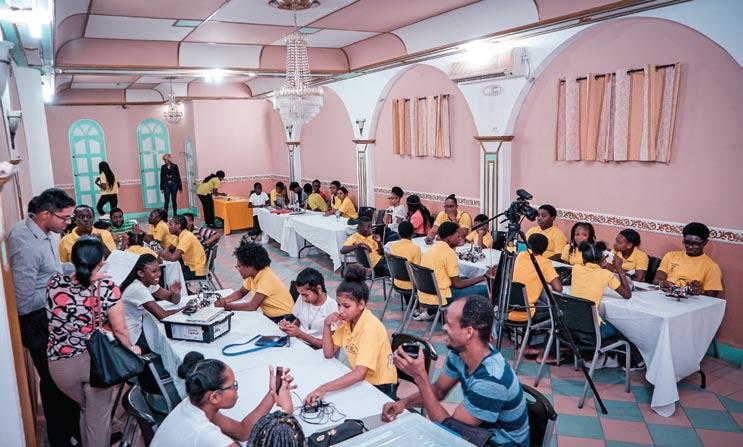
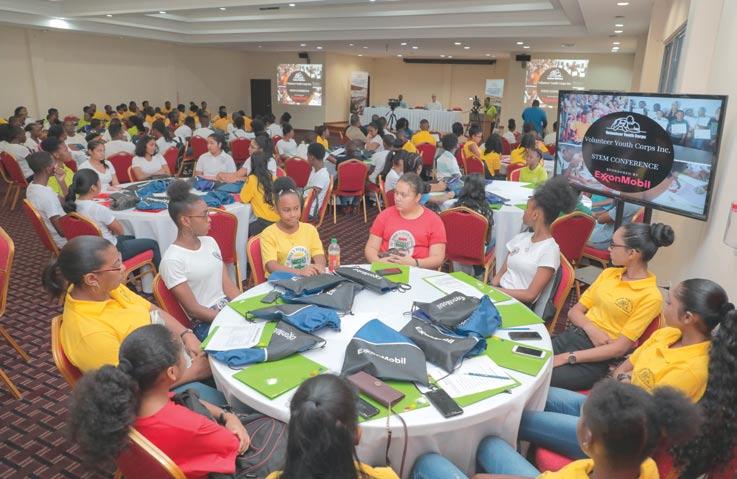
STEM Education
Science, Technology, Engineering, and Mathematics, or ‘STEM’ Education is a global focus for ExxonMobil. The idea supporting STEM is an interdisciplinary and applied approach that sees the four disciplines integrated into a cohesive learning paradigm based on real-world applications. Investing in STEM directly helps the development of the oil and gas sector workforce of tomorrow, and ExxonMobil wants future experts to have the strong foundation needed to think critically and help address challenges as the sector continues to evolve. Of even more significance, however, is the fact that investment in STEM not only supports oil and gas, but other sectors within the economy.
STEM Guyana is a non-profit organisation supported by ExxonMobil that has a self-directed mandate to unlock the world-class technology potential of Guyanese youth. The goal is to bring programming, robotics and math enrichment to every community in Guyana so that young people can excel in an increasingly technology-driven world. STEM Guyana currently operates 100 STEM clubs in all 10 Regions of the country and is focused on primary school students.

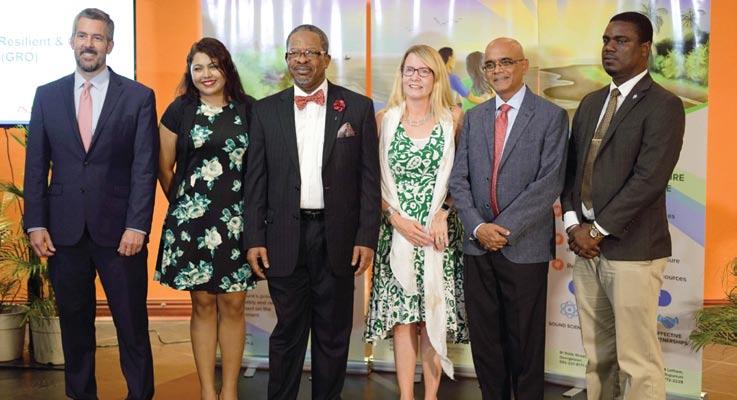
30 Corporate Sustainability Review
PARtneRInG on PRoGRess (continued)
Launch of the Guyana: Resilient and One (GRO) Programme
Volunteer Youth Corps (VYC) STEM Conference
Volunteer Youth Corps (VYC) Robotics Competition
Volunteer Youth Corps (VYC) STEM Camp
“STEM Guyana is a non-profit organisation (with) a self-directed mandate to unlock the worldclass technology potential of Guyanese youth. The goal is to bring programming, robotics and math enrichment to every community in Guyana so that young people can excel in an increasingly technology-driven world. STEM Guyana currently operates 100 STEM clubs in all 10 Regions”
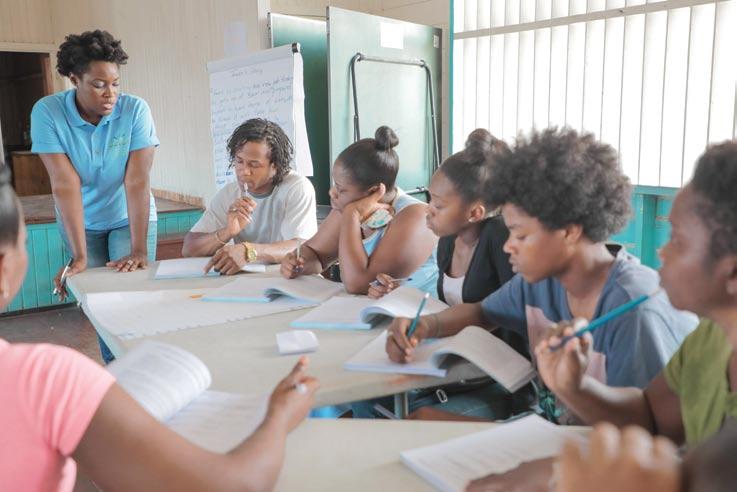

At the secondary school level, ExxonMobil has partnered with the Volunteer Youth Corps (VYC) to support continuous afterschool interactive math and science programmes for 14-17 years old students in 10 schools and 2 centres. An “Introduction to Robotics” programme has also been rolled out in Region 4 that has seen 200 students actively engaged thus far. In September 2018, VYC established the STEM Academy where full-time students are immersed in STEM programmes over a two year period in preparation for national exams. In addition to this, VYC hosts an annual vacation STEM camp. Teachers assigned to the programme are recommended by the Ministry of Education and benefit from an annual STEM conference where they, and their students, interact in a knowledge-share with ExxonMobil staff employed in various fields of engineering and technology.
Women, Youth and Community Empowerment
ExxonMobil is exploring all possible opportunities to positively impact communities and develop and maximise individual potential. Empowering women, youth and community is a direct way of sustainably helping families and building a stronger foundation for future development. Enhancing the economic opportunities available to women enables them to exercise better control over their incomes while increasing their ability to invest in the health,
education, and well-being of their families. ExxonMobil believes that empowered women also tend to support the development of other women as full participants in both the social and economic spheres of society, thereby creating a powerful multiplier effect that benefits the entire community and country.
Community and youth empowerment also means equipping people with the tools needed to build a stronger future. Specialists in Sustained Youth Development and Research, or ‘SSYDR Inc.’, is a Not-for-Profit organisation that is “Connecting Youth to the Good Life” across Guyana. The organisation supports youth economic empowerment and targets at-risk youth. ExxonMobil has partnered with SSYDR to support outreach activities across the country that enhance development opportunities for youths through education interventions, skills training, and job coaching. SSYDR’s approach is holistic, with programmes to support the whole family including adult literacy through the Adult Education Association. SSYDR has also developed its own curriculum with guidance from USAID aimed at making the youth work ready. Modules include Personal Development, Interpersonal Communication, Work Habit and Conduct, Leadership and Teamwork, Safety and Health, Rights and Responsibilities, and Financial Fitness.
Corporate Sustainability Review 31
CARIBB e A n Perspectives
PARtneRInG on PRoGRess (continued)
Specialists in Sustained Youth Development and Research (SSYDR) Youth Empowerment Programme role play session
Specialists in Sustained Youth Development and Research (SSYDR) Youth Empowerment Programme
CARIBB e A n Perspectives
SYDRR also engages in the rehabilitation of youth offenders to prepare them to re-enter the academic school system or enter vocational boarding schools where they learn about fabrication and welding, and participate in other technical programmes. Graduates from the SYDDR programmes are placed in employment through livelihood linkages SYDDR has established with businesses, the protective and military services, and government agencies. The employment programmes sometimes include parents because an employed parent can bolster the domestic support to safeguard against youth recidivism.
SYDDR has also developed its own curriculum with guidance from USAID for making the youth work ready. Modules include Personal Development, Interpersonal Communication, Work Habit and Conduct, Leadership and Teamwork, Safety and Health, Rights and Responsibilities, and Financial Fitness.
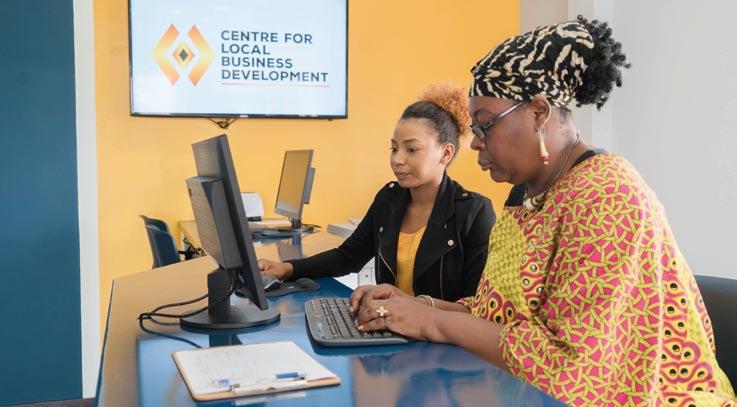
LOCAL DEVELOPMENT, GLOBAL COMPETITIVENESS Global best practices Fit for Purpose in Guyana
Local Content is a loaded term with many different definitions. At its core, local content is the utilization of local suppliers and workers, and the development of their capabilities; whether it is upgrading the competitiveness of local vendors or the training of locals. This can take many shapes and forms. Most importantly, this transformation of businesses and workers must take place specific to the Guyanese context.
ExxonMobil took a proactive decision to establish the Centre for Local Business Development (The Centre) before the Final Investment Decision (FID) was made on the initial Liza field development. A first for ExxonMobil globally, this decision gave Guyanese businesses the chance to register and engage with The Centre to understand the opportunities that would emerge and get a head start on acquiring the skills and competency needed to become active players in the oil and gas sector. The Centre was uniquely set up with the support of ExxonMobil and its project co-venturers’; Hess and CNOOC, with DAI’s Sustainable Business Group as the project
manager. Guyanese have been benefiting from business training; mentorship; embedded technical advice; industry information; and analysis, to help them connect with the oil and gas supply chain opportunities. Given The Centre’s early launch, local companies have been receiving access and opportunities to do business in the oil and gas sector sooner than in many other projects around the world.
As The Centre’s Deputy Director, Natasha Gaskin-Peters explained, “The Centre’s main mandate is to build the competitiveness of local Guyanese businesses so that they can effectively enter into the oil and gas value chain. We want to ensure that Guyanese companies are able to benefit
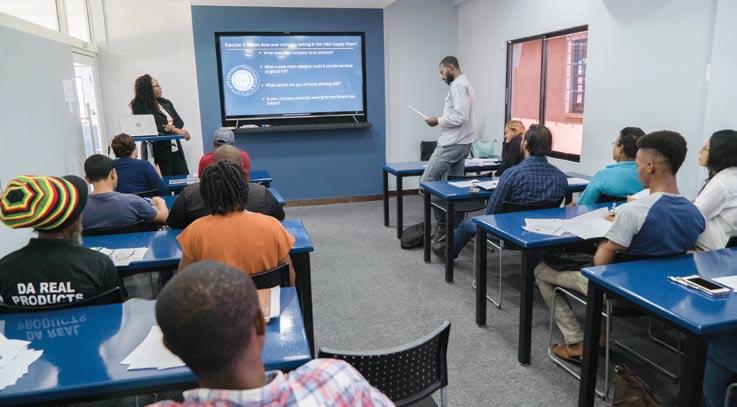

32 Corporate Sustainability Review
Natasha Gaskin-Peters Deputy Director, the Centre for Local Business Development.
PARtneRInG on PRoGRess (continued)
Centre for Local Business Development (CLBD) staff interacting with local businesses
Centre for Local Business Development (CLBD) Oil and Gas 101 class
from the opportunities that arise as the oil and gas sector grows, and at the same time, we want to support sustainable economic growth.”
Although The Centre was established with the advent of the oil and gas sector, its services are not limited to oil and gas. Participants from all sectors in Guyana, including agriculture and manufacturing, can register at The Centre, utilise services, and participate in training programmes free of charge. The Centre operates in three functional areas:
1. Engagement – engaging companies through seminars and outreach that allow “smart business decisions”, and registering companies in the Supplier Registration Portal, which connects them with business opportunities.
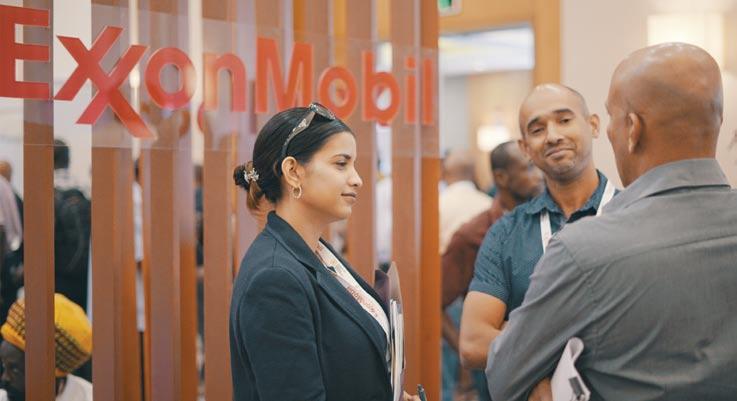
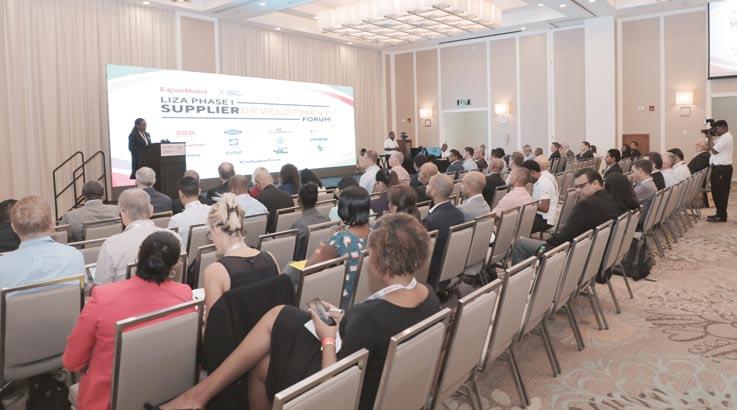
2. Enterprise Development -- building competency and capabilities though training courses to enable businesses to be more competitive.
3. Supplier Development – directly working with businesses towards international compliance or management systems.
“Smart partnerships” is a continual mantra of The Centre. This model allows the transfer of skills and know- how from companies with the requisite expertise entering Guyana, which can be absorbed by Guyanese. The Centre itself operates with several unique, high-performing partnerships which prove the benefit and impact of the concept. The Institute of Private Enterprise Development Limited (IPED), a Guyanese company that provides microfinancing and training, delivers The Centre’s courses in Financial Management and Human Resource Management, and The Centre also operates from the IPED building in Georgetown. Empretec, a small women-led Guyanese entity, conducts
The Centre’s supply chain course, and BrainStreet, another Guyanese company, built The Centre’s unique Supplier Registration Portal and is now working globally with DAI.
As of September 2019, there have been over 700 walk-in visitors at The Centre desirous of registering a local businesses or seeking guidance. Support is available at The Centre to help companies identify and fill gaps that may exist to enable them to be more competitive. The Centre also hosts Supplier Forums in conjunction with prime contractors in Guyana; inviting Guyanese businesses and allowing ExxonMobil and its prime contractors to explain upcoming procurement opportunities. This “fit-for-purpose solution” blends global best practices in procurement with the Guyanese business culture so that when issuing a tender for supplies and services, ExxonMobil can edify prospective bidders to understand their needs and requirements. Fundamental for ExxonMobil in any proposal that is submitted is understanding of current local participation, and capacity building opportunities. This, of course, is in addition to the necessary certification and compliance systems required to operate in conformity to global oil and gas standards.
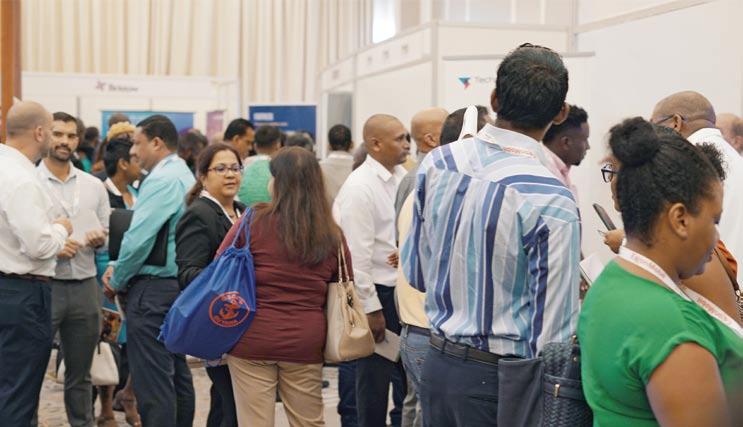
Corporate Sustainability Review 33
e
Perspectives
CARIBB
A n
PARtneRInG on PRoGRess (continued)
Supplier Development Forum Liza Phase 1 Day 1
Supplier Development Forum Liza Phase 1 Day 2 Exhibition
Supplier Development Forum networking
CARIBB e A n Perspectives
Organisations are also recognising the value of people to their business and are actively working to improve their safety culture.”
The team at The Centre has been working to ensure that people across Guyana have access to the opportunities being created, and have delivered outreach learning programmes in nine of ten administrative regions in Guyana. As demand for training grew, the Centre took a new approach by launching a free Computer Based Training on Offshore Oil and Gas. This significantly increases the ability of The Centre to create valuable learning opportunities and enables people from all ten regions - including those in remote communities- to learn about the oil and gas industry.
As part of supplier engagement, the Centre offers three fundamental seminars to Guyanese: Introduction to Offshore Oil and Gas, Procurement for Local Suppliers, and an Introduction to Health, Safety Security and Environment (HSSE). The seminars last approximately three hours, providing crucial information and basic expectations of businesses keen to service the oil and gas sector.
In 2017, an in-depth baseline study was conducted and based on the findings, key longer-term business courses were rolled out to support sustainable development across all local businesses in country: Supply Chain Management; Financial Management; or Human Resource Management. These business courses are available free of charge and are multiple-month courses.
Natasha Gaskin-Peters says, “The Centre has been building a strong safety culture among participants and the results have been significantly noticed in the workplace and at homes around Guyana. The use of safety equipment has increased,” she explained, “and people are really recognising their value as an asset to the organisations and the importance of protecting their lives and those of their co-workers.
The Centre has succeeded in creating a training system that is responsive to Guyana’s unique needs as it ramps up to become an oil producing nation. As companies improve their capabilities and become qualified suppliers, they will need to access funding to transition their businesses. This could mean upgrading facilities, acquiring new equipment, or perhaps investing in new technologies and staff training. To facilitate this next stage of the transformation process, ExxonMobil and The Centre are now working with various partners to provide banking and finance packages to support the growth of Guyanese businesses to meet the oil and gas sector’s needs.
The Centre is a unique partnership with ExxonMobil, DAI’s Sustainable Business Group, and the people of Guyana, to provide business training, mentorship, embedded technical advisors, industry information, and analysis to help connect local suppliers with oil and gas supply chain opportunities.
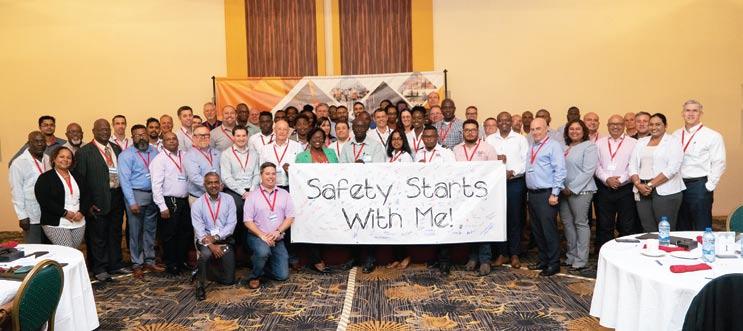
The Centre for Local Business Development is an example of ExxonMobil’s commitment to bringing a sustainable supply base to not only benefit the oil and gas industry, but the broader economy. Today, The Centre serves as a hub for business development and knowledge transfer; it is a dependable and highly transparent resource for connecting buyers and suppliers, and more importantly, it is a proven model for local content creation that can be replicated by other oil and gas economies.
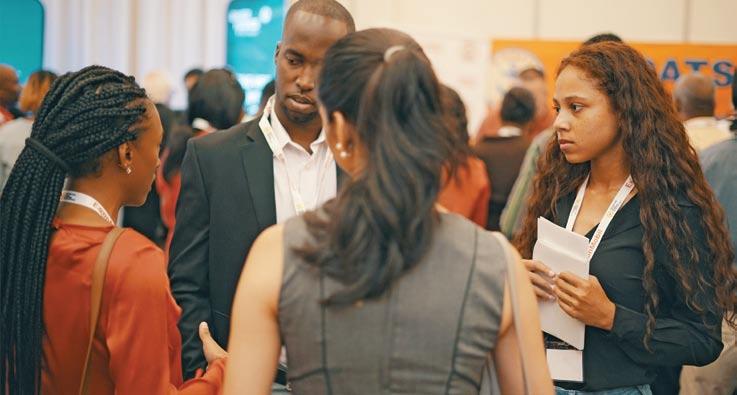
34 Corporate Sustainability Review
PARtneRInG on PRoGRess (continued)
Supplier Forum business to business meeting
Contractor Safety Workshop
Just two hours away from the US mainland is the Dominican Republicthe second largest and most diverse Caribbean country and popular tourist destination to some 6 million visitors each year. Geographically diverse with rich flora and fauna and numerous beaches, this multicultural destination is replete with colonial historical sites and many captivating stories behind them.
Surrounded by the Atlantic Ocean on the north and the Caribbean Sea on the south, here tourists come for the beaches, world-class resorts, nature parks, water sports, buzzing night life, eco adventures and legendary cuisine. But like many other countries in the region, the Dominican Republic is marked by social contrasts of extreme wealth and persistent poverty. With one in five persons below the poverty line, it is not surprising that the Dominican Republic is ranked 94th among 189 countries by the Human Development Index (HDI, 2017).
CARIBB e A n Perspectives
Poverty remains a widespread phenomenon in the Dominican Republic. According to a World Bank Report (April 2019), approximately one in three persons is poor and about 20% live in abject poverty. Many are still without access to running water, proper sanitation and electricity. Roughly 20 per cent of the Dominican Republic’s population is struggling to make a living on less than two US dollars a day. In a country that is home to hundreds of luxury tourist resorts, one in five citizens is chronically undernourished.
Small island developing states (SIDS) remain the most susceptible to the effects of global warming, which is causing rising seas and unpredictable and destructive weather patterns. In the Caribbean, however, governments have been slow to put renewable energy systems in place. In 2017, hurricanes Irma and Maria wreaked havoc in the Caribbean, and propelled a new sense of urgency for countries with dilapidated, outdated and
by Wendy J. Singh
overburdened electric grids, to install and utilize renewable sources of energy.
Renewable Energy Caribbean reported progress in some countries such as: plans in Bermuda to establish an offshore wind farm; a push for 50% renewable energy in Jamaica by 2030; plans for geothermal projects in Dominica and St. Vincent & the Grenadines; construction of a wasteto-energy plant in Haiti; increased solar power in Barbados and the US Virgin Islands; plans to introduce utility-scale PV projects totaling 226 megawatts in Puerto Rico; and plans to install some 10 megawatts of wind and solar power in Antigua & Barbuda (www.renewableenergycaribbean. com). On the other hand, CARICOM member state Guyana, which has a huge potential for hydroelectric and bagasse-fueled power generation still uses thermoelectric diesel-engine driven generators. The recent discovery of oil and gas may make the idea of
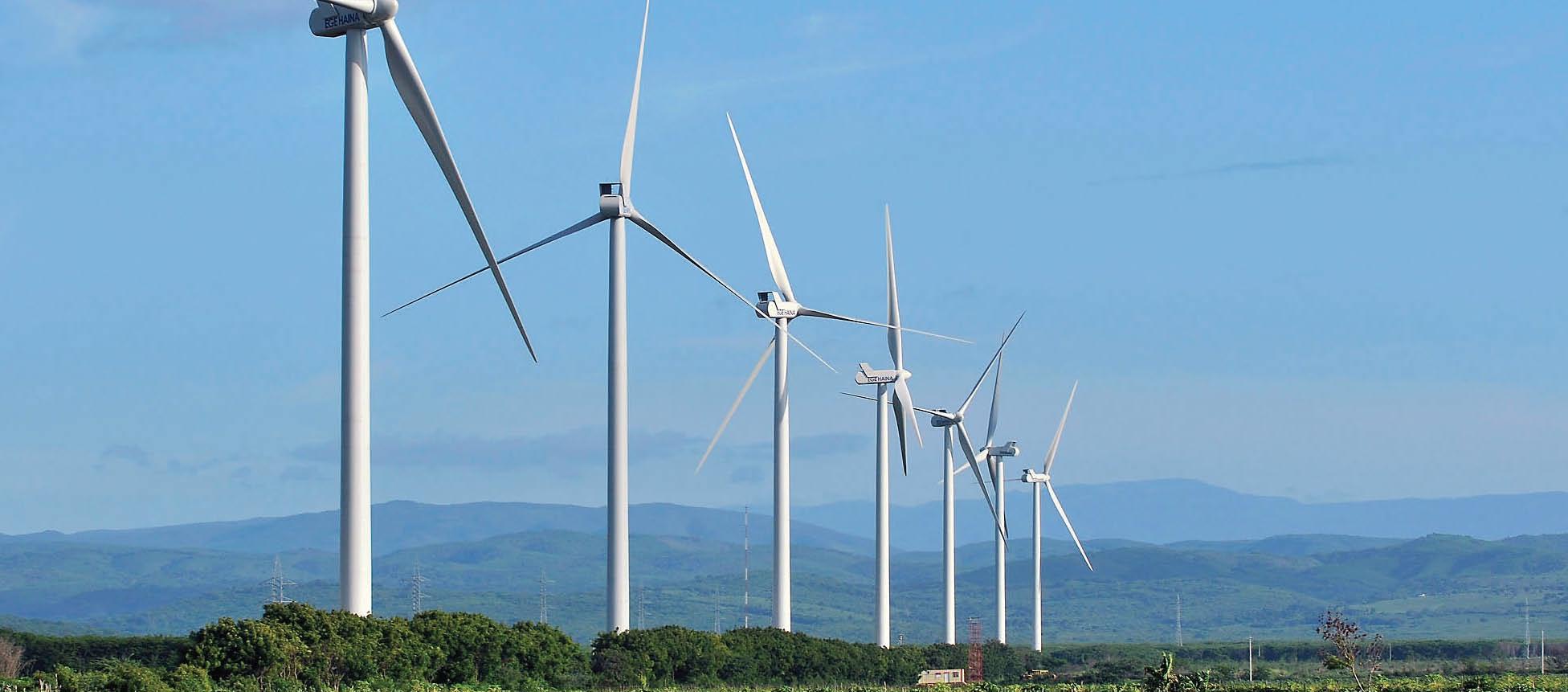
Corporate Sustainability Review 35
AFF
R
A
Los Cocos Wind Farm www.egehaina.com
o
dABL e A nd CL e A n ene RGy I n t H e CARIBB e
n: publiC-pRivAte pARtneRSHipS & tHe ege HAinA eXpeRienCe
CARIBB e A n Perspectives
utilizing renewable energy systems even more remote.
In comparison to other Caribbean countries, the Dominican Republic seems to have progressed furthest with renewable energy systems. Haina Electricity Generating Company (EGE Haina), the leading Dominican mixed capital company, is an example of a successful alliance between private investors and the state with Haina holding 50% of the shares. Established in 1999, it currently operates eight plants, including the 77MW Los Cocos wind farm, the 7MW Quilvio Cabrera Park, the 49.5 MW Larimar wind project, and the second phase
of the 175 MW Larimar project, which together make up the country’s major wind power plants. The company has a total installed capacity of 957MW, accounting for 20% of the country’s grid capacity. The second Larimar project features 14 Vesta-117 wind turbines rated as the most powerful in the Caribbean, with a height of 150 meters and 3.45 megawatts output each. “In total, the wind farms of EGE Haina will produce 585,000 MWH annually from a total of 69 wind turbines, which will avert the annual emission into the atmosphere of 300,000 tons of CO2 and the import of 900,000 barrels of oil, which translates into significant savings of foreign exchange”

(www.dominicantoday.com/dr/ economy/2018/12/19).
The Los Cocos Wind Farm, which began operating in 2011, was selected as the 5,000th Global Initiative of the Kyoto Protocol’s Clean Development Mechanism that reduces greenhouse gas emissions in developing countries. During the first calendar year of its operation, the Wind Farm surpassed its goals, making it possible to save 205,000 barrels of oil, 5,000 more than projected, and prevented the emission into the atmosphere of 56,000 tons of CO2 thanks to its production of clean energy. Statistics are not yet available for the newer Larimar Wind Farm.
Ege Haina is not only a company that provides electricity, but it also provides employment throughout the country. For instance, the Larimar Wind Farm’s second stage was built over a period of one year at a cost of more than US$100 million, using 90% of Dominican labor from the nearby towns of Enriquillo, Caletón, La Ciénega, Paraíso, Juancho, Los Cocos and Oviedo. The company also places emphasis on strong partnerships, and currently maintains collaborative relationships with more than 50 governmental and nongovernmental institutions for social action in communities. In keeping with its corporate social responsibility, EGE Haina has a very strict environmental policy, which gives priority
to planning, maintenance and operations since it believes that a healthy environment is necessary for the well-being of the communities where it operates, its people and its business. EGE Haina believes that this is the basis of a strong and sustainable economy. The company also ensures that employees and contractors comply with environmental policy in order to achieve the goals defined by the company; requires suppliers to comply with Dominican environmental regulations; and ensures that all employees and contractors have the right and duty to stop work at any time the environment is in danger.
36 Corporate Sustainability Review
AFFoRdABLe And CLeAn eneRGy In tHe CARIBBeAn (continued)
Larimar Wind Farm www.egehaina.com
CARIBB e A n Perspectives
While its vision is to be the number one company in the generation of electricity, EGE Haina is results oriented, aims for operational excellence, is socially responsible, has integrity and is concerned about the well-being of Dominicans. In keeping with its corporate business principles EGE Haina contributes to the sustainable development of communities where it maintains a presence by providing training on activities that stimulate income generation. It also carries out social programmes that promote education, ethics, health, sports, culture and care of the environment.
Technical training is provided in the following areas:
• Increasing family income in agriculture, fishing, handicrafts, beekeeping, poultry rearing and farming
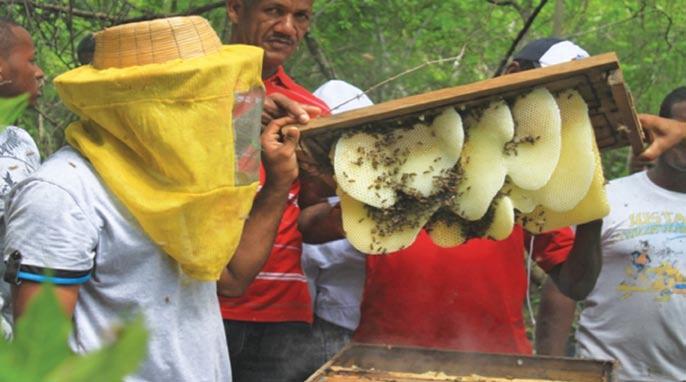
• Personal finances--savings, financial management, entrepreneurship, business development
• Improvement of community infrastructures
• Sports and school facilities, community centres, parks
• Strengthening of civil society and education in values and consolidation of community organizations
• Training of teachers and students, recognition of student merit, eco-schools programme
• Health promotion --training in: primary care, use of medication, nutrition and family hygiene
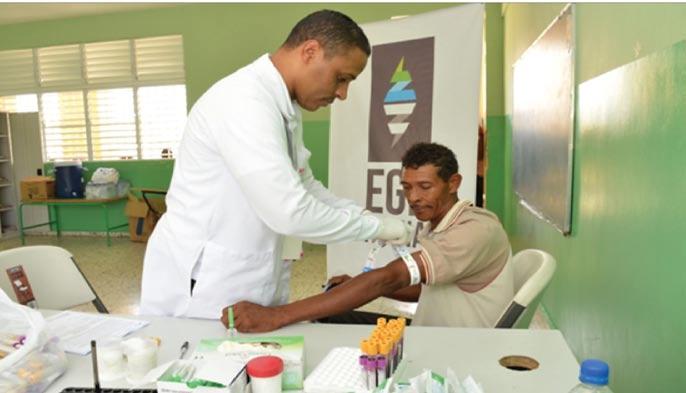
• Environment --recycling of waste, planting trees, beach cleaning, installation and maintenance of coral nurseries

Perhaps building private-public partnerships may be the way to move forward more speedily in diversifying to renewable energy. The successful partnership between EGE Haina and the Government of the Dominican Republic certainly underscores the need for this approach to be adopted by other Caribbean countries.
This article sourced information from various publications and webbased information including Renewable Energy Caribbean.
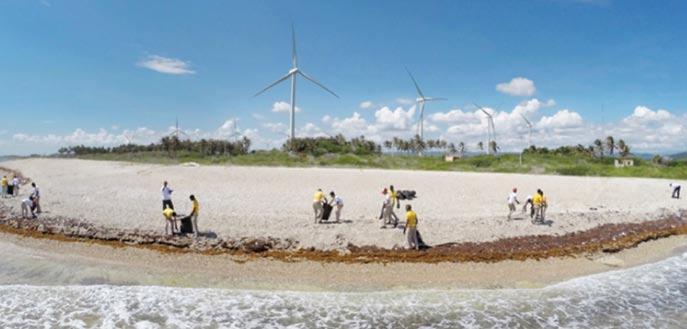
Corporate Sustainability Review 37 AFFoRdABLe And CLeAn eneRGy In tHe CARIBBeAn (continued)
Keeping the beach clean
Training the Beekeepers’ Association in Juancho
Promoting health care in communities
Installation and maintenance of coral nurseries
CARIBB e A n Perspectives
Throughout the region, the Republic Bank Group has distinguished itself with empowerment. For the past 27 years, the company’s CSR programme, the Power to Make a Difference (PMAD) has been touching and changing lives. The programme was introduced in 2003 as part of the Group’s decision to transition its social investments from hand-outs towards sustainability.
At the heart of Republic’s philosophy is the issue of care and equity. “It’s just the way we do business”, says Michelle Johnson, Manager, Marketing and Communications at Republic Bank in Guyana. The very nature of the business is built around the notion of shared-value – that when the bank benefits, so does its customers.
Republic Bank sees its business as integrally tied to the people who bank with them. The Bank’s performance is seen as symptomatic of the economic health of its banking community; therefore creating a space where economic growth and financial opportunity are accessible to everyone, is a goal that the Bank believes should be shared by the rest of the business community. “It makes good business sense”, says Johnson.
In Guyana, the Bank’s PMAD programme works with established NGOs to make interventions into several areas of education, arts and culture and special needs. Johnson makes no apology that their interventions are heavily biased towards youth participation in education. She believes that Guyana is in a state of rapid transformation and that it is critical that youth are given every opportunity to take advantage of the momentum.
Signature programmes for the Bank since it first established roots in Guyana have been the Youth Link Apprenticeship Programme and its sponsorship of steelpan competitions. Less visible has been its work in Literacy Programmes and Staff Volunteerism.
Youth Link Apprenticeship Programme
Republic Bank (Guyana) Limited first launched this programme in October 2008 with 22 Apprentices. Wide canvassing takes place through advertising and promotion and an intense selection process takes candidates to the
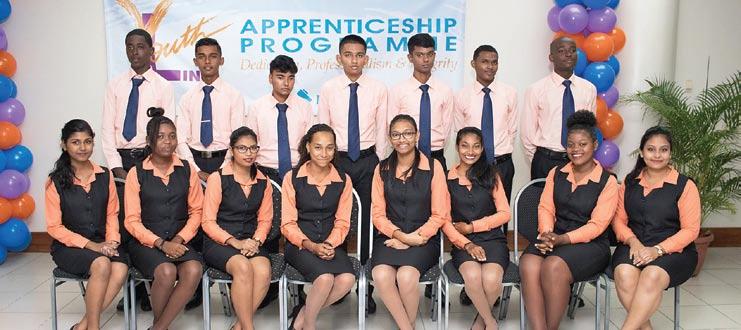
final stages. To qualify, candidates need, as a base, to have excellent mathematical and language skills and must demonstrate requisite attributes for customer service. The objectives are to bridge the gap between the classroom and the world of work-from student to working adults and to equip participants with basic training and marketable skills in business related principles in order to improve career options. To date 270 young persons have come through the Apprenticeship Programme.
During their seven-month tenure, Apprentices are taken through the rigours of office procedures, personal development, banking operations and customer service. As Johnson explains, “The programme forms part of the Bank’s umbrella outreach initiative, ‘Power to Make a Difference’ with special emphasis on the Power to Learn and Succeed.” She says, “Our vision is to inspire, motivate and instil proper work values and ethics in those who enter the programme.” At the end of the training period, Apprentices receive a Caribbean Vocational Qualification(CVQ) from the Caribbean Association of National Training Agencies(CANTA) issued by the Council for Technical and Vocational Education and Training(CTVET). With this qualification of Banking Operations Level 1, the Apprentices will be eligible for jobs within the CARICOM region.
Arts & the Steel Pan Republic Bank is not new to the steelpan nor to the sponsorship of steelbands. The Bank has been part of the schools’ steelbands competition – Junior Panorama - in Trinidad and Tobago for decades. It was only natural for the Bank to take up sponsorship of pan in schools and to be part of Mashramani, Guyana’s foremost national cultural festival.
38 Corporate Sustainability Review
t H e P oW e R to CHA n G e LIV es RepubliC bAnk empoweRS youtH in guyAnA
Republic Bank Youth Link Apprentices 2018-2019
The Annual Republic Bank RightStart Pan Minors Music Literacy Programme aims to provide youths with selfdiscipline and the spirit of teamwork through steel pan, while at the same time making learning fun. The Pan Minors programme started in Guyana in 2010 with 155 students. As of July 2019, over 1270 students have benefitted from the Pan Minors programme, which caters for beginners to advanced players in various Regions across Guyana.
RightStart Participants learn practical skills, steel pan history and music theory during the programme. Every summer a Specialist Camp is included to cater for youths who show an aptitude for Steel Band Arranging, enabling them to take their art to a higher level.

The Bank is also the proud sponsor of the Republic Bank Mashramani Panorama Steel Band Competition which encourages young pannists to compete at the annual national festival. This competition seeks to celebrate the creative expressions of the pan as its music provides inspiration for those aspiring to a career in music, while assuring the development of musical talent in country and strengthening of the country’s cultural heritage.


The first Republic Bank sponsored competition was held in 2009 with three (3) school bands participating. In 2019, the 11th year of the Bank’s investment, over eleven (11) school bands now compete for top spots.
Over the last five years, due to steadily increasing participation, the venue could no longer accommodate the crowds and the event extended for a two day period with minor categories (soloists, duets, jazz ensembles) competing on Day One; while the youth and large bands compete on Day Two. The schools’ competition is also serving to generate wider interest in the artform and a greater appreciation for steel pan music among the Guyanese population. In a series of testimonials during the 2018 solo and duet competitions, the competitors, most of whom started playing via the Republic Bank Pan Minors Music Literacy Programme, spoke eloquently and emotively about the significant role that the artform has played in shaping their personal lives and growth. These ranged from enabling greater discipline and academic success; enabling creativity beyond their expectation and disallowing negative/destructive behaviours to seep into their lives as most of their free time was spent playing pan and learning new skills.
Autism Awareness and the Step By Step Foundation
The Step By Step Foundation is a locally registered charitable organisation catering for the education and development needs of children with autism. In 2011, the organisation expanded its purpose to establish the Step by Step School for autistic children. This project falls under the PMAD category of the Power to Help and Care.
Corporate Sustainability Review 39 CARIBB e A n Perspectives
RBL - Participants - Republic RightStart Pan Minors.
Republic RightStart Pan Minor Music Literacy Participant 2015
Republic Bank Mashramani Panorama Steelband Competition 2018
tHe PoWeR to CHAnGe LIVes RepubliC bAnk empoweRS youtH in guyAnA (continued)
CARIBB e A n Perspectives
To be able to sustain its much-needed service and its role in the delivery of education to all, the Foundation sought the support of sponsors. In 2013, Republic Bank introduced the services of a US medical practitioner specializing in autism. This sponsorship arrangement provides renumeration for two tutors and three annual visits by the specialist which are designed to assess the children’s progress and to monitor tutors’ performance. The specialist also works through the Foundation to conduct assessments on potentially autistic children. More recently, the Bank has provided scholarships for two students who would otherwise have been unable to access the services of the school.
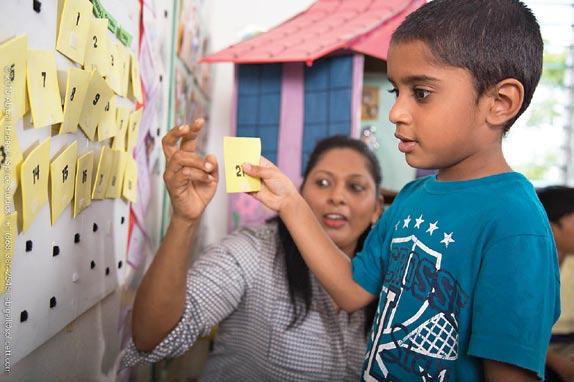
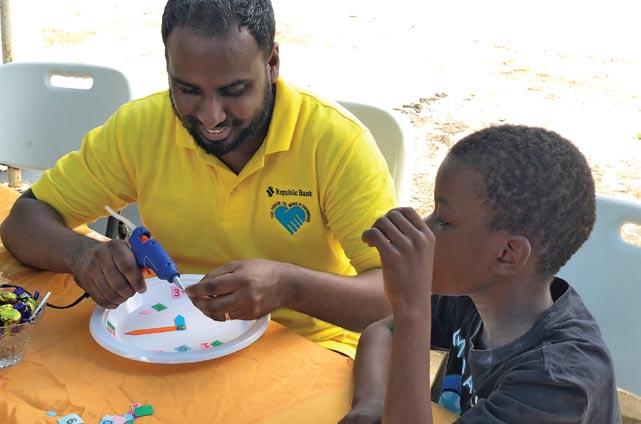
In 2016, Republic Bank introduced the Light It Up Blue - Autism Awareness Walk which has since been hosted annually under the Patronage of the Honourable First Lady of the Co-operative Republic of Guyana, Sandra M. Granger. This walk is held in collaboration with the Step by Step Foundation and School for Autistic Children with support and participation from various companies and organisations to help advance Autism awareness locally and raise funds to support the work of the Step by Step Foundation.

Staff Volunteerism

In the background, Republic Bank staffers are continually engaged in volunteerism. Every level of staff from the MD to entry-level recruits have given of time and talent in a number of ways. Wherever the Bank operates, staff are involved in the community in some way. Through the Republic Bank Staff Volunteerism programme, literacy has been given a high priority, through direct intervention in schools through reading programmes and in the rehabilitation of libraries, provision of books and school supplies. Staffers also work with Children Homes and Orphanages to bring relief and comfort.
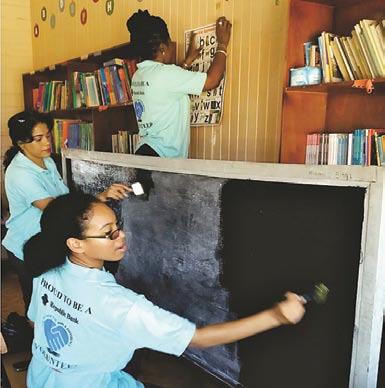
40 Corporate Sustainability Review
Light it up Blue Autism Walk 2017
Photo Credit: Amanda Richards
Staff Volunteerism - New Amsterdam Branch
Staff Volunteerism - Camp Street Branch
Staff Volunteerism - Triumph Branch
Step by Step School for Autistic Children
tHe
to CHAnGe LIVes
in
PoWeR
RepubliC bAnk empoweRS youtH
guyAnA (continued)
CARIBB e A n Perspectives
GRAC e K ennedy G ets on t RACK WI t H t H e
U n s U stAI n ABL e de V e Lo PM ent G oAL s
tHe gRACe & StAff Community development foundAtion
GraceKennedy Limited is recognized as the largest and most diversified food company operating in the Caribbean and identifies itself as one of the region’s largest conglomerates with several diversified companies in the Caribbean, Europe and North America.
With an essentially Jamaica First ethos, the company is proud of its heritage. Established in Jamaica in 1922 by founders John J. Grace and Fred W. Kennedy, the values of ‘Honesty, Integrity and Trust’, have prevailed to create a brand that is respected and well-regraded for quality and reliability in the Banking & Finance and Food & Manufacturing sectors.
More than half of food products sold under the GraceKennedy brand are produced by five Jamaica-based companies Grace Agro-Processor Division, Grace Food Processors Canning Division, National Processors (NALPRO), Grace Food Processors and Dairy Industries Jamaica Limited, a joint venture between GraceKennedy and Fonterra, New Zealand.
The corporation has progressively expanded to acquire business in the financial sector with several businesses in banking, finance, remittances and insurance.
Today the organisation is headed by Don Wehby C.D., Group Chief Executive Officer who leads a team of business leaders from 60 subsidiaries and associated companies across the Caribbean, the United Kingdom, North and Central America. According to Caribbean Value Investor, (a media company which promotes and enables value investing the Caribbean), the GraceKennedy Group ranked 7th out of the top 10 in 2018 on the Jamaica Stock Exchange with a market capitalization in excess of USD $344 billion. The company is “public company” listed on the stock exchanges of Jamaica and Trinidad & Tobago.
Despite its great profit margins and high levels of investor returns, Wehby is clear that the company’s employees are its most valuable assets. GraceKennedy employees were
by Wendy J. Singh
the first to benefit from the success of the company when in 1925, they became the first shareholders. He stresses the importance of the work environment and its role in high levels of commitment and productivity. The company states that it promotes the “Grace We Care” philosophy by providing a healthy and safe working environment conducive to staff wellbeing and “an atmosphere of cooperation and harmony in the workplace.”
Consistent with national aims in the areas of responsible governance and corporate responsibility, GraceKennedy ploughs back into its host communities wherever it operates through a number of social initiatives aimed at generating sustainability and building entrepreneurial capacity.
Jamaica participated at the UN High-Level Political Forum in New York in June 2018 where it presented its Voluntary National Review report of progress towards the UN Sustainable Development Goals. The Jamaican delegation presented a positive report showing a clear alignment of the country’s Vision 2030 National Development Plan with the 17 SDGs of the 2030 Agenda for Sustainable Development. The UN major objectives of the SDGs, which were adopted by 193 countries in 2015, are to “end all forms of poverty, fight inequalities and tackle climate change, while ensuring that no one is left behind”
The 2030 Agenda requires countries to ensure that all government expenditure contributes to advancing the SDGs, including private sector investment. According to Bruno Pouezat, UN Resident Coordinator in Jamaica, “everyone must understand that reaching the SDGs depends first and foremost on effective use of the state budget…Jamaica must ensure that all of government expenditure is understood, and accounted for, as contributing to the SDGs – as does private sector investment, whether foreign (5.6% of GDP in 2016) or indeed domestic (remittances alone amount to 17% of GDP). The objective must be for all resources available nationally to target explicitly the national development priorities.”(UNDP)
Corporate Sustainability Review 41
CARIBB e A n Perspectives
One way in which the GraceKennedy Group is striving to advance the SDGs, is through its Foundation, The Grace and Staff Community Development Foundation (GSCDF), which was launched in 1982 with a grant of 500,000.00 JMD provided by its parent company, initially focused on community development, education and culture.
According to Don Wehby, GraceKennedy, as a good corporate citizen, is committed to giving back to communities where it operates. Employees provide voluntary services in their communities on an individual basis or through the Foundation. Key focus areas are education, health, community outreach and the safety and protection of environment.
Ms. Tanketa Chance-Wilson who is the General Manager of the Foundation explained that apart from the endowment made by the company to the Foundation, the staff gives back to the community through various means. They make financial contributions, which are matched two to one by the company, and do voluntary work in communities where the company has its local subsidiaries in areas such as downtown Barbican, Majestic Gardens, Spanish Town and in rural Westmoreland.
Ms. Chance-Wilson also addressed the policies of the Foundation which are directly aligned with five of the 17 SDGs: Goal 1 no poverty, Goal 4 Quality Education, Goal 5 Gender Equality, Goal 13 Climate Action and Goal 17 Partnerships for the Goals:
No Poverty
Grace & Staff partnered with the Scientific Research Council and small and medium enterprises’ financial institutions to host soap making and personal care products workshops, in an effort to provide skill training for residents, and ultimately create enterprise. The participants received certification, business exposure and materials to fast-track their business initiatives.
Gender Equality
The Foundation partnered with the British Council in Jamaica to implement a mentorship programme in schools for boys in grades 7 – 9. The objectives included ensuring regular attendance and keeping the young students mentally engaged to consistently improve their opportunities in life. Progressively, the programme will reach a bigger catchment of children cross all three counties. Male mentors are drawn from corporate
Jamaica, schools, the creative industry and faith-based institutions.
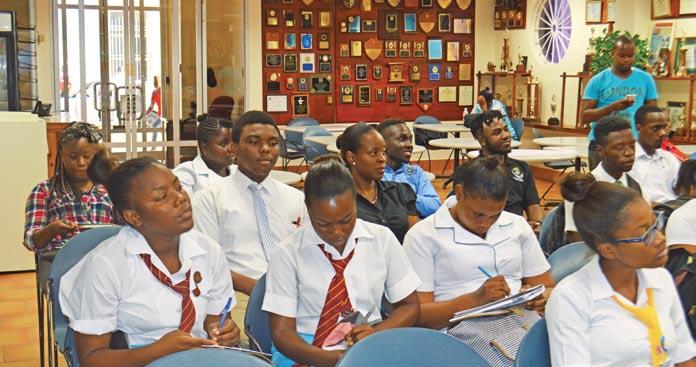

Quality Education
The Foundation is of the firm belief that education is a tool for community development. Scholarships were therefore provided for 525 high school and tertiary students based on their financial needs, as well as for those “at risk” of dropping out of school or becoming involved in gang activity from under-served communities. Staff offers one-on-one teaching/mentoring and are usually assisted by past scholarship beneficiaries. They engage stakeholders in communities –youth, NGOs and others, and establish partnerships to set up homework centres for students to be engaged productively.
Partnership for the Goals & Climate Action
Over 100 participants benefitted from summer camp programmes during 2018 through partnerships with the Scientific Research Council, Women in Maritime Caribbean and the Jamaica Social Investment Fund. Programmes covered the introduction to computers and catered for adults in the under-served community of Majestic Gardens. Residents from downtown Kingston participated in the underwater robotic programmes. Each camp covered areas in climate change and environmental protection of the Kingston Harbour.
42 Corporate Sustainability Review
GRACeKennedy Gets on tRACK WItH tHe Un sUstAInABLe deVeLoPMent GoALs (continued)
GraceKennedy quality education.
CARIBB e A n Perspectives
GraceKennedy Group Members
Banking and Financial services

• First Global Bank Limited
• First Global Financial Services Limited
• FG Funds Management (Cayman) Limited
• First Global Trinidad & Tobago Limited (formerly One1 Financial Limited)
• Signia Financial Group Incorporated
Remittances
• GraceKennedy Remittance Services Limited
• GraceKennedy Remittance Services (United States) Incorporated
• GraceKennedy Remittance Services (Trinidad & Tobago) Limited
• GraceKennedy Remittance Services (Guyana) Limited
Insurance Life and General
• Allied Insurance Brokers Limited
• GK General (Eastern Caribbean) Insurance Company Limited
• First Global Insurance Brokers Limited
• GK General Insurance Company Limited
• Trident Insurance Company Limited
Manufacturing, retail and distribution
• Dairy Industries (Jamaica) Limited
• Grace Foods and Services Company
• GraceKennedy (Belize) Limited
• Grace Food Processors Limited
• Grace Food Processors (Canning) Limited
• GraceKennedy (United States) Incorporated
• Grace Foods International Limited
National Processors Division
• World Brands Services Limited
• Hi-Lo Food Stores (Jamaica) Limited
• GK Foods (United Kingdom) Limited
• GraceKennedy (Ontario) Incorporated
• Hardware & Lumber Limited
Corporate Sustainability Review 43
WItH tHe Un sUstAInABLe deVeLoPMent GoALs (continued)
GRACeKennedy Gets on tRACK
CARIBB e A n Perspectives
R eGI on AL R o U nd UP CARibbeAn Roundup - CSR ACRoSS tHe Region


August 2019
Huawei/Seeds for the Future - Multinational technology company Huawei has reaffirmed its commitment to local youth development and educational advancement by launching its third annual Seeds for the Future 2019 programme. Since 2017, Huawei Jamaica has worked on this project in cooperation with The University of the West Indies and the University of Technology, Jamaica and has witnessed 16 students benefiting. The main goal of the programme is to create new opportunities for outstanding students. Seeds- for the Future gives students a oncein-a-lifetime opportunity to experience working at the Huawei headquarters in China for two weeks. Seeds for the Future was introduced by Huawei in 2008 as its corporate social responsibility flagship programme, an investment deemed necessary to expanding the awareness and understanding of students regarding the telecommunications sector, region-building, and the digital contingent.

July 2019
JMMB Bank/Carbon Zero - The JMMB Bank partnered with members of the Carbon Zero Initiative of Trinidad and Tobago (CZITT) in its Environmental Sustainability thrust to support the 1000 Trees Challenge by distributing Moringa trees to JMMB team members and clients at their Port of Spain, Tunapuna, Chaguanas and SouthPark locations. CZITT is a non-profit organisation dedicated to ensuring that Trinidad and Tobago becomes a Carbon Neutral country by the year 2050. Today Trinidad and Tobago is considered one of the top 10 producers of greenhouse gases per capita. Countries need to become carbon neutral to avoid a 2⁰ C temperature rise globally. Environmental Sustainability is one of JMMB’s Corporate Social Responsibility pillars, which also include Empowerment and Education. The partnership between JMMB and CZITT underscores JMMB’s commitment to bringing about social changes and community involvement that positively impact the environment.

China Railway/SERVOL Collaboration - Just in time for the rainy season, China Railway Construction (Caribbean) Company Ltd (CRCCCL) embarked on a partnership with SERVOL in Trinidad to replace the roof at the Junior Life Centre in Cascade. The company also repainted the building, cleared the compound of debris and installed a new and much needed, stand-alone, air-conditioned counselling and meeting room. Managing Director, Mr Yan Meng was pleased to take on the upgrade project as part of their own Corporate Social Responsibility (CSR) outreach; and his employees have undertaken to voluntarily replace the roof, repaint the building exterior and to undertake general repair and clean-up works ahead of the new school term. Commenting at the handover on Saturday July 20th, Vice President of CRCCCL Mr Feng Laigang who was present to welcome students and parents at the event, said, “CRCCCL attaches much importance to maximizing local content in the way it does business.” He also spoke about the company’s relationship to its communities and particularly about its collaboration with the JLC which is part of its host community. He said, “This is the first phase of our collaboration with SERVOL Cascade Junior Life Centre.”
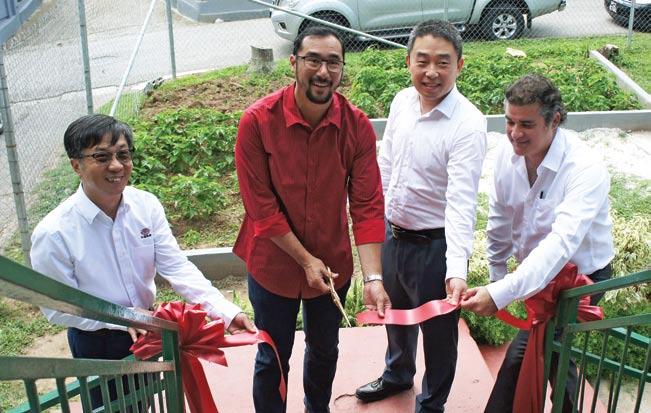

44 Corporate Sustainability Review
MP Young completes the handover - VP Feng Laigang, Min. Stuart Young, PRC Embassy’s Zhang Lei and JLC Chairman Dwayne Henderson
CARIBB e A n Perspectives
PCJ Jamiaca/T20 Tournament - The Petroleum Corporation of Jamaica (PCJ) is demonstrating its support for sports and community development with a $3-million sponsorship of the Social Development Commission (SDC)/Wray & Nephew National Community T20 Tournament. The competition, which commenced in April 2019 under the theme ‘Building Communities… Building Jamaica,’ has eight remaining teams vying for the championship title this year. Being staged for the 13th year, the initiative is a major socialoutreach activity for the SDC that involves an average of 300 community teams with players ranging from age 14 to 45 years. In addition, the annual event provides employment for approximately 2,000 individuals. With over $2 million up for grabs, the top four teams will be able to contribute to improvements in their communities as a portion of the cash prize will fund a major project that will address a collective need.
Unicomer/Sweet Success – A 2016/2018 partnership between Unicomer and the Alliance of Rural Communities has paid off. Unicomer’s commitment to corporate social responsibility addresses small businesses, providing them with the tools needed to thrive and expand. Between 2016 and 2018, the company has invested US$35,000 in training and development of local small businesses. One such beneficiary was the Brasso Seco Chocolate Company. Unicomer worked with Director Kelly Fitzjames, a Director of the Alliance of Rural Communities to establish networks for market expansion. This has led to the introduction of Brasso Seco, Grande Riviere and Biche and Cushe chocolates on shelves across supermarkets, gourmet food stores and retailers across TT.

Caribbean Cement Company/Energy from Old Tyres – Jamaica based Caribbean Cement Company plans to spend US$9 million ($1.2 billion) on capital projects this year, one of which involves converting old tyres from waste to energy at its kiln. The tyre project was pitched by outgoing General Manager Peter Donkersloot Ponce not as a money-making venture, but one meant to make a positive contribution to the environment. “We will be able to eliminate the tyres in Kingston, probably in four years,” said Donkersloot Ponce at the company’s annual general meeting in July. The cement maker is owned by construction giant Cemex of Mexico. The project will replace some fuel consumption by the company and solves a real issue. Donkersloot Ponce sees it as part of the company’s corporate social responsibility.


June 2019
TSTT/Cyberbullying - Communications solutions provider bmobile has taken a firm stance against bullying by partnering with Caribbean Colour Splash and Citibank to host the first-ever Primary Schools Anti-Bullying Conference. At the National Academy for the Performing Arts (NAPA) in Port of Spain, Trinidad, the company invited students from North and East Trinidad to collaborate on prevention and implementation solutions to counter the multiple forms of bullying (physical, verbal, social and cyber).
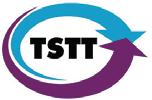
Housing Development Corporation / Internship - The Housing Development Corporation (HDC) of Trinidad & Tobago placed 21 tertiary level students in a ten week programme called the “Internship to Leadership Programme”. The students were selected from more than 300 students and were integrated into various areas of the corporation including development, construction management, finance, social work, legal and corporate communications from June 4 to August 16 of this year. The main objective of the programme is to provide each student with the requisite industry experience in their respective fields of study while providing opportunities for leadership and professional development.

Corporate Sustainability Review 45
ReGIonAL RoUndUP CARibbeAn Roundup - CSR ACRoSS tHe Region (continued)
CARIBB e A n Perspectives
Angostura/Champion Awards - The Angostura Champion Award is a corporate social responsibility initiative to celebrate and support individuals who go above and beyond to improve the lives of others. Nominations are open to the public and judged by a panel of notable members of society. This year there were five champions, who along with those who nominated them for the competition, were treated to a Christmas dinner before they were given their awards. Winners were - Christopher Dennis, Elspeth Duncan, Frank Edwards, Donald McLean James and Koriella Espinoza.
May 2019
Guardian Group/Fitness Sundays - For the second year, Guardian Group has partnered with Phillips Promotions for the Keep it Moving Family and Fitness Sundays. Keep it Moving is a community wellness and physical activity programme that utilises a closed-off section between Sierra Leone Road and Wendy Fitzwilliam Boulevard of the Diego Martin Highway every Sunday from 6-9 am. Participation is on average 450 persons which includes men, women and children of all ages and backgrounds, mainly from Diego Martin and environs. “The support of Health and Wellness initiatives is one of our core CSR pillars here at Guardian Group, as we continue to partner with socially sustainable programmes,” said Ayesha Boucaud-Claxton, senior manager, Group Corporate Communications. “It is our belief that programmes such as the Keep it Moving Family and Fitness Sundays, with a heavy focus on exercise and wellbeing, assist in the reduction of non-communicable diseases in Trinidad and Tobago.”

April 2019


Republic Bank Ltd/Caribbean Junior Golf Open Tournament - T&T’s Chris Richards Jnr and Yeji Lee played their way to victories on the final day of 2019 Republic Bank Caribbean Junior Golf Open Tournament at the St. Andrew’s Golf Course, Moka, Maraval, in April. The three-day tournament saw young local talents match skills with juniors from Antigua, Barbados and St.Lucia, as they came up against their Caribbean counterparts. Republic Bank’s General Manager Anna-Maria Garcia Brooks said the Bank was honoured to do its part in promoting teamwork, sportsmanship and the fostering of strong bonds among the nation and the regions, junior golf communities. As part of the Bank’s corporate social responsibility, Republic Bank recognizes that the game of golf has contributed to the empowerment and development of young people of Trinidad and Tobago, and has found its home as part of our Power to Make a Difference programme.

March 2019
BPTT/ IT for Seniors - Thirty (30) senior citizens from northwest Trinidad were given an exciting introduction to information technology through an intensive five-day workshop at the Carenage Homework Centre. Sponsored by BPTT, the workshop covered the fundamentals of computer literacy. The participants were given the Samsung tablets provided by BPTT during the workshop as a gift. The oldest trainee was Leonora Smith, 83, of La Puerta, Diego Martin. The workshop was led by Sonja Shuffler, a Trinidadian who is the principal officer for Toronto, Canada-based IT for Seniors, a non-governmental organisation aimed at empowering senior citizens to “bridge the gap” to information technology.
46 Corporate Sustainability Review
ReGIonAL RoUndUP
CARibbeAn Roundup - CSR ACRoSS tHe Region (continued)
CARIBB e A n Perspectives
Republic Bank Ltd/Icon Merit Award - Calypsonian Chalkdust, Dr Hollis Liverpool, was honoured with the first-ever Republic Bank Icon Merit Award for his contribution to TT’s cultural and educational landscapes over the past 52 years. The award ceremony, took place on March 23 as a collaborative effort between Republic Bank and the Sunshine Awards Organisation – which produces the internationally-recognised Sunshine Awards in the US. The Icon Merit Award seeks to honour TT’s many icons for excellence in the performing arts, education, humanity, science, sports and culture, and aims to be an annual staple in this country’s event calendar. The Bank’s Power to Make a Difference CSR programme is a social responsibility and investment model that has built meaningful and long-lasting relationships with numerous non-governmental organisations and community-based organisations, working side by side to unlock the potential of those residing within the communities.

Readymix (West Indies)/Road Safety - In an effort to reinforce the dangers associated with heavy vehicles, Readymix (West Indies) Ltd has launched the first of its safety branded concrete mixers to encourage greater road safety among drivers and pedestrians. The move is part of the company’s corporate social responsibility. On February 22, the company launched the concrete mixer, targeting pedestrians with the message “Don’t Chance it…Look out before You Step Out”. The initiative was done in conjunction with Mexican parent company, Cemex. Readymix general manager Nigel Tozer said its goal is to use the trucks as “moving billboards to remind everyone of the potential danger around large vehicles.”

January 2019

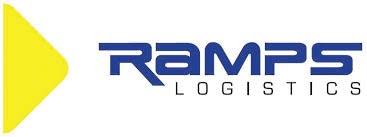
RAMPS Logistics/Christmas for Kids - In December, RAMPS hosted their fourth annual Kid’s Christmas Party in Cunupia, Trinidad. Guests included the El Shaddai Restoration Home; Ezekiel Home for Abandoned Children; Couva Children’s Home; and the Ryu Dan Dojo Youth Empowerment Centre. The recently affected flood victims from Caroni, Warrenville, Cunupia and environs, as well as other underprivileged families in the area were also invited. In addition to reaching out to family, friends, and stakeholders, staff also utilised their own funds, ultimately amassing over 600 gifts.
TTPOS/Service Support - Over 140 companies have pledged their support to the T&T Police Service (TTPS)’s I Support Our Service (ISOS) campaign. The initiative, which is the brainchild of Police Commissioner Gary Griffith’s wife Nicole Dyer-Griffith, was launched at the commissioner’s residence at the Police Training Academy in St James. The ANSA McAL Group is one organisation that has pledged a group discount to police officers and Guardian Media has pledged free space and time on their network to give exposure to this campaign. Concept promoter Mrs Nicole Dyer-Griffith says the campaign would have a tangible effect on the morale of police officers, who are sometimes underappreciated by members of the public
PowerGen/Secondary Schools Cricket - The Power Generation Company of T&T PowerGen continues its sponsorship of the 2019 Secondary Schools Cricket League (SSCL). This will be the 23rd year that the company will be investing in the league. President of the SSCL, Surujdath Mahabir signed off the sponsorship agreement and thanked PowerGen for its continued support and commitment of a very successful partnership, which has allowed thousands of young Cricketers to have fun and develop their athletic skills and social development. He pointed out that the investment has supported many young cricketers who have gone on to represent T&T and the West Indies over the last two decades.

Corporate Sustainability Review 47
ReGIonAL RoUndUP CARibbeAn Roundup - CSR ACRoSS tHe Region (continued)
Meet Joel “Monty” Pemberton,
a man who has been positively disrupting trinidad and tobago with his innovative ideas and bold undertakings. most notably, have been his leadership of two indigenous oil and gas companies, and his support for mentorship, leadership development, and entrepreneurship. monty believes that businesses have a duty to develop people, create future leaders, and positively influence society. Here he shares with the Review, his journey, and what he believes is possible when people are committed to the common good.

48 Corporate Sustainability Review
Cons CI o U s Ceo
Cons CI o U s Ceo
BUIL d I n G A M ento R s HIP CULt UR e inSpiRing leAdeRSHip And CollAboRAtion foR tHe Common good
What is the common good?
It’s very simple actually – it’s working for the benefit and in the best interest of everyone. It’s taking personal responsibility for our actions, and the impact they have on the people with whom we interact. In business, it’s ensuring that our shareholders, partners, colleagues, communities, country, and the environment all benefit fairly and justly from our activities. It can sometimes be a challenging balancing act, but as individuals, and as companies, we must be always cognisant that we are a part of the whole. We must realise that all our actions, however big or small, all contribute to shaping the world in which we live.
Joel “Monty” Pemberton, Founder and CEO of DeNovo Energy Ltd.
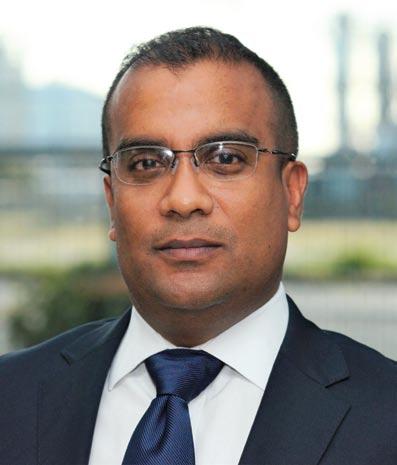
Why is mentorship important?
Mentorship helps push boundaries to make the maybe and the impossible happen. It allows us to learn from the experiences of one, refine them and make things better for the other. Mentorship is about combining and applying knowledge and experience to new situations to achieve more than we can imagine possible on our own. Mentorship allows us to test and strengthen what we already know, explore what we know we don’t know, and identify what we don’t know and need to know, a lot faster through collaboration. The beauty about mentorship is that it’s two-way, in that both the mentor and mentee help develop the other, sometimes without even recognising it.
I have always been inspired by Steve Jobs, his accomplishments, and most notably, his concept of “connecting the dots”. It has been through the process of looking back to move forward that I have been able to reassess my failures and see that they may have actually been fortunate changes that led me to where I am today. From that process, I realised that I have always had mentors, but not necessarily by that name. Throughout my life, mentoring was organic, though not formally recognised as mentoring, and extremely valuable in helping me to synthesise ideas and take risks.
What are some of these areas where we may not traditionally notice mentorship?
When we look at our homes and communities, we can see the impact of early mentorship. Mentorship is present in how we build the concept of a leader as our children grow; in how we influence who they turn to for inspiration and direction, and how they develop into leaders. There is a disparity in the concept of leadership across our communities, and I think the first thing we need to do is recognise that leaders are not just persons in the business community or in government; there are leaders in homes, in schools and communities. In many places there is that someone who has taken up that responsibility to influence others for the common good. It is the someone who encourages you to get out of bed for school or work, or constantly pushes everyone to make the best of the opportunities presented. That person is a leader. Caring about the development of others requires effort and commitment, and those persons, I strongly believe, who are pushing others to excel because of their own life-lessons and experiences, are performing a type of mentorship that we may not readily recognise.
When I was at Trinity Exploration & Production, we adopted a school in Rancho Quemado and introduced the Virtues Project. We wanted to help the
by Pat Ganase
kids understand the importance and impact of values and virtues, which was easy because children naturally want to learn. We recognised that the teachers and parents were trying to do their best with what they had, so we expanded the programme to them and saw significant impacts in having a shared-values system. Teachers became better at managing situations and challenges, and greater support was provided by parents. Once you develop core values and virtues, they stay with you for life. Not just with you, but with you and your children, and their children and families. So mentoring children means understanding that parents and teachers are also part of the process, and have direct influence; they need to understand that they are de facto mentors too. More often mothers drive the process, and when the father is also involved, progress is faster. When it’s done as a community, it becomes a lifestyle.
When I was in Cub Scouts at Maria Regina primary school, we would learn about building camaraderie with friends, with colleagues, working together, working as a team, because those concepts were inculcated at that level. You were a pack leader! When I moved into Sea Scouts at St. Mary’s College, the team-building continued, and it became a lot more intense. To get to the house on Gasparee Island, you would have to take a pirogue and row down the islands. You were one
Corporate Sustainability Review 49
of forty boys with one leader, surrounded by the open sea, in a boat with some boys who couldn’t swim, some who were weak rowers, no mobile phones or any form of external communication, so you had to look out for each other, and you learnt to calculate and manage risks. You were responsible and accountable for the lives of others and you learnt to take care of people. I also recall having been mentored and taught leadership by some exceptional individuals, namely Fr. Toba Valdez, Fr. Ronald Mendez and Mr. Buckmire. They were the leaders in my youth.
Those early years also taught us about collaboration, problem-solving, the importance of embracing differences, and leveraging the collective skills of your troop, because that was the culture shaped by our leaders from an institution that is over 125 years old. That was mentorship in one of its purest forms. Some boys were good at building houses or pitching tents, some were good at cooking, so you had to build on the different skillsets. If there was no food, someone would take responsibility for cooking and they would figure out how to do it, with the support of those around. That’s how you fed a troop. That’s how you learnt to be a leader.
What are some of the other “dots” in your development?
I’ve had quite some notable eye-openers and “Ah-Ha” moments in my life. When I left high school, my father sent me to learn accounting at Ernst & Young instead of sending me abroad to study. He believed, after speaking to the Managing Partner of the firm, that the best way to be an accountant was the traditional way, starting from the bottom, learning and studying, working your way up. My early mentors were Colin Soo Ping Chow and Nicholas Gomez, with Arlene Frederick and Lily B. Young playing key roles later in my career at Ernst & Young in Trinidad and Tobago. When I worked in
London, Svetlana Perverzeva and Claire Fitzpatrick were influential mentors who helped me adapt to the London office. The lessons and work values I learnt from those individuals were priceless, and are still being passed on by me, to others as well. That is the power of mentorship, as leaders positively multiply their impact through others across generations.
One individual that I will single out is Mr. Thomas Evans, who stood up for integrity, even when it meant losing clients and taking financial losses. His stories became legendary as did he, as others strove to emulate his behaviour. Tommy and the other partners would sit with us in the lunchroom and talk, and that is where life mentoring happened. Those were the moments when you felt synergy – a culture of shared learnings.
When I moved to EY London, that was my first experience of formalised mentorship. The corporate mentorship programme had a strong impact on my professional growth and global outlook. The international exposure in the UK and Europe broadened my understanding of global business and operating across different cultures. This is where I developed the ability to manage change and embrace diversity.
In terms of ‘dots’, one such dot occurred as I mused from my window overlooking Big Ben. At the time life was fast and exciting, but I was beginning to feel that something more was missing, and I couldn’t quite figure out what that was.
I decided to take a sabbatical to figure out what I wanted to do in life. I confided in my parents and opted to live on my savings during this period. My father said one thing that resonated deeply with me, “Monty, whatever you do decide, just remember that Trinidad needs good people. Remember that if you decide to stay there, Trinidad will lose someone”.
So, did the Sabbatical help you find what was missing?
I would say that living away for a bit gives you a bigger perspective. I think that in any profession, it is good to see the global business and potential, and to translate that into how you contribute locally. I returned to Trinidad in 2004 and joined RBTT Merchant bank. I took on the mission to establish the Group’s overall energy strategy but ended up leaving my office in Port of Spain to enter a whole new world in Otaheite. Surprisingly enough, it was in a wooden office with a leaking roof in a rig yard that I found what I was missing. I felt that I was finally in my space. I was developing something new and different. I was forging new frontiers.
In 2005, I joined a small energy company, Ten Degrees North. There was a lot of work to be done, but I enjoyed every moment of it. I enjoyed going out into the oil fields and getting to know everyone working there. That made me feel connected with people and integrally part of the business. I was energised by the feeling that I was making a difference – not just for a business but for the people I worked with.
By 2008, I was the youngest CEO of an upstream company. We eventually rebranded Ten Degrees North to Trinity Exploration & Production, which is part of a great story about a local energy company that continues to be a success today. It was shortly into my tenure that oil prices crashed. What stood out during my time there was the response of our people. During these difficult times, I discovered that by really working together with people we could survive and overcome our challenges and that people will rally behind a leader who cares for them. When I went out to the staff, everyone was saying, “Monty don’t worry, we’re gonna cut costs, we’re gonna work with you, we believe in
50 Corporate Sustainability Review
CI o U s Ceo BUILdInG A MentoRsHIP CULtURe (continued)
Cons
Cons CI o U s Ceo
you”. That pushed me into a new realm of leadership – inspiring others during a downturn in business. My response mirrored their enthusiasm and passion. I determined to do better, be better and to support every person in staying the course.
But you left?
Yes, despite all that we had been through, I left Trinity - some would say abruptly; but I needed to do so for personal reasons – and I did so on principle. Many people blamed me for Trinity’s crash, which is the responsibility that comes with being the CEO. It was a very difficult point in my life, and I spent a lot of time trying to understand where I failed and where I did well, what mistakes I made, and what I could have done better. I could not blame anyone, because as the leader you are ultimately responsible. I did however learn from that experience and decided to build a new company would bring the learnings and experiences of the past to create a new future. That’s how DeNovo was birthed.
Holding to my values and being resilient became extremely important for building a new company, because while a lot of people supported me in this new venture, many more did not, including people whom I had considered friends. We did however manage to build an exceptional team, and everyone rallied to make DeNovo a success. Through it all, I think that it is integrity and shared values that sustain us, and I believe that is why DeNovo enjoys so much interest and support today.
Building an organisation from the ground up during an economic downturn, leveraging local leadership and global collaboration, and calculating and managing risks as a team, helped us to build and develop a strong mentorship culture as we grew. That mentorship culture guides all that we do today, and
we see the value of it in our continued evolution.
How can mentorship become ingrained in organisation cultures? There are many models for mentorship, and I think that every organisation should find what works best for them. The key, I believe, is to promote collaboration, openness, sharing, and an appreciation for people and diversity. Everyone brings a unique experience to an organisation and leveraging that in a team yields powerful results.
At Trinity, our sustainability concept was based on two-way mentorship and relied on the “Three Ts” for CSR activities – time, talent and treasure. For any programme in which we engaged, the treasure or money would come from the organisation, but the time and talent would come from our people as active participants in the initiative. I do believe that giving back is a characteristic of good leadership. We worked with the Heroes Foundation to develop and deliver the first Big Brother Big Sister Corporate Workplace Model, and other programmes where we could enable the Three Ts, and the two-way mentorship concept which proved most effective in enhancing the experience and lives of everyone involved.
I have seen how the biggest impact on operations and communities come through human interactions, which is why a core belief when we started DeNovo was that CSR begins with investing and developing our own people. Starting from new allowed us to invest in our people while we invested in our project. We have a relatively young team with bright minds and big ideas, so we connected them with local and global experts and advisors to support their professional and personal growth. We identified a high performing group, and each was engaged as a direct mentee of an Executive Manager. We
then got them engaged in a one-year leadership development programme with one of the best global firms and supported their transition into the organisation’s leaders. With our sharedlearning culture, the lessons from these engagements are being transferred to the wider team, and their families at home, which by extension has a wider impact on our country. We have formal and informal mentorship arrangements, and with learning and development occurring both ways, we are constantly amazed at how our people and the organisation continue to evolve.
What is the vision for your own life?
My big dream is to help revamp the education system in Trinidad and Tobago to create leaders, not just knowledgeable professionals. We need leaders who are willing to accept responsibility and accountability for their teams, families, companies, and communities. In retrospect, we are seeing that the way we grew up a generation or two ago is disappearing, and with it, the learnings we acquired through that informal mentorship in extended families, teams and communities seem to be fading as well. I hope to have a positive influence on that.
I made some fortunate choices that led me to where I am today. With increasing awareness, I am continually connecting those dots in my life – where I was mentored, where I was willing to take risks, where I made mistakes, how I recovered, who was there to help and support me, and how I enable the development of others. At DeNovo, I want to continue to inspire people to collaborate and become the leaders that our future needs. I want to keep inspiring the team to continue evolving to meet the needs of our changing industry and society, for the benefit of all stakeholders and the common good.
Corporate Sustainability Review 51
BUILdInG A MentoRsHIP CULtURe (continued)
sPeCIAL seGMent
Local Content and CsR
53 Jemma Langley, Local Content Champion
58 Maximizing Participation Excerpts from the Trinidad and Tobago Participation Policy and Framework
60 In Guyana by Guyanese Guyana’s Local Content Policy
65 Understanding Local Content in Guyana and why it makes good business sense
Interview with Dominic Gaskin – Director of Business
68 A Local Content Policy for Guyana Maximizing Economic Benefits

sPeCIAL seGMent Local Content and CsR
loCAl Content CHAmpion
Jemma Langley,
... head of the Secretariat for the permanent local Content Committee, is the live example of how education and technology applied in the energy sector promotes agility and adaptability of people, and can drive improvement across the society.

sPeCIAL seGMent Local Content and CsR
Lo CAL Content CHAMPI on
How did you come to this role?
The PLCC was set up in 2004 but was not active for some time. In 2016, it was reconstituted and I was invited to join by the new chairman, Anthony Paul, who has been my mentor throughout my career in oil and gas.
Jemma Langley,
I started off as an administrative assistant at Amoco, but before I left, 20+ years later, I was assigned responsibility for closing competency gaps and delivering training to project and engineering staff. This global path opened up for me when I was invited to become a member of the first Sustainable Development Team at BP Trinidad and Tobago. This team was charged with sustainable development of people in the Trinidad and Tobago Business Unit. It meant crafting and delivering the company’s Sustainable Development/Local Content strategy, policy and initiatives, with a vision to build local human capability, enterprise development and the capital market in Trinidad and Tobago.

I was also a member of a Global Cost Management Team, redesigning Cost Engineering training and revamping procedures used across BP; and also on the team for utilising Organisation Learning within BP’s Global Project Organisation, Trinidad and Tobago unit. I led the project teams in identifying and incorporating learnings from other teams which had successfully executed similar projects.
Did you always aspire to a career in the oil and gas industry?
The long and winding road started in Claxton Bay, where I grew up, the eldest in a family of six children. Our father was a labourer and tailor. Our mother was a housewife who also taught people to cook. Our routine included school and church, and playing outside. Daddy pushed us to make the best of our education. I also spent time with my grandmother who taught me to cook.
As the eldest, I felt driven to make a path for those after me. In 1990, I decided to go to London to study, computers and information technology. My time – day and night –was spent between studies and working to live and to save
money. I packed barrels to send home; always remembering the family.
It was hard for me to enjoy food in London; there was a lot of it, but I felt guilty because I knew how little there was in Claxton Bay.
Even though I had the opportunity to work outside of London, I chose to stay in Brixton which was a rough neighbourhood in those days, 1990 to 1995. By day, I went to school for computer studies. I worked as a kitchen assistant at night. It was wonderful to meet the chefs, Egyptians and Moroccans, who made me feel at home and cooked for me.
I got a lot of experience with different companies in England: Cellnet UK in Slough; at Iceland in Brixton as a cashier, where I was accepted because I understood how to deal with people. I registered with an agency to do catering jobs in the summer. Everything I earned was to send back home to my siblings in Claxton Bay.
When I returned to Trinidad in 1995, the first job was in the computer department of an educational company. I had an unpleasant racist experience and I left.
Then I had two job offers: one with a big company whose name was well-known, the other was with Amoco. My mother advised there was more promise in oil and gas.
How would you describe yourself?
I am a people person. I am able to create networks. I can see the big picture. I am able to think strategically because I learned to think outside the box; I learned to look at the forest and not just the trees.
54 Corporate Sustainability Review
head of the Secretariat for the Permanent Local Content Committee
sPeCIAL seGMent Local Content and CsR
At the personal level, family life is very important. We were a close family that grew closer after our mother – my best friend, my first mentor - died in early 2014. She and her mother – my grandmother – are the ones who taught me to cook. After my mother died, I had little intention of going back out to work in the corporate world. I have my own businesses, the Très Bon Culinary Cuisine and Très Bon Corporate Consultancy Services.
I am a member of the board of the Couva Children’s Home and Nursery since I was invited to sit in 2011.
I had decided to undertake the Henley MBA. I knew it is the most difficult distance learning MBA but I challenged myself to complete it; everyone told me it was hard and was also costly. But I put money aside to pay for the first year and paid in advance; then I was happily surprised to learn that the annual costs were reduced, and the first year instalment would cover two years.
What is the Permanent Local Content Committee (PLCC)?
It is a multi-sectoral committee with members who represent organisations in the energy and business sectors. It originated in 2004 with a framework and principles set out by then Prime Minister Honourable Patrick Manning, addressed mainly to energy sector companies and contractors to use the surpluses from the sector to drive education, technology and diversification of the economy.
It was not very active in the early years, and was revitalized in 2016, when I was hired to lead the Secretariat which is the operational arm of the Committee. Since the broad vision is to affect Local Content in the energy sector as well as across the wider society, it now includes representatives from manufacturing, education and the Ministries of Trade and Industry, and Finance, as well as from the Tobago House of Assembly (THA) and the Joint Consultative Council for the Construction industry (JCC). Important professional groups in the society are also represented, such as procurement, contractors and legal.
Our first job is to ensure that everyone understands the vision, objectives and the policies that underpin Local Content. Everything is based on the legislation captured in the Petroleum Act (first passed 1969), and the subsequent regulations and amendments. As the regulator of the energy sector, the Ministry of Energy must ensure that companies and contractors are observing the regulations
of the Petroleum Act; this requires a lot of information from licensees.
The PLCC and specifically the Secretariat have accepted the responsibility to ensure this collaboration for a planning process that lets us know long-term plans, resources, requirements that can be met in-country or must be outsourced internationally, for all projects. This database is being built with support from other arms of the public sector, for instance, the Office of the Procurement Regulator.
Stakeholder engagement is very important: we host awareness sessions, surveys, and expose participants to the regulations; but also draw out their particular roles in Local Content. We have extended training throughout the divisions of Ministry of Energy as well as to operators, industry project teams, service companies - local and foreign - civil society organisations, training institutions and the wider society.
What is the Secretariat expected to do?
Cabinet has approved the structure of the Secretariat as the operational arm of the PLCC. In addition to providing support to the Committee, the Secretariat is expected to communicate the aims and objectives of Local Content. We are empowered to carry out research, collect information (surveys etc), and provide analyses, with a communications mandate. The work programme of the Secretariat follows the plan set out by the Committee and includes aspects of governance, surveys for baseline studies, strategy, analysis, procurement and business development. Cabinet has approved an org chart for about 17 persons, but so far I and a Local Contant intern , Akelo Moore are the only employees.
We work closely with the Office of the Procurement Regulator which will monitor contracts in the public sector. We have established a relationship with objectives of collaboration (information gathering and sharing on commonly accessible portals) and codification (a system that allows us to monitor and understand the costs of goods, services and equipment in industry.)
In this way, we can have an overview of all or any projects being delivered at any given time. We can understand demand and supply (for goods, services, skills, equipment) in the short and long terms. We should be able to build a matrix that will allow an overview of the industry and especially its human resource potential and needs at any time. Already, we can see what resources are in country or must be developed.
Corporate Sustainability Review 55
LoCAL Content CHAMPIon (continued)
sPeCIAL seGMent Local Content
and CsR
What is Local Content?
Broadly and generally, this is the indicator of how much of our wealth stays in TT. A policy like this allows us to estimate the gaps in the sector; so that training and technology transfer initiatives may be put in place to equip local suppliers for the foreseeable future. We would
This is a vision of a people nearing 100% employment, educated and skilled, adaptable, intelligent and resilient, able to draw on resources (professional, services and equipment and technology) to produce what is necessary to drive a productive and prosperous economy.
It requires us to develop programmes, and the institutions, to build capacity as needed for competencies in TT. It is a
THE LOCAL CONTENT INITIATIVE
In October 2004 then PM, Patrick Manning launched the initiative with these words:
“Sustainability is the ability to meet today’s needs without diminishing the capacity of future generations to meet theirs. In the Trinidad and Tobago context, economic sustainability has been the major driver for the development of a local content and local participation policy for the energy sector. Sustainability has to be at the heart of policy-making for the petroleum sector - a non labour-intensive industry, dependent on finite resources.
“The energy sector has been the major contributor to the national economic well being. The surpluses derived from the sector have been targeted for the development of other sectors and the diversification of the country’s economic base. However, there are other ways that the sector can generate value and strengthen the economy. Education, training, experience and business opportunities developed at the operating level of the energy sector can feed into the development of the nation as a whole. This process would lead to the development of human capital, promotion of the local private sector and assist in the diversification of the economy away from petroleum.
“The Government has supported this effort by investing in education at all levels including the setting up of the University of Trinidad and Tobago. The emphasis in formulating the local content and local participation policy for the energy sector has been on knowing the strengths and limitations of the petroleum sector in building national capacity. This emphasis has been aligned to a clear strategy to develop capacity transferable to the non-petroleum sector, where more use can be made of private capital and thereby strengthen the country’s international competitiveness. A key question is how to capture value for the long-term at the front-end stage? Initial investments in projects are huge so it is important to consider the benefits of spending more on local content in the initial stages.”
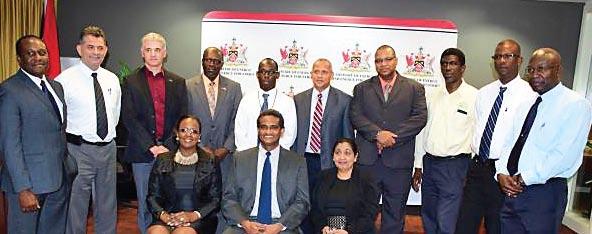
56 Corporate Sustainability Review
LoCAL Content CHAMPIon (continued)
Members of the Permanent Local Content Committee. Seated at front - Chairman Anthony Paul is flanked by Vice Chairman Ms. Anita Hankey and Board Member Ms. Marla Dukharan
T HE O BJECTIVES OF THE P ERMANENT LOCAL CONTENT COMMITTEE (PLCC) INITIATIVE
The PLCC was initially constituted in March 2004, in accordance with the Local Content and Local Participation Policy Framework that was approved by the Cabinet in October 2004. After a period of inactivity, it was reinstituted in March 2016.
The objectives of the Reconstituted PLCC are defined in its Terms of Reference (TOR):
a) To review the policy document on local content and local participation in with specific recommendations on the desired levels of local content to be contained in energy sector projects.
b) To devise strategies to increase local content and local participation in all energy sector projects.
c) To liaise with all stakeholders to promote local content
d) To prepare a list of activities involved in projects that ought to have a specific level of local content over the short, medium and long term.
e) To review definitions and terms to determine a benchmark for local content, for example, local company.
f) To liaise with the Work Permit Committee of the Ministry of Energy and Energy Industries to ascertain the national requirements for the recruitment, training and development of local staff and the transfer of knowledge and the transfer of technology to the services sector.
g) To investigate projects in which imported technology could be unbundled and devise mechanisms to ensure local companies are contracted.
h) To monitor the infrastructure needs (gas, water and electricity) to facilitate and improve the local content capability, for example fabrication yards, industrial estates.
i) To establish an appropriate methodology for monitoring the achievement of local content targets.
j) To compare the cost of goods and services offered and contracted by the international companies in relation to local businesses.
k) To undertake all other activities that could assist the Committee in carrying out its mandate.
Note: The PLCC has recognised that most of the activities necessary to implement the Local Content and Local Participation Policy Framework are obligations under the existing Petroleum Act and Regulations and many have been reinforced in Production Sharing Contracts (PSCs) since 2004. The provisions in these governance instruments also apply to sub-contractors and agents of Contractors/Licensees and require reporting to and monitoring by the MEEI for major aspects of local content and participation measurement and certification. These provisions were instituted in keeping with the deliberate desire of the government, at Independence, to utilise the petroleum sector to sustain levels of production and employment, maximise value retention and support national development in a manner “consistent with our status of a newly independent nation”.
Given the existence of these strong and well-crafted legislations, the PLCC determined that what was needed was for the Ministry of Energy & Energy Industries to develop and institute operational guidelines, systems and procedures, for ensuring that skills are developed in locals , foreigners replaced in a timely manner, local suppliers afforded the opportunities to participate and grow and that the operating companies report on their activities and results in these areas, allowing for inspection, monitoring and reporting.
Corporate Sustainability Review 57 LoCAL Content CHAMPIon (continued)
sPeCIAL seGMent Local Content and CsR
sPeCIAL seGMent
Local Content and CsR
MA x IMIZI n G PARt ICIPAt I on eXCeRptS fRom tHe loCAl Content & loCAl pARtiCipAtion poliCy & fRAmewoRk foR
tHe RepubliC of tRinidAd And tobAgo eneRgy SeCtoR
In its 2004 Policy Framework, the Government of the Republic of Trinidad and Tobago outlined the major mechanisms for local content, participation and capability development – i.e. where, how and by whom these will be delivered; the performance measurement, assurance and reporting processes to be used; and some key areas for priority focus.
The objective as articulated in this document, stated that “the country will maximize the level of participation of its national people, enterprises, technology and capital through the development and increasing use of locally owned businesses, local financing and human capabilities in the conduct of all activities connected with the energy sector, along its entire value chain, at home and abroad.”
Definitions
The Government shall consistently define local content in terms of the level of ownership, control and financing by citizens of Trinidad and Tobago, in conformity with internationally accepted norms and the key tenets of international conventions, such as General Agreement on Trade in Services (GATS). In order to achieve the goal of maximum local content and participation, the Government shall ensure that all participants in the energy sector are selected, engaged and managed in a manner that:
1. Identifies WHERE local value-added opportunity capture exists from the sector by:
• Selecting, from time to time, specific goods or services for focusing the local content, participation and supply capability development efforts;
2. Determines HOW to enable delivery of maximum local value-added by:
• managing the programme of activities in the sector as a portfolio, so that project pace and scheduling enable the maximum opportunity for development of local capabilities and their sustainable utilisation;
• targeting local capability development by increasing the amount, depth and breadth of
”in country“ activities, so as to enable fuller participation of nationals and enterprises in the value chain;
• giving preference, firstly, to locally owned, controlled and financed enterprises, then to those that demonstrate a clear culture, commitment and capacity for maximising local value-added, participation and capability development, consistent with the country’s aspirations and vision;
• focusing on improving local skills, business know-how, technology, financing, capital market development, and wealth capture and distribution;
3. Ensures DELIVERY of maximum local value-added by:
• aggressively promoting and rigorously applying this policy wherever State controlled resources are involved;
• facilitating the development of local capability to enable local value-added;
• removing barriers for local participation;
• setting targets of local content and participation that will be assigned to individual projects, operations and/or operators and supporting these targets with appropriate contract terms;
• measuring and reporting on the performance of operators in the sector;
• periodically comparing the local content and participation performance amongst operators, between projects and operations and with other countries, to establish benchmarks, targets and opportunities for improvement and for the transfer of best practices.
Vision and Policy
The Vision and Policy sets out “to achieve the goal of maximising value for the country from its assets, the Government and people of Trinidad and Tobago shall participate in the business of oil and gas and engage external
58 Corporate Sustainability Review
participants in a manner that captures value.” This is on two fronts:-
1. Fiscal measures - through the use of
i. taxation and royalty policies and
ii. government expenditure to capture value from the sector and to extend it by building local capabilities that support the sector’s growth.
2. Non-Fiscal measures – through
i. Local Participation - maximising the depth and breadth of local ownership, control and financing, in order to increase local valuecapture from all parts of the value chain created from the resource, including those activities in which nationals, local business and capital are not currently engaged, at home and abroad;
ii. Local Content - maximising the level of usage of local goods and services, people, businesses and financing.
iii. Local Capability Development - maximising the impact of the ongoing sector activities, through the transfer of technology and know-how to;
a) enhance, deepen and broaden the capability and international competitiveness of our people and businesses within the sector; b) create and enhance capabilities that are transferable to other sectors within Trinidad and Tobago; and

c) create and support cluster developments with other industries that have a natural synergy with the energy sector and which may have the capacity to diversify and/or sustain the economy after the resource is depleted.
“Local Content and Participation” - collectively referred to as “local value-added” - will be defined in terms of ownership, control and financing by citizens of Trinidad and Tobago. While, typically, the themes of “local content and participation” have focussed primarily on the aspects of “in country” activity, Trinidad and Tobago recognises that the energy sector has tremendous potential to develop local capabilities that are essential for the capture of further opportunities outside of the country. This potential is not achieved unless there are specific strategies to do so. This policy framework addresses local content and local participation in a manner that:-
i. will maximise utilisation and development of Trinidad and Tobago nationals, businesses owned by nationals and the domestic capital market in every aspect of the activities conducted in the sector.
ii. recognises the impact of other mechanisms for maximising local value-added in the short term, while building capability for increased value capture now and in the future.
iii. seeks to ensure that Trinidad and Tobago does not overlook opportunities provided by activities in and, in support, of the sector so that:- (i) supporting energy sector policies and strategies on human and enterprise development will be consistent with this policy framework, (ii) all Government and Stateagencies, regulations, strategies and contracts are aligned with these policies, and (iii) all policies will be rigorously applied to ongoing, proposed and future individual projects, operations and suppliers of goods and services in the energy sector.
For more information on Trinidad and Tobago’s LCP go to www.energy.gov.tt
Corporate Sustainability Review 59 sPeCIAL seGMent
and CsR MAxIMIZInG PARtICIPAtIon... (continued)
Local Content
sPeCIAL seGMent Local Content and CsR
I n GU yA n A By GU yA nese guyAnA’S loCAl Content poliCy
Creating and Retaining Value for the Guyanese economy Highlights of the Third Draft of the LCP Framework
LCP Objectives
The Local Content Policy (LCP) for Guyana is now in its third iteration and set for implementation. This version of the policy has interpreted Local Content to mean “The active participation and development of Guyanese labour and suppliers in the petroleum sector and the benefits that arise from expenditure in the sector on labour, goods and services for Guyanese industry, the economy and wider society.”
“The primary goal of this policy is to facilitate the active participation and development of Guyanese labour and suppliers in the petroleum sector and to give rise to benefits from expenditure in the sector on labour, goods and services for Guyanese industry, the economy and wider society. In an effort to maximise benefits and retain long-term value from Guyana’s petroleum resources, considerable focus shall be given towards local capacity development in addition to local participation.”
The Guyana Government has determined that the LCP “will be implemented over time and in tandem with the growth of the industry. At present, Regulations will not be promulgated, but may become necessary as the industry unfolds and expands, and impetus is needed to steer the process or to solidify gains.”
The revised policy framework acknowledges “the need for continuous review, so as to update the position of the Government of Guyana in all aspects of managing our petroleum resources for national development. Even though aimed at our petroleum resources, this policy framework may be replicated in other industrial sectors so as to bring about similar benefits, and to protect the viability of these sectors from the outward movement of human and capital resources into the petroleum sector.”
Policy Statement
“This policy recognises that the petroleum resources of Guyana belong to all its people, and represent an asset of significant intrinsic value, which, once removed, diminishes the wealth of the nation, unless there is transformation in value from resources below the ground to improved quality of life above it, for current and future generations of Guyanese
persons. This shall involve utilization of revenues from hydrocarbons to transform the contribution to our economy and country from agriculture, finance, tourism, mining and other non-hydrocarbon sectors…”
“Guyana shall approach the development of its petroleum resources, people and businesses in a pragmatic, collaborative, transparent, flexible and accountable manner, but with clarity of purpose. This will be conditioned by existing circumstances and an analytical approach to understanding the resource, the activities it engenders and our input capabilities. We shall aggressively pursue strategic opportunities for local capacity development and participation that give us the maximum possible benefit now and, in the future, and we shall ensure that effective government oversight, instruments and administrative institutions are in place, properly resourced and functioning adequately, such that stakeholders are held accountable…”
.
“To maximise the benefits of the petroleum sector for local employment and local businesses, investors, Operators and their Primary Contractors shall participate in a manner that gives Guyanese persons and Guyanese Suppliers fair and adequate opportunity and first consideration where capable and competitive to provide labour, goods and services and improve and enhance their capabilities, and in so doing become internationally competitive and progressively provide a greater share of future labour and services to the sector…”
“In our desire to enable more value retention for the Guyanese economy from expenditures in the petroleum sector, costs related to local content participation and capacity development for Guyanese labour and suppliers, including those which are costs recovered by investors and therefore paid for by the people of Guyana, shall be seen by Guyana as our investment in our people…”
“Because of the size and speed of discoveries in the upstream petroleum sector, realising the best chance for Guyanese persons and suppliers to access the opportunities requires the matter of local content and value retention to receive special attention now. This policy framework therefore precedes the
60 Corporate Sustainability Review
overall petroleum sector policy of the Government, and shall be updated from time to time to be aligned with sector and national development strategies and policies. A subsequent overarching national policy for the petroleum sector is being developed and shall provide the broader framework within which Local Content in mid and downstream petroleum activities shall be applied, and the risks of the sector for resource movement effects and other aspects of the resource curse, ameliorated. Further, the government may expand the scope of this local content policy to other industrial sectors to mitigate the risk of resource movement effects.”
Policy Objectives
The goal of this policy is to achieve the active participation and development of Guyanese persons and suppliers in the petroleum sector and maximise benefits and retain value for Guyanese industry, the economy and wider society from expenditure in the sector on labour, goods and services. In support of the goal, the objectives of this policy are to:
• be fit-for-purpose…
• ensure the education, inclusion and advancement of Guyanese persons with the expertise and experience required to participate in the petroleum industry;
• achieve participation of Guyanese persons in employment opportunities and Guyanese suppliers in procurement opportunities within the petroleum sector, within and outside of Guyana;
sPeCIAL seGMent Local Content and CsR
• localise supply chains in procuring goods and services that serve the petroleum industry to bring efficiency and cost benefits to the sector in Guyana…
• enhance the capacity of Guyanese persons and suppliers, and Guyanese public and private education and regulatory institutions, to align with good industry standards in the petroleum sector…
• use the opportunities presented by international companies operating in Guyana to grow the competencies of Guyanese oil and gas professionals and goods and services companies down multiple supply chains, becoming world-class and internationally-competitive, with local suppliers developing export potential;
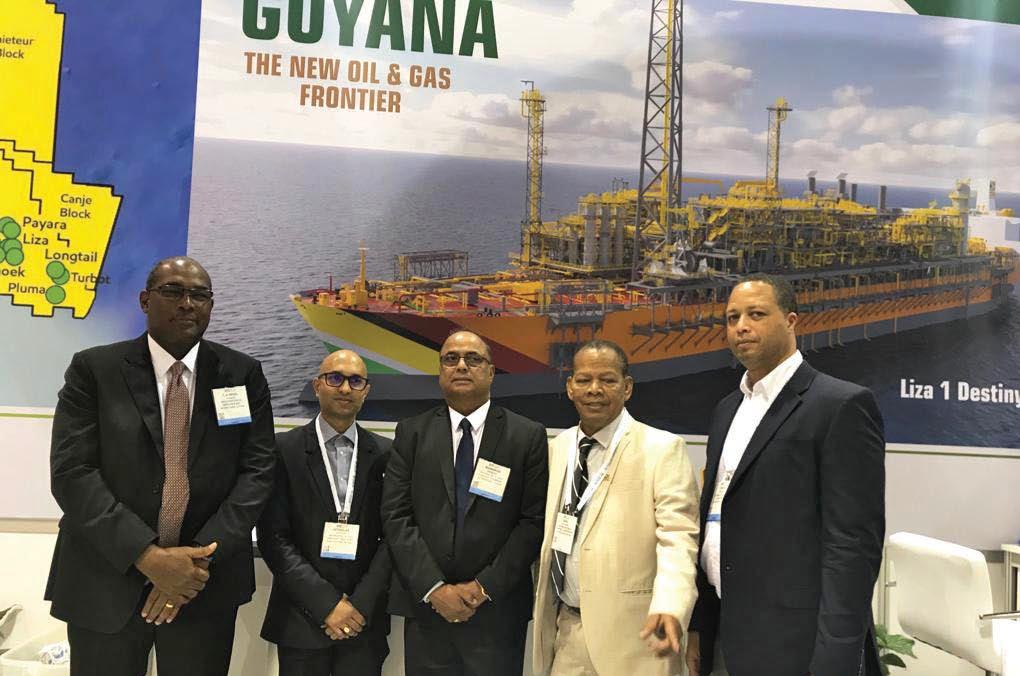
• retain value in the Guyanese economy through investments in the petroleum sector and in particular expenditures on local labour, goods and services…
• build Guyanese persons and supplier competencies, enhance other sectors of the Guyanese economy (i.e. achieve lateral economic linkages) …
• build and enhance institutional capacity in national education, training and research organisations, and in our utilities, infrastructure and facilities to support the petroleum sector, through collaboration of the Government of Guyana and private sector …
• invite partnering between firms for effective capacity building, transfer of knowledge and technology and to enhance the capabilities of Guyanese persons and Guyanese suppliers to participate as fully as possible in the petroleum sector. …
Corporate Sustainability Review 61
Representatives to the 2019 Offshore Technology Conference in Canada. Attorney-at-Law, Nigel Hughes; GCCI’s Senior Vice President, Nick Boyer; Energy Chamber President, Manniram Prashad; Government representative Basil Blackman, and GO-Invest Head, Owen Verwey. (Source - Guyana Chronicle)
In GUyAnA By GUyAnese guyAnA’S loCAl Content poliCy (continued)
The goal of this policy is to achieve the active participation and development of Guyanese persons and suppliers in the petroleum sector and maximise benefits and retain value for Guyanese industry, the economy and wider society.
sPeCIAL seGMent Local Content and CsR
• world class capacity in key state institutions and high-quality governance to implement this local content policy, which can act as a model to raise the standards of government services across the country, through collaboration of the Government of Guyana and private sector.
Core Principles
Guyana’s petroleum discoveries and this policy framework come at a time when several other developing economies have made similar, potentially transformative, discoveries of petroleum resources. These countries have begun to implement local content policies and legislation, with varying degrees of success. At the same time, a number of mature oil and gas producing countries have also made new discoveries or are deploying new technologies to extend production, and these governments too have implemented or evolved new local content policies and regulation. In the process of implementing policy, we shall continue to learn from both the successes and mistakes of others, especially those governments who have been successful in developing fit-for-purpose policy and regulation, and where local content is positioned as a catalyst for sustainable national development. (6:1)
The principle of fit-for-purpose includes:-
• Operator Local Content Plans shall be updated annually, informed by recent performance and current market information, including from Primary Contractors, describing estimated levels and activities and programmes for the utilisation of local content for the upcoming year;
• holding Operators to account for delivery of their yearly Local Content Plans through half-year and end-year Local Content Reports…
• use of yearly Local Content Plans and half-year and end-year Local Content Reports to review, learn and collaborate between industry and government to explore what is working in delivering local content and what can be improved…
• appropriate procurement procedures for the acquisition of goods and services that ensure that capable and competitive parts of the Guyanese supplier market are able to meet the necessary industry standards and thereby access opportunities…
... use of yearly Local Content Plans and half-year and end-year Local Content Reports to review, learn and collaborate between industry and government to explore what is working in delivering local content and what can be improved...
• incentivising innovation by Operators and Primary Contractors to find ways to give first consideration to capable and competitive Guyanese persons and suppliers... (6:2)
First consideration
In making decisions concerning recruitment and procurement to execute petroleum activities, Operators and their contractors shall give first consideration to Guyanese persons having appropriate qualifications and experience, and to Guyanese Suppliers where capable and competitive. Acknowledging that the use of new or unfamiliar labour and suppliers introduces an element of risk, the Government shall work with industry partners to minimize the risks, rather than completely avoiding them. We are confident that given the industry’s hallmarks of innovation and risk management, Operators and their Primary Contractors can come up with mutually-beneficial risk-based solutions that give first consideration to Guyanese persons having appropriate qualifications and experience, and to Guyanese Suppliers that are commercially competitive and able to provide goods and services on a timely basis and that meet the quality, quantity, financial and other technical requirements of the petroleum industry. (6:9)
• In exercising the principle of first consideration to Guyanese persons and suppliers, Operators and their Primary Contractors, shall:
- explore creative solutions to providing on-thejob training…
- identify categories of goods and services required for petroleum operations for which there is evidence of Guyanese suppliers having the required capability, capacity and price competitiveness to be considered for inclusion…
62 Corporate Sustainability Review
In GUyAnA
By GUyAnese guyAnA’S loCAl Content poliCy (continued)
sPeCIAL seGMent Local Content and CsR
- identify categories of goods and services for which there is evidence that there is no current capable and competitive local supplier market
- the government will look to the petroleum industry to demonstrate innovation in applying this policy of first consideration to help develop the Guyanese supply base…(6:9)
In making decisions concerning recruitment and procurement to execute petroleum activities, Operators and their contractors shall give first consideration to Guyanese persons having appropriate qualifications and experience, and to Guyanese Suppliers where capable and competitive.
Fair and Adequate
• Guyanese persons and Guyanese suppliers shall be afforded fair and adequate access to employment and supplier opportunities founded on the principle of being competitive against industry standards ...(6.10)
Local Content Measurement and Reporting
• Delivery of this policy shall be measured through standardized half-year and end-year reporting of local content performance to the Minister. Common metrics and definitions shall be applied across the petroleum industry in Guyana. The Ministry will use the standardized half-year and end-year reports to measure each Operator’s performance against the estimated levels and activities and programmes for local content utilisation in their Local Content Plan. (6.11)
• Reporting will inform the extent of flexibility needed to increase or decrease expectations for utilisation of Guyanese resources and personnel in future Local Content Plans, so as to ensure effective delivery of Government policy, take account of changes in the business environment, and consider any emerging
unintended consequences, for example, levels of utilisation leading to the movement of capital and labour out of other sectors of the Guyanese economy and into the petroleum sector. (6.11)
• The half-year and end-year reports will be used to continuously review and refine the opportunities and constraints in developing local content in Guyana and to inform how government and industry collaborate to drive local content development…(6.11)
Local Content Implementation
• It is the policy of the Government of Guyana for Operators to prepare and execute yearly Local Content Plans updated annually that operationalize the objectives and principles of this policy. Operator’s yearly Local Content Plans, and the information they contain, shall form the principal instrument of Government policy on Local Content in the petroleum sector. The objective here is that the Operator’s yearly Local Content Plan provides a forwardlooking, efficient, focused and flexible mechanism for government and Operators to identify, plan, implement and assure delivery of local content…(7.1)
• Local Procurement Opportunities - The Operator’s yearly Local Content Plan shall describe in general the process and evidence of efforts that the Operator, the Operator’s Primary Contractors, the wider petroleum industry in Guyana and the government have made to assess the supply of skilled, qualified and experienced Guyanese persons and capable and competitive Guyanese suppliers in meeting the demand of the Operator and its Primary Contractors for labour, goods and services in the upcoming year…(7.1.6)
• Local Content Utilisation Activities and Programmes - Operators shall describe in their yearly Local Content Plan activities and programmes that address
Corporate Sustainability Review 63
In GUyAnA By GUyAnese guyAnA’S loCAl Content poliCy (continued)
Guyanese persons and Guyanese suppliers shall be afforded fair and adequate access to employment and supplier opportunities founded on the principle of being competitive against industry standards ...(6.10)
sPeCIAL seGMent Local Content and CsR
employment and training of Guyanese persons and capacity development of Guyanese suppliers, as well as other capacity development initiatives such as environmental programmes, support for local education and training institutions, local research and development and investments in productive assets in Guyana… (7.1.8)
• Acquisition of Guyanese Resources - In relation to each of the discrete work activities described in the yearly Local Content Plan, the Operator shall provide a list of goods and services anticipated to be acquired directly, through partnerships or indirectly by the Operator or by Primary Contractors over the period of the Operator’s Local Content Plan, and provide an estimate of the utilization of Guyanese Resources… (7.1.8b)
• Supplier Development Programmes - In relation to the work activities described in the Operator’s yearly Local Content Plan, the Operator shall describe in their Plan programs of support and development to Guyanese Suppliers involving the Operator and its Primary Contractors… (7.1.8b)
• Other Capacity Building Activities and ProgrammesIn relation to the work activities described in the Operator’s yearly Local Content Plan, Operator shall include in their Plan other activities and programmes, unilaterally or in collaboration with other parts of the industry, that support capacity development of
Guyanese labour and businesses for participation in the petroleum sector…(7.1.8c)
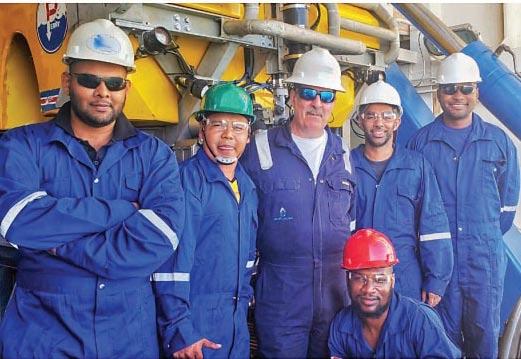
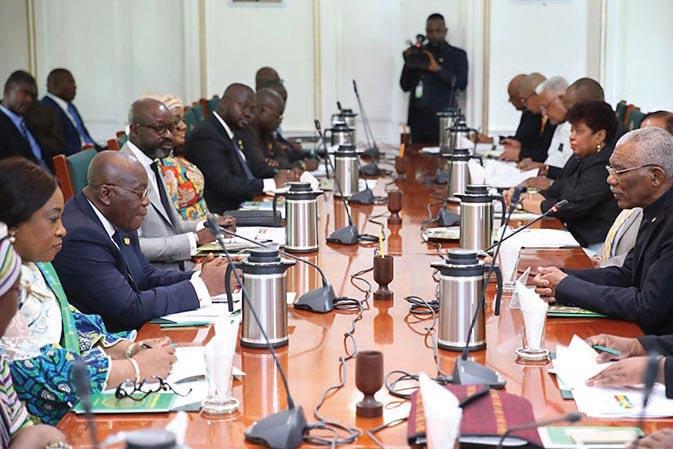
• Procurement Procedures - Operator shall describe in their yearly Local Content Plan the tender procedures of the Operator and its Primary Contractors that assure consistency with the principle of Government policy for fair and adequate opportunity to Guyanese Suppliers and sub-contractors in the supply of goods and services and with the principle of Government policy for first consideration ...(7.1.8c)
• Local Content Measurement and Reporting - The Operator shall gather information on progress in achieving the objectives, utilisation levels, activities and programmes described in their yearly Local Content Plan, sufficient to inform half-year and endyear Local Content Reports to the Minister…(7.1.2)
• Governance of Policy Implementation - The principle instruments of implementation for this policy are the Operator’s yearly Local Content Plans and half-year and end-year Local Content Reports. The Ministry has the sole authority to administer this policy including the review of the local content plans and the results of the Operators. The Operator shall permit an agent designated by the Minister to access the records of the operator and Primary Contractors for the explicit and sole purposes of assessment and verification of the local content information reported by an operator or Primary Contractors under this policy...(7.4)
These highlights are excerpted from the Guyana Petroleum Sector Local Content Policy - Making the Most of Our Oil and Natural Gas (A Local Content Policy Framework for Benefits Maximization and Value Retention from Guyana’s Petroleum Resources) of April 23rd 2019.
To view the current policy framework visit the Ministry’s website at https://www.business.gov.gy
64 Corporate Sustainability Review
President David Granger and his Ministers of Government engaging in bilateral talks with President Nana Addo Dankwa Akufo-Addo and his delegation during a high-level meeting at State House (Source - Guyana Chronicle)
Guyanese engineers trained in Subsea Robotics to support deep-water operations offshore Guyana
In GUyAnA By GUyAnese guyAnA’S loCAl
poliCy (continued)
Content
Unde R stA nd I n G Lo CAL Content I n G U yA n A A nd WH y I t MAK es G ood BU s I ness sense
Interview with Dominic Gaskin – Director of Business Ministry of Business
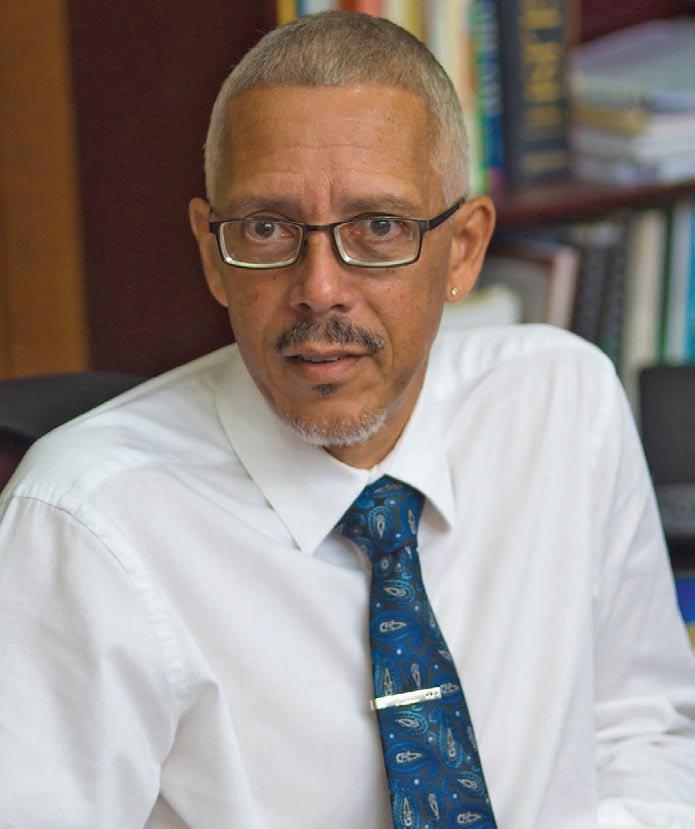
1. The principle of Local Content varies by degrees in various jurisdictions – for example in neighbouring Suriname and Trinidad and Tobago Local Content has been traditionally applied to multinationals in the Oil and Gas industry. Further afield by the Nigerian definition, Local Content policy is guiding other areas of business including expectations in the area of corporate social responsibility.
• Please define for us the term Local Content as expressed in the various Local Content documents. Is it accurate to say that Local Content is specific to jobs and procurement or is there a broader application within the Guyana context?
We have gone past the two iterations of the Local Content framework. We have now progressed this to a policy document – LC3. This now has to go to Cabinet for approval. Important stakeholders in business such as the Georgetown Chamber of Industry and Commerce (GCIC) are commenting and providing input before the policy goes before Cabinet.
In terms of definition, Local Content is interpreted to mean, “The active participation and development of Guyanese labour and suppliers in the petroleum sector and the benefits that arise from expenditure in the sector on labour, goods and services for Guyanese industry, the economy and wider society.”
In terms of application, the Guyana Local Content Policy is specific to the Oil and Gas sector – and specifically downstream. At some point Local Content will address all extractive sectors but for now, the focus has to be on oil and gas and on optimizing value and non-discrimination of local citizens.
2. The use of the word “pragmatic” appears quite a lot in the Local Content Policy V2 (LC2).
• Can you help us to understand what that means to you as Director of Business and why is it important as a guiding principle?
Pragmatic in this sense means ‘fit-for-purpose’. While the word is mentioned multiple times in the earlier iterations of the policy framework, in this latest policy document it’s mentioned just three times. Of significance
is the reference to Core Principles of collaboration and consultation. This requires the input of business, government and the ten regions. Certainly it must be attentive to the specific peculiarities of the jurisdiction – a significant world-class oil find and a very small economy. That reality also has to ensure we remain consistent to our obligations under existing trade agreements such as the Treaty of Chaguaramas, agreements with the WTO etc.
3. The Review understands that Guyana’s Local Content Policy is in part shaped by the experience of other oil rich provinces – you make mention of this in the context section of the LC2 iteration?
• Can you highlight some of the learnings from elsewhere that have shaped the country’s thinking and approach to local content? Who do you think has done this particularly well? Is there a role for the Ministry of Business in ensuring Guyana gets this right?
Corporate Sustainability Review 65
Mr. Dominic Gaskin - Director of Business, Ministry of Business
sPeCIAL seGMent Local Content and CsR
seGMent Local Content and CsR
Our engagement of consultants and international experts has provided a number of lessons. The notion of success varies by jurisdictions. Without naming any country in particular, some policies have been too stringent and therefore failed to achieve the intended objectives. Other countries as in the example of Norway, have established sovereign wealth funds that deliver benefits more widely.
The Ministry of Business, in working collaboratively with the Ministry of Energy Resources and the Department of Energy along with consultants and experts – both Guyanese and international, has determined that a more evolutionary approach to Local Content delivery is critical to optimising oil and gas benefits for all Guyanese.
4. The LC2 policy mentions Joint Ventures as a way of fostering local content. This has been particularly difficult to do in other countries and has sometimes led to benefits accruing to just a few business people. • Can you explain the way you see this mechanism enabling true local capability development and technology transfer?
If handled right Joint Ventures certainly have benefits for us. While we believe that our local companies and persons should benefit from the income flows to be generated by the sector, many of them do not and may not be able to meet the requirements.
Our private sector is very much interested in JV’s and they see it as a means of building capacity, improving standards, strengthening management systems such as Health, Safety, Security and Environment (HSSE) and ultimately growth. Certainly JVs provide the means for acquiring technology and know-how.
The Centre for Business in Georgetown has been pivotal in getting people trained up, in networking companies and familiarising others with information and knowledge about the industry. This is important in preparing and positioning Guyanese ahead of First Oil.
JVs provide a good way for local companies to work and grow alongside others; and this also helps to retain value in country. However JV constructs are not mandatory for doing business. Having a JV in itself just to satisfy requirements will not benefit anyone.
5. We refer to the policy framework statement, “We shall be pragmatic enough to recognise our limitations and those of our industry and only invest in those
that are “viable and sustainable.” (Page 22) Specific to this statement and how it relates to the issues of supplier development which is listed as a priority area, can you respond to the following:-
• What mechanism will be used to determine from among existing suppliers? For example, will some “winners” be a chosen few, or will they all be developed and then allowed to compete for work?
There’s a cost attached to supplier development. Not everyone who says I want to be a supplier can be one. The mechanisms for reporting will help to determine those who can and those who can’t make it.
The reporting mechanisms that are in the policy, identify two categories of suppliers for the operators – Category A being suppliers who meet the requirements or have demonstrated come capacity to deliver on requirements; and Category B being suppliers who cannot meet or have no capacity to meet requirements. . The burdenof-proof is on the operator to prove the incapacity or inability of the supplier to deliver under Category B reporting. Specific to Category A, the expectation is that operator must make provisions to prepare fair and adequate opportunity for such participation, giving Guyanese companies first consideration.
We must however be sensible in our expectations. This is a finite resource – current discoveries suggest perhaps 30 years or so. If the capacity is not there, can it be developed? Does it make sense to develop it for an industry with a limited shelf life? It might be more practical to develop capacity where that capacity or skills can be transferred to other sectors. This isn’t a renewable resource and therefore the wealth earned must be used to strengthen our other sectors. Investment in capacity building has to be carefully examined within the context of net benefits.
6. There is mention of an implementation mechanism in the LC2.
• Can you explain some more how this will be “performance managed” in the case of JV’s and more generally?
• How will companies be held accountable for delivering in this agenda, who will monitor this and how will “sanctions’ work for those who are not “complying” with the “letter and spirit” of the policy?
There is neither explicit provision for Joint Ventures nor punitive measures for compliance within the policy at
66 Corporate Sustainability Review
UndeRstAndInG LoCAL Content In GUyAnA And WHy It MAKes Good BUsIness sense (continued)
sPeCIAL
sPeCIAL seGMent Local Content and CsR
this time. Operators are required to submit an annual plan for Local Content delivery and to also submit halfyearly reports. Plans and reports must capture number of employees, number of contracts, details on such contracts etc. The output of those plans and reports will provide a continuous flow of information and data that will guide adjustments to the policy over the next year or two.
We have great expectations and we want to realise them, but there is a learning curve here. We are familiarising ourselves with a new industry and we have limited capacity. We believe that if operators do what they should do, we can then move to the stage of legislation.
7. As mentioned in the policy, Guyana has a long history of mineral extraction. Oil is different but has some similar features to the bauxite industry; maybe less so to gold.
• Why will the country succeed this time – has that history shaped the current thinking?
Not really. We are not drawing examples from any of the other extractive industries. Rather we are looking at the energy sector globally as our reference. From public discourse, there is a general reluctance to compare the benefits to be gained from Oil and Gas to benefits from gold or bauxite. Our lessons are being drawn from other jurisdictions and shaped largely by investor interests and local interests in transforming our country.
8. What will make Guyana succeed when many others have had less than stellar achievements in managing this area of oil sector development?
I think there are 2 things. One is the relative size of our population to the scale of the discoveries. This makes us per capita, the largest producer in the world. It’s kind of difficult to mess that up. We don’t have a lot of people to address.
Secondly, so much is being done, discussed, developed and put into action even before the first drop of oil, that we are more prepared than many. We are benefiting tremendously from the experiences of others. While some bigger countries have still been unable to use oil and gas resources to improve the lives of all its citizens; Trinidad and Tobago for instance has used its oil and gas sector to improve per capita income and to become globally competitive.
9. In terms of ease-of-doing-business in Guyana. The World Bank Report for 2019 places Guyana at 140 on a list of 190 countries and some reports describe the process as cumbersome and lengthy. Do you agree with this?
I have no grounds on which to disagree with the report but we have spent the last four years going through the indicators and know where the deficiencies lie and we know that these have to be addressed. This requires strong political will and I am encouraged by the fact that over the last year the Government has been placing emphasis on the ease of doing business - not just for foreign investors but to make the local private sector more competitive.
I believe that with the benefits of increased revenues we can fix bureaucracy. For example, we can reduce paper work and the inefficiencies and malpractice that come with this, through digitization and integrated network systems. Certainly by the year 2025 almost every Government agency will have digitized its processes and integrated its systems.
Other areas will also benefit - areas like finance. There are imperatives for local supplier development that will require access to capital to grow and to compete. This is so not just for big businesses but for the SMEs as well.
10. Guyana has been described as entering into the Transformational Decade. How do you respond to this notion?
There is every expectation on the part of every government official and person. It is happening but I guess the question is how transformative? Transformation is one thing but development is another. What we want to see with the inflows is national development and economic growth in its truest sense along with increasingly higher levels of productivity.
Corporate Sustainability Review 67
UndeRstAndInG LoCAL Content In GUyAnA And WHy It MAKes Good BUsIness sense (continued)
sPeCIAL seGMent Local Content and CsR
A Lo CAL Content P o LICy F o R GU yA n A: mAXimizing eConomiC benefitS
Increasing hydrocarbons finds offshore Guyana will offer significant opportunities to the country to fast track economic development and ensure that public welfare improvements are delivered to the citizens. One approach to doing so which should be adopted is to develop a productive and progressive Local Content Policy (LCP). An industry integrated LCP will enable Guyana to capture the benefits of foreign direct investment by imposing conditions on foreign investors to ensure value addition in the country. However, Guyana’s current challenge is how to design the policy to reflect its unique economic development needs and local conditions.
What is Local Content?
Guyana’s local content policy [and laws] must define explicitly the term “local” in local content. What local means can only be deciphered in their definitions of local content. For some countries (Nigeria, Ghana, Angola, Equatorial Guinea, Tanzania and Indonesia), local content is defined as:
1. The quantum of composite value added to or created in the economy by a systematic development of capacity and capabilities through the deliberate utilisation of the native citizens, material resources and services in the oil and gas industry.
2. The quantum or percentage of locally produced materials, personnel, financing, goods and services rendered in the petroleum industry value chain and which can be measured in monetary terms.
3. The added value brought to the country in the activities of the oil and gas industry in the economy through the participation and development of local citizens and local businesses through national labour, technology, goods, services, capital and research capability.
4. The added value brought to a host nation (and regional and local areas in that country) through the activities of the oil and gas industry.

The purpose of developing national local content policies is to increase the value generated by the exploitation of a resource that remains in the domestic economy; and to develop linkages between the oil sector and the rest of the economy.
Moreover, local “local” content is consistent with what Warner (2007) has termed “community content”, i.e., the interface of community investment programmes with local content, which consists of the strategic deployment of local participation and local capability development opportunities arising from an oil or gas project, specifically directed to strengthen the sustainability, relevance and political visibility of community investment programmes.
Community content is about realising a competitive advantage for the oil company in the eyes of both the local population and the country’s guardians of economic policy. The distinction between community content and local content programmes is that whereas the former is a merit good directed at supporting those adversely affected by extractive resource projects, local content programmes represent public good(s) although from a global perspective they may also be regarded as merit goods in that they give privilege to nationals and firms from within the country as against other nationals and firms.
68 Corporate Sustainability Review
sPeCIAL seGMent Local Content and CsR
Therefore, what matters is not only what happens in the sector, but what happens beyond. As such, local content can encompass forward, lateral and backward linkages. Backward linkages are those created by the commercial relations between oil operators and their supply chains, which include the transfer of technology and know-how, employment of nationals, and sourcing local goods and services. Lateral linkages utilize the demand of the sector to develop skills, services and infrastructure that can positively impact on other sectors of the economy while allowing locals to participate in the petroleum supply chain. Forward linkages involve the construction of facilities that process and export these resources, such as refineries and petrochemical facilities.
Meaning of LCPS
LCPs are a requirement that a given percentage of domestic value-added, or domestic components be embodied in a specified final product (Grossman 1981). They are regarded as a form of productive development policies whose goal is to strengthen the productive structure of a particular national economy (Melo and Rodríguez-Clare 2006). They are designed to increase local participation in foreign direct investment by directing the utilization of local companies in goods and services procurement, the employment of locals and the use of local raw materials by investors. Other measures include tariffs, taxes, pricing, licencing and concession systems that are skewed in favour of local industries or aimed at facilitating the creation of local content by investors as well as local firm reservations for certain inputs and services.
LCPs require firms, particularly multinational firms operating within a country’s territory, to give first consideration or deliberate preference to the country’s nationals in matters of employment and training, and in the procurement of goods and services. The requirements are either embedded in contractual agreements between governments and companies or enacted legislatively. In some cases, they are established in bidding rules as a precondition for winning contracts or embedded more indirectly in regulation and tax regimes through provision of incentives to local industries or to other companies that support local participation.
Benefits of the Use of LCPS
These policies will help to correct market failures which arise when there is a distortion that keeps the market from
allocating resources efficiently and adjusting to a steady state, with the result that domestic industries cannot gain the necessary technology and capacity to compete on the open market without outside intervention and protection (Tordo et al 2013). The market fails from a domestic perspective, because the lack of domestic skills to serve the needs of the industry results in an inefficient allocation of resources in the market. By requiring companies to invest in the development of particular local skills, LCPs can help to correct this market failure because such requirements help to ensure that skills are available to meet the demands of the market. There is an inherent good in a country developing its own technical skills to meet the demands of its industries. It enhances entrepreneurship and can contribute to poverty reduction.
LCPs will help domestic Guyanese firms to integrate themselves into global economic networks. This is confirmed by studies which show that in the 1990s, both local “productivity-enhancing entrepreneurship” and state support to local development helped East Asian firms to achieve significant positions in global economic networks (Gereffi 1995). LCPs will contribute to the productivity and competitiveness of domestic Guyanese firms through knowledge transfers that take place from foreign firms to domestic firms. It has been noted that that most advanced economies utilized industrial policies similar to LCPs to boost their domestic economy while in the early stages of their industrial development (Whitfield et al 2015).
Therefore, the degree of local content in the production of a commodity can be defined by the share of local inputs (labour, capital, intermediate products) that are used in its production and the share of local ownership of the production companies (Kolstad and Kinyondo 2017). Hence, the aim of a local content policy is to increase the degree of local benefit in the various value chains; beyond what it would be in the absence of such policies. This typically involves increasing the share of nationals working in the extractive sectors and increasing the participation of local companies in the supply chains. Normally, the overall purpose of an LCP is to ensure a more equitable distribution of the resource rents and to make sure that the local community also benefits from the extraction.
Thus, the local market could be used to ensure that resource extraction is done in the most efficient way with an optimal use of inputs. This could maximize the amount of revenue for
Corporate Sustainability Review 69 A LoCAL Content PoLICy FoR GUyAnA: mAXimizing eConomiC benefitS (continued)
sPeCIAL seGMent Local Content and CsR

the government, which could then be used for development purposes. Including local labour and companies is an investment in the future rather than a cost; these workers and companies would be capacitated to generate higher income in the future due to the knowledge, skills or technology enhancement derived from participating in the sector (Kinyondoa and Villanger 2017). Building domestic companies through their participation in the extractive sector can contribute to the development of these companies into more advanced entities that can, in the future, engage in highly productive activities outside of this sector. Hence, the establishment of a stronger local industry now will generate larger future flows that will compensate for the lower current revenue flows.
The extraction of natural resources can have enormous implications for many parts of an economy irrespective of any LCP, including government revenues, public expenditures, investments, salary levels, demand for labour and expertise. Moreover, the resource rents are usually much larger than the economic value of any local content generated. Hence, government management of these incomes (taxation, expenditures, macro management, and so forth) is likely to play a more important role in poverty reduction and development than even the most effective local content requirements. In addition, there is likely a tradeoff between the use of the resource revenues for LCPs and other welfare-enhancing and poverty-reducing investments (such as education, health, and infrastructure) that could be important.
Therefore, one key option for Guyana is to adopt a localist approach for its LCP. A localist approach can be utilized to address a number of other problems associated with extractive resource development that have historically impeded other sectors of the local economy from fully realizing the potential benefits of the extractive resources. It can also be used to improve company-community relations. It can be used to partially compensate the local resourcebearing communities for any negative impacts of oil and gas development.
Developing the new petroleum industry for Guyana will require a nudge from the government. The nudge can take the form of subsidies, loans, infrastructure and other kinds of productive-enhancing support. The adoption of stringent local content targets that do not take into account the skills gap in the country may hurt rather than help the realization of the potential of the LCP to fast-track the economic development in Guyana. To benefit optimally from the LCP, however, it is important for an emerging oil and gas economy such as Guyana, to inject transparency measures into the design and implementation of the policy to avoid or reduce the likelihood of elite capture of the benefits of the policy. The policy option to be adopted by the country, for the exploitation of the oil and gas resources, must bring maximum benefit to the citizens. The LCP should be taken into account to the extent that it is considered in the country’s wider industrial policy aimed at economic diversification and transformation.
70 Corporate Sustainability Review
A LoCAL Content PoLICy FoR GUyAnA: mAXimizing eConomiC benefitS (continued)

73 Kyle santos
Understanding Your Company’s Social Impact

76 saarah Khan
The Circular Economy- Global Lessons for the Region
78 Michelle Palmer-Keizer
Getting it Right-Developing Writing Tips for NGOs
81 Jaysen Francis
Why Local Content and CSR Matters
oPI n I ons
Unde R stA nd I n G yo UR Co MPA ny’s so CIAL IMPAC t
by Kyle Santos
Trinidad and Tobago continues to face a maelstrom of economic, social and environmental challenges. A sputtering economy which remains dependent on oil & gas revenues, high crime rates, embedded corruption, a worsening and complicated refugee crisis, ubiquitous land and marine pollution, creaking public infrastructure and institutions, a lack of public trust. The list makes for depressing reading.
No one is immune to these challenges, meaning everyone has an incentive to help solve them. Government, the private sector, NGOs and individuals all have roles to play. Many companies contribute through core business activities and CSR programmes, some more than others. However, only a handful actively measure what actually happens as a result of their contributions.
This matters. Not just from a communication perspective, but because of the old adage ‘what isn’t measured, isn’t managed’. How can you be sure your company is creating positive change if you aren’t making an effort to understand the impact it is having? How do you know your limited resources are being used in the most efficient and effective ways? This article seeks to answer some of these questions by describing what businesses can do to measure, communicate and bolster their efforts to help solve some of our country’s greatest challenges.
An introduction to Social Impact
According to the European Commission and the Organisation for Economic Cooperation and Development (OECD), social impact relates to the social value produced by for-profit or non-profit organisations. Usually, it is expressed in line with the following principles.
• Value is created or destroyed as a result of activities of persons or organisations;
• Value is experienced by beneficiaries and all others affected, including employees;


• Impacts may be positive or negative; and
• Impacts should be judged against what would have happened in the absence of the activity in question.
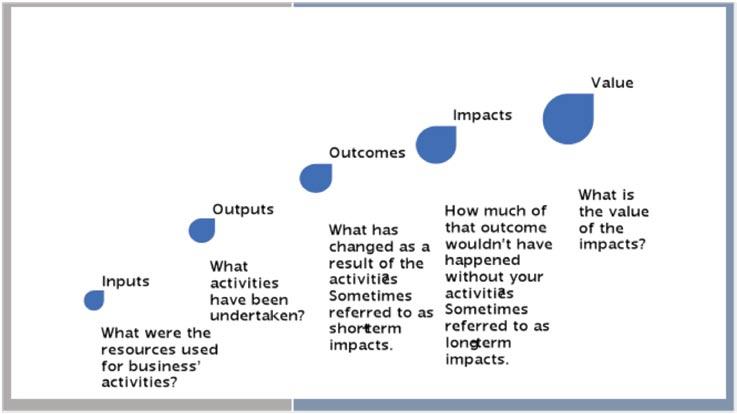
Local Operating Context
In a challenging economy, CSR budgets are guaranteed to feel the strain. The ability to measure and communicate the social or environmental benefits resulting from CSR programmes can go some way to relieving this pressure. This is not lost on the local business community. Several companies have started to think and communicate in terms of social impact. In its 2017 Sustainability Report, Atlantic LNG described how its business inputs and corporate strategy combine to create value for the local economy, communities and the business. It also reports on the number of individual beneficiaries of its community investment. NGC’s first Sustainability Report (2017) outlines how the company’s economic, social and environmental contributions help it achieve its vision of being a ‘leading player in the
Corporate Sustainability Review 73 oPI n I ons
kyle Santos
The impact continuum illustrates the impact journey, from inputs to value creation.
energy value chain, delivering sustainable benefits, through our people, for all stakeholders’. More recently, the Maritime Financial Group launched its Social Investment Strategy –Our Children, Our Future - which outlines focus areas and partner organisations, as well as the inputs and outputs that will be measured to track progress.
These efforts are laudable and should be encouraged. However, a word of warning. There are knowledge and expectation gaps between what organisations want and what they can realistically achieve in the short term. Few of the companies that want to measure their social impact have these skills in house, or have monitoring and evaluation processes in place to collect the data required. This is before even considering the significant challenges of counterfactuals, causality and attribution, which are fundamental components of robust impact measurement.
The reality is, unless your organisation has been measuring its CSR inputs and outputs and making use of the data in decision making and reporting (as a minimum), there is work to be done before it can think about measuring its short or long-term social impacts (the latter of which is substantially more difficult).
“Surely measuring impact matters, but we need to be realistic about the constraints. It requires a level of research expertise, commitment to longitudinal study, and allocation of resources that are typically beyond the capabilities of implementing organizations. It is crucial to identify when it makes sense to measure impacts and when it might be best to stick with outputs — especially when an organization’s control over results is limited, and causality remains poorly understood.”
Ebrahim. 2013. Harvard Business Review
Getting Started
Despite this, there are a number of steps companies can take to move towards impact measurement.
1. Articulate the positive social or environmental impacts you wish to have and identify how you can boost your CSR programme’s ability to deliver these.
2. Use tools such as Logic Models or Theories of Change to map how these impacts can be achieved and identify the potential inputs, outputs and outcomes.
3. Determine what data is already available within your organisation or from NGO partners.
4. Implement processes to collect the data you don’t already have access to, starting with input and output indicators.
Logic Models are tools used to describe the effectiveness of programmes. They describe linkages among programme inputs, activities and outputs, and short and long-term impacts. Once a program has been described by a logic model, critical performance metrics can be identified. They are relatively simple graphical depictions of processes that communicate the assumptions upon which an activity is expected to lead to a specific result (McCawley, undated).
Theories of Change are more complex and robust than Logic Models, but there is no requirement they be used in their place. They provide a detailed description and illustration of how and why a desired change is expected to happen in a given context. In so doing, they map out how activities lead to desired goals being achieved (Center for Theory of Change, 2017).
Regardless of the approach you choose to adopt, it is worth keeping a few things in mind. Firstly, start small by identifying an existing CSR activity with a clear goal to use as a pilot exercise. Secondly, impact assessments that ignore associated negative impacts, either from the CSR activity or from the organisation’s operations, are incomplete. You should consider your negative impacts and ways to minimise them. Finally, remember that CSR activities may also positively impact your own staff through improved morale, enhanced skills and so on. In many cases these internal impacts manifest themselves in a shorter timeframe and are easier to measure, while having direct business benefits. As such, they may be a good place to start.
Things You Can Measure
The following are some of the things you should consider measuring as part of your CSR activities. They are not all impact related and this is not meant to be an exhaustive list. Additional information on these and other CSR disclosures may be found in international frameworks such as the Global Reporting Initiative (GRI), UN Sustainable Development Goals (SDGs), the UN Global Compact (UNGC), to name a few.
74 Corporate Sustainability Review oPI n I ons
UndeRstAndInG yoUR CoMPAny’s soCIAL IMPACt (continued)
AREA
Tax Contributions
Employment
Health, Safety and Security
PERFORMANCE INDICATORS
•Corporation Tax ($)
•Green Fund Levy ($)
•Total staff (#)
•Gender diversity of workforce and management (%)
•Total salaries and benefits ($)
•Training (hours, $ spend, % of staff)
Leading and lagging indicators, including but not limited to:
•Training
•Contractor management
•Near misses
•OSHA recordables and their frequency
•Occupational health and illness
Supply Chain
Volunteering
•Number of local suppliers (#)
•Spend on local suppliers ($)
•Number of volunteering events (#)
•Number of employee volunteers (#)
•Total volunteering hours (hours)
•Value of hours spent volunteering ($)
Financial and In-Kind Donations
•Number of beneficiaries (#)
•Value of cash and in-kind donations ($) (sponsorship is not considered CSR, it is marketing)
Environment
•Resource consumption (e.g. energy in kWh/mWh, water in m3)
•GHG emissions (tonnes of Carbon Dioxide - tCO2e)
•Total waste generated (tonnes)
•Recycling diversion rate (%)
This article is not meant to discourage companies that want to understand their social impacts. It aims to highlight common challenges and misconceptions, while providing practical advice on how to move forward. After all, ‘what isn’t measured, isn’t managed’ and Trinidad and Tobago’s challenges are in urgent need of proper management.
Corporate Sustainability Review 75 oPI n I ons
UndeRstAndInG yoUR CoMPAny’s soCIAL IMPACt (continued)
by Saarah Khan

In 1972, the Club of Rome published a report called “The Limits to Growth”. This was the first study done which questioned the “viability of continued growth in the human ecological footprint”. The report suggested that the linear economic model currently in use, was not sustainable given the increasing consumption rates, demand for raw materials, as well as the global production of waste, and suggested, given no change in the trends, the limits to growth on Earth would be realized by the year 2072. This was also concluded by the Swiss architect Walter Stahel, in the late 1970s, who proposed that this estimation was based on a linear economic model and hence formulated the concept of an “economy of loops”, which would later be referred to as the circular economy. He proposed that reforming of the economy by closing the material cycles to make better of resources and considering three pillars of sustainability: economic, environmental and social factors, the estimation projected by The Limits to Growth Report could be corrected.
A circular economy promotes a regenerative strategy to ensure the greatest value retention of technical and natural resources by “designing out waste and pollution, keeping products and materials in use, and regenerating natural systems”1. These strategies can provide benefits across the pillars of sustainability, as they offer increased economic growth, and job creation, significant resource savings, enhanced security with regard to the supply of raw materials, as well as significantly reducing the related impacts of climate change, given 67% of “global greenhouse gas emissions are related to material management”2.
As alarming as “The Limits to Growth” report was then, almost 50 years later, the world’s current economy is only 9.1% circular and the trends suggest, according to the Circle Economy’s ‘Circularity Gap Report’ that the projected trend is negative3. This poses the question how can we move away from a linear economy that is stuck in the “take-make-dispose” process of resource use, and strive towards a more circular economy?
Building a successful circular economy requires a change in mindset as at the core of the concept is systems thinking, looking at the broader perspective across multiple sectors and stakeholders. It also requires the optimization of entire processes, policies and systems, as it best functions on the concept that the “processes of production should be linked together to create a system without waste”.4
Several industry experts agree that there are four major building blocks of a circular economy.
1. Circular
Economy
Design – involves designing production processes to facilitate the “reuse, recycling and cascading”, not only making the process more efficient but also providing major economic savings in the long run, as evidenced by Circular London, the programme “established by London Waste and Recycling Board, who are leading Circular Economy Week – estimate that by 2036, a circular economy could deliver up to £7bn to London each year.”5
1 Ellenmacarthurfoundation.org. (2019). What Is The Circular Economy?
2 Arcadis.com. (n.d.). THE CIRCULAR ECONOMY WHAT IS IT AND WHAT DOES IT MEAN FOR YOU?
3 Circle Economy. (2019). The Circularity Gap Report: Our World is only 9% Circular.
4 Kenniskaarten - het Groene Brein. (2019). What are the environmental benefits? -Kenniskaarten - het Groene Brein.
5 Evening Standard. (2019). What is a circular economy?

76 Corporate Sustainability Review
oPI n I ons tH
Saarah khan
e C IRCULAR eCono M y – globAl leSSonS foR tHe Region
New Business Models
2. – this idea was mirrored by EIT Climate-KIC CEO Kirsten Dunlop at the World Circular Economy Forum in June 2019, where she argued that in order to create the kind of change needed, business models would need to orchestrate “innovation in such a way that it intervenes deliberately, systematically, across boundaries”6
Reverse Cycles
3. – focuses on the cycle of production from the user to the manufacturer and the strengthening of the post-usage value stream, as “value is embedded in the reuse, maintenance, refurbishment, and remanufacturing of components and products, so it is equally important to strengthen these reverse setups and capabilities”7
Enablers and Favourable System
4. – As with any system, for it to be effective there needs to be cross-sectoral collaboration and support to develop a society that will enable growth of the system. From policy makers providing incentives for industry and consumers through legislation, public awareness initiatives supported by educational institutions, and initiation of circular economy design processes within corporations, as echoed by Walewska Miguel, Coca Cola's senior manager for public affairs, communications and sustainability for the Caribbean and Venezuela: “We need everyone’s help. We need governments to help give incentives to develop the recycling industry. We need NGOs to develop awareness and education programmes and help us with the collection process.”8
One brilliant example of a city moving towards a circular economy is Amsterdam, which, as a city, in 2015 began their initiative to become fully circular by 2050. On September 25th 2018, together with Circle Economy, the city of Amsterdam launched the “Circular Journey of Amsterdam” which catalogues the over 70 circular projects that they have implemented since 2015, “evaluated across 7 policy instruments and 5 sectors”, with buy in and action taken across the city’s key stakeholders, such as the local government, the corporate sector and SMEs, as well as NGOs and research institutions.
Throughout their journey towards circularity the city has clearly outlined four necessary steps that were crucial in setting the process in motion.
1.
Setting ambitious goals and targets
Identifying starting points 2.
3.
Encouraging experimentation and implementation
Measuring progress and impact 4. 9
In the past year there has been a significant increase in the interest and use of recycled and recyclable products in the local market. The banning of Styrofoam and single use plastics in several Caribbean countries, corporations promoting sustainability initiatives, for example Massy Stores reusable bags and ‘recycle bottles for points initiative’, and the progress made to pass legislation throughout the region that align with the Sustainable Development Goals, such as the Beverage Containers Bill in Trinidad and Tobago are all welcomed initiatives. While this is encouraging, there are still many roadblocks to make this scalable throughout the region as “current climate change policies largely overlook the mitigation potential of circular economy strategies.”10 In order to make progress as a region we need to adopt a more holistic approach, such as the 4 building block framework or Amsterdam’s 4 step method outlined previously, together with securing the buy-in and cooperation from our governments and policy makers, corporate sector, NGOs and the general public.
6 Climate-KIC. (2019). WCEF 2019: "The circular economy in cities".
7 Towards the circular economy. (2019). Set up global reverse networks.
8 Hamilton-Davis, R. (2019). The circular economy. Trinidad and Tobago Newsday.
9 Circle Economy. (2019). How to kick-start a city's circular journey?
10 Circle Economy. (2019). New report: Policy levers for a low-carbon circular economy.
Corporate Sustainability Review 77 tHe CIRCULAR eConoMy – GLoBAL Lessons FoR tHe ReGIon (continued)
oPI n I ons
Proposals are those critical documents that connect projects to resources. But more than that, they connect people and organisations with shared interests and often, with shared values. In the area of Corporate Sustainability, when awarding funds, donor companies or organisations need to be sure that their investments will deliver the right impact.
Corporate sponsorship is most often monetary; but there are times that companies provide resources via mentorship programmes, training or infrastructure. They all add value which can be quantified in dollars. So how does a sponsor know that they are making the right selection when committing valuable resources? The answer lies in the proposal.
Despite the important role proposals play in the sponsorship process, few companies provide comprehensive guidelines on how to pitch for funding or corporate resources. Still, most companies will have a social investment policy or defined areas of interest which determine where they are willing to place their resources. The proposal is an opportunity to show alignment with these areas and it can be a critical distinguishing factor for the many sponsorship requests companies receive.
The Republic Group is one of the leading financial institutions in the region and like most businesses in the financial sector, receives hundreds of proposals each year for project funding. While most of these are from NGO’s, many come from SMEs seeking partnerships of investors, sporting organisations,

schools and even churches and religious groups. Republic Bank Limited alone receives an average of 2400 requests or proposals every year.
Michelle Palmer-Keizer is the General Manager, Group Marketing and Communications at Republic Bank Limited. She recently made a presentation aimed at educating NGOs seeking social investment dollars on some basic rules and guidelines in making the pitch.
She shared this with the Review as an educational piece for its readers and for those persons interested in improving their chances at success in competing for donor funding.
In summary, there are a few key elements that must be considered; i.e.

• What?
• Who for? (beneficiaries)
• Why? (value to community, business, society)
• What are the benefits? (outcomes)
• How do we know it works? (measurable impact)
Says Palmer-Keizer, “When it comes to donor organisations, the Bank’s decision to invest in a project or a programme depends on a lot more than available funds and a desire to help. Instead you will find that each organisation will have its own framework of considerations that influence the decision to approve or decline a funding request. These include strategic alignment, company values, employee engagement, brand reputation and perception, and expected impact, to name just a few.”
“The best proposal writers”, she explains, “are the ones who can keep these considerations in mind. They understand that a wellwritten proposal is an NGO’s opportunity to demonstrate that it can meet the donor’s expectations. While there is no one way to write an effective proposal, from my experience, the ones that
78 Corporate Sustainability Review
michelle palmer-keizer
Gett I n G I t R IGH t: P R o P osAL W RI t I n G tIP s F o R n G os
oPI n I ons
with Michelle Palmer-Keizer
get it right tend to have the following qualities in common.” THE INTRODUCTION - Connecting at a personal level
• Who are you?
• What can you tell us about your organisation?
• Who else makes up the organisation?
• Is your organisation a registered NGO or does it hold charitable status?
• How is the organisation structured?
• Is there a constitution?
• Is there a website or social media platform that can provide information on activities, accountability processes and measures?
PROJECT OBJECTIVES – What’s the challenge you’re aiming to solve?
• Clearly define the issue or problem that your organisation is working to solve.
• Do you have data or research to support your assertions?
• Be focussed - avoid sending multiple project ideas in the hope that your donor will pick one to support. This implies a lack of focus and is likely to hurt your chances of receiving funding.
COSTS – The Needs Analysis
• Projects may require just funding or a mix of resources.
• Provide a full and comprehensive budget for your plans
• Would the project require training, coaching or even facilitation with meetings or connections to government agencies or regulatory bodies?
• Are you partnered with anyone else – be sure to let your donor know if any other sponsors or contributors have signed on to the project
• Will your impact provide additional benefit by extending well beyond the goals of your project?
• Are the outcomes measurable?
• How many lives will be touched?
• In what ways will lives or the community improve?
Palmer-Keizer explained that it can be especially challenging to distinguish a project’s goals from its impact and turned to the Bank’s own Power to Make A Difference as an example of how that distinction can be made. She said, “In the last phase of the Power to Make A Difference Programme, the goal for Republic Bank’s partnership with Habitat for Humanity was to build 60 houses, over five years. While the goal was accomplished, the impact of that accomplishment was that families were brought together and the children of these families were given the support and stability needed to accomplish their educational goals. This in turn resulted in better financial situations for their households and opportunities for the families to come out of poverty. The Bank’s goal was a measurable outcome for a five-year phase, but the impact will extend across generations. Your donor organisation will want to see both sides of your initiative.”
Palmer-Keizer’s advice comes from her own experience of working with NGOs and from an understanding of the direct impact corporate support can have on a NGOs ability to function. “From where I sit, much of the work of the NGO sector is undertaken with little more than faith, a plan and the best of intentions. It makes it that much more important for NGOs to get the support they need to continue their good work.”
She added, “I commend our NGOs for their tireless effort in making sure that the social fabric of our communities remains firmly stitched together. I feel honoured to have met and worked with many of the outstanding individuals behind these organisations, particularly through our Power to Make A Difference Programme.
SHARED VALUE & OUTCOMES
–
What solutions are you aiming for?
• Think impact. Clearly outline how your initiative will change the lives of its beneficiaries and create shared value for your donor.
I’m looking forward to seeing even more of the NGO community as we continue to expand our network in the service of building successful societies together.”
Corporate Sustainability Review 79 GettInG It RIGHt: pRopoSAl wRiting tipS foR ngos (continued)
oPI n I ons
Proposal Writing Tips to R EMEMBER
. Provide as much information as you can about the NGO
. Be clear about the project objectives and the outcomes
. Ensure that there are sustainability measures that allow projects to become independent
. Ensure that there are processes in place for monitoring and evaluation of project performance
. Build in measurability mechanisms to gauge project performance against objectives
. A concise Executive Summary should precede the proposal as a useful guide for donors.
Proposal Writing Traps to AVOID
. Lack of information about the NGO
. Lack of research into the donor or lack of supporting research for the problem or issue
. Underdeveloped or illdefined problems
. Lack of sustainability or projects that require infinite support
. Lack of Metrics: Measure, Measure, Measure
Let the 6 Cs be Your G UIDE
1. C LEAR: Show the problem and the steps to achieve the goal.
2. CONCISE: Be short and to the point.
3. CORRELATED: Show how your programme can help the company achieve its goals.
4. CONVINCING: Be persuasive and relatable. Make the donor choose you.
5. CONSTRUCTIVE: Show how your initiative will bring about a positive difference.
6. C ALCULABLE: Demonstrate that you can measure your progress towards your goals.
80 Corporate Sustainability Review
oPI n I ons GettInG It RIGHt: pRopoSAl wRiting tipS foR ngos (continued)
W H y Lo CAL Content A nd Cs R MAtte R
Local Content has become a relatively “new” buzzword in the sphere of productive development policy (PDP). The term is used mainly in the oil and gas industry to refer to the commitment of governments and multinationals to build the capacity and capability of nationals and local SMEs. By definition, Local Content supports the long-term development of the sector and drives sustainable economic growth within countries. The political economy in most developing countries is driven by the state which has primary responsibility to promote local participation in production and trade – and as in the case of the petroleum industry – to ensure fair contribution by multinational operators.
Traditionally, multinationals – both within and outside of the sector – have treated with social investment and community level projects as their contribution to local content, but today, much of that has changed as the concepts of local content and social responsibility aim to become increasingly divergent. Local content is seen to be directly focused on stimulating economic development; and the role of multinational operators in stimulating such development is critical to economic growth and stability; while corporate social responsibility (CSR) is determined to be more localized and lower-impacting.
Oil and Gas producing countries over the last decades have developed and implemented Local Content Policies (LCP’s) and with those, clearer definitions and requirements for compliance. External factors have also informed how policy makers are dealing with LCP and creating distinctions from CSR. Often, internal and external pressures from agencies and activist organizations force companies to be more responsible in their operations. Policy generation in this area reinforces the fact that “local content matters” not only as a means of deriving more revenue and taxes out of oil and gas companies but also as a means of creating a competitive environment where SMEs can flourish.
At the community or localized levels, corporate social responsibility is no less important. Corporate Social Responsibility or CSR also matters. Beyond compliance and


adherence to policy, businesses (including energy company operators), are aware of the correlation between a healthy and stable community and a productive work force. A significant contributor to economic stability and social equity, are the socio-economic interventions made by businesses through sponsorships and investments in SMEs and community projects and persons.
Right here in Trinidad and Tobago, SMEs represent over 90% of businesses, and are a major source of employment, contribute to export earnings and play salient roles in the provision of goods and services, employment creation and wealth creation. SMEs are determined to serve as an important factor in the enhancement of better living standards and contribution to the GDP of both developed and developing countries. Notably, although globalization has signaled huge new opportunities for SMEs, it has also signaled severe challenges in petroleum economies as only a small number of these SMEs are able to play into the energy sector.
I make reference to the 2004 Publication of Local Content Strategy for the Energy Sector in Trinidad and Tobago and which includes ownership, control, decision-making and preferential access to financing by citizens of Trinidad and Tobago. Our LCP framework also recognises three pillars each of which emphasises development of capabilities across the petroleum industry value chain: (i) local capability development, (ii) education and training and
Corporate Sustainability Review 81 oPI n I ons
Jaysen francis
by Jaysen Francis
(iii) diversification and new business creation. Multinationals are required to comply with these policies to support local development.
It is noteworthy that apart from compliance with government’s local content policies, many multinationals create their own local content concepts and strategies. A cursory look at the websites of many multinationals show that energy majors are implementing local content in some form or the other. (See Table 1). These corporate policies and strategies are usually complemented by the companies’ CSR policies which follow along a spectrum from compliance with LCP definitions and intent, towards voluntary actions by corporations which also contribute significantly to building local capacity and capability. In fact, when critically analyzed, both local content and CSR appear to belong to the same ideological families functioning as facilitators of shared value between companies, countries and local communities.
Company Local Content Strategy/Statement
BP Building competitiveness among local suppliers, building capacity of staff, local economic development, stakeholder engagement and recognition
Cheveron Capacity development, Preferential selection, empower local competencies and Research and Development
ExxonMobil Workforce development, strategic community investment, supplier development
Shell Capacity development, development of local manufacturing, training and support
Total Sustainability, enhance local skills, build industrial capacity and stakeholder expectations
Table 01
The difference between local content and corporate social responsibility is sometimes blurred so much so that last year during the Trinidad & Tobago’s government’s “Spotlight on Energy” conference, the Honourable Franklyn Khan, Minister of Energy found it necessary to remind representatives of the energy sector that “Local content is not CSR.”
It is not surprising that this merging of concepts exists since they both can create a real impact in strengthening communities and the wider society. In this way, LCP and CSR might be seen to be complimentary, often overlapping in the shared objective of generating sustainability. So one might say that the debate about CSR and LCP is really premised on approaches to sustainability.
What the Energy Minister’s statement signaled, is that there is some degree of confusion in how both constructs were being applied in the sector and that this confusion existed partly because local content and CSR share similar outcomes. In Trinidad and Tobago, on a national scale, local content helps to drive sustainable employment, develop local skills and effect technology transfer while creating wealth in the industry. CSR however, is more localized to the communities in which the multinationals are hosted. Regardless of the similarities, governments and framers of LCP, seek to make a distinction that has largely to do with scale and degree of impact. We can safely conclude then that both LC and CSR matter, more so in developing economies like Trinidad and Tobago.
When effectively implemented, local content presents a positive approach and potential solution for creating local employment and participation. The strength in its potential lies in the fact that it stems from core business and can support the development of local businesses and SME participation in and beyond the sector. Simultaneously it has the potential to treat with social issues particularly in the area of training and development for capacity building. A key differentiator however, is that while local content comes from a position of creating economic value, notionally, CSR makes no assumption of profit except that which is gained from the benefits or building and sustaining relationships for ease of doing business and enhancing company reputation and image.
To conclude, LCPs like CSR present a great way to build local capabilities and capacity. It is therefore imperative that governments and companies collaborate fully so that locals and local communities can access real opportunities to develop the skills and knowledge to allow business and society to experience mutual advantage. The success of LCPs are of course premised on multinationals taking a long-term view of their business operations and their footprint within local communities.
82 Corporate Sustainability Review
oPI n I ons WHy LoCAL Content And CsR MAtteR (continued)
to MM y’s B R e WI n G Co MPA ny CHAnge iS bRewing
by Donna P. Ramsammy
his family. Needless to say, the journey was fraught with challenges, which required all of Gabriel’s strength and dedication to overcome. Over 90 years later, this story was a source of inspiration for an entirely new and perilous journey - the founding of Tommy’s Brewery. Having taken two years to become a reality, it has been a labour of love and a testament to Tannous’ tenacity, business acumen and passion for his craft.
For decades, consumers in Trinidad and Tobago had only a handful of options to choose from to satisfy their cravings for a beastly cold brew. Slowly but surely, imported beers started to find their way on to supermarket shelves and into bars’ fridges. For the most part, these were well-known commercial lagers - big on brand recognition, small on taste. As such, these arrivals did little to change the nation’s palate. But now, nestled in MovieTowne Invaders’ Bay’s Fiesta Plaza, change is brewing, and it tastes delicious!
Opened in July 2018, Tommy’s Brewing Company (Tommy’s), is the first microbrewery and restaurant in Trinidad and Tobago. It is the brainchild of founder John Paul Tannous, previously responsible for introducing Molson Coors to our shores. Tommy’s mission is to stand apart, raise the bar, spark a craft beer revolution and change the local perception of what beer can be.
With names like Stowaway IPA (beer shorthand for India Pale Ale), Naughty Xmas Ale (brewed with local sorrel!), Romeo and Juliet Wheat (with a subtle mango flavour) and Steelpan Stout, it is clear Tommy’s has deliberately chosen to incorporate local flavours and themes into the brewing process, setting it apart from anything else locally available.
But the story of Tommy’s does not start with Tannous. The name is dedicated to Gabriel Tommy, Tannous’ grandfather, who set sail for Trinidad in 1924 to create a new life for
The establishment of Trinidad and Tobago’s first microbrewery is not just good news for beer lovers. Tannous hopes Tommy’s will encourage other entrepreneurs and beer enthusiasts to follow his lead and learn from his experiences. As he puts it, ‘we want to encourage collaboration, not competition’. He hopes his experience of overcoming legislative barriers will contribute to a more level playing field and pave the way for new entrants into the local beer market. This was part of the inspiration for the open brewery design, which gives patrons a behind the scenes view of the entire brewing process through large windows. Tannous hopes this will make customers feel more connected to the process and incubate the same passion for the craft that he and his team have. Just don’t ask to go back there – that’s strictly off limits!


Corporate Sustainability Review 83
FeAtURe
‘Some people say they don’t feel like they are in Trinidad. I tell them, this is Trinidad, much of what you see is from Trinidad, made by local talent!’
John Paul tannous, founder of tommy’s brewing Company
The fabulous craftsmen at Tommy’s Brewing Company
Offering a product that is still new to the country means all staff need to be trained extensively and from scratch, in the basics of brewing, styles of beer and tips for pairing beer with food. This training will undoubtedly be of value to anyone wishing to pursue a career in hospitality, and would have been difficult to obtain previously in the local market. As such, Tommy’s is helping to build capacity in the local hospitality industry and creating a talent pool accessible to future craft beer establishments.
Outside of its operations, Tommy’s supports local farmers by purchasing fresh fruit for its seasonal brews and provides them with spent grain from the brewing process, which makes excellent animal feed. They are also actively pursuing collaborations with other local artisans, searching for pairings which bring out the best in each other’s products.
Inside, much of the stylish wood and metal decor is the work of local craftsmen using local materials, including the bar itself, adding to an authentic local experience.

Tommy’s is a refreshing addition to Trinidad and Tobago’s hospitality industry, thanks to the quality and uniqueness of its beer, as well as its collaborative approach. It hopes to be the start of a new market, but this is still only the beginning. True craft takes generations.

What is Craft Beer anyway?
The following are some concepts related to craft beer and craft brewers, according to the USbased Brewers’ Association:

• Craft brewers are small brewers.
• The hallmark of craft beer and craft brewers is innovation. Craft brewers interpret historic styles with unique twists and develop new styles.
• Craft beer is generally made with traditional ingredients like malted barley; interesting and sometimes non-traditional ingredients are often added for distinctiveness.
• Craft brewers maintain integrity by what they brew and their general independence, free from a substantial interest by a non-craft brewer.
• Craft brewers have distinctive, individualistic approaches to connecting with their customers.
• Craft brewers tend to be very involved in their communities through philanthropy, product donations, volunteerism and sponsorship of events.

84 Corporate Sustainability Review toMMy’s BReWInG CoMPAny - CHAnge iS bRewing (continued) FeAtURe
John Tannous (right), owner of Tommy’s Brewing Company and brewmaster Satyamohan Tripathy check a brewed beer at the micro-brewery
A selection of craft beers brewed by local microbrewery Tommy’s Brewing Company















































































































































